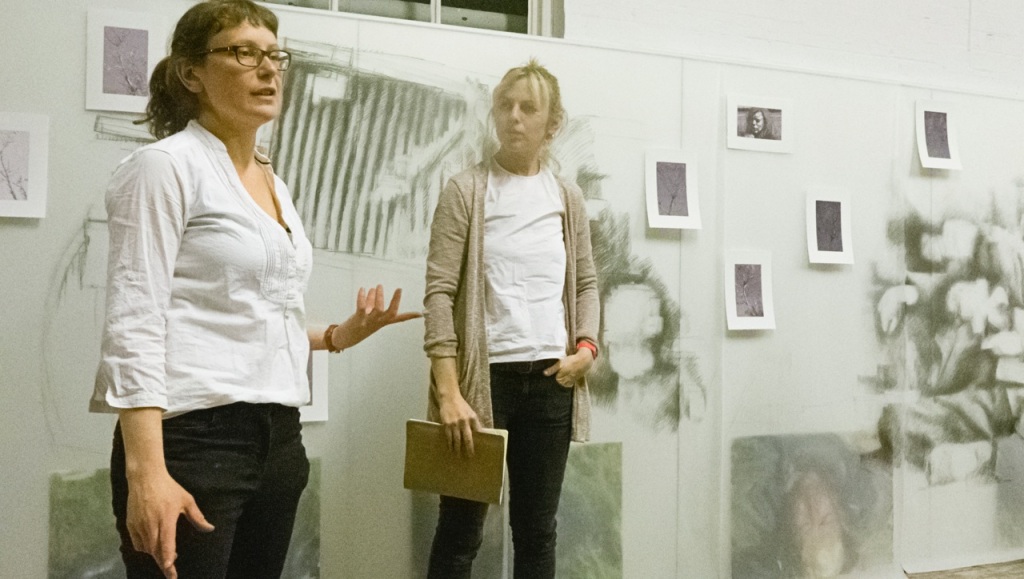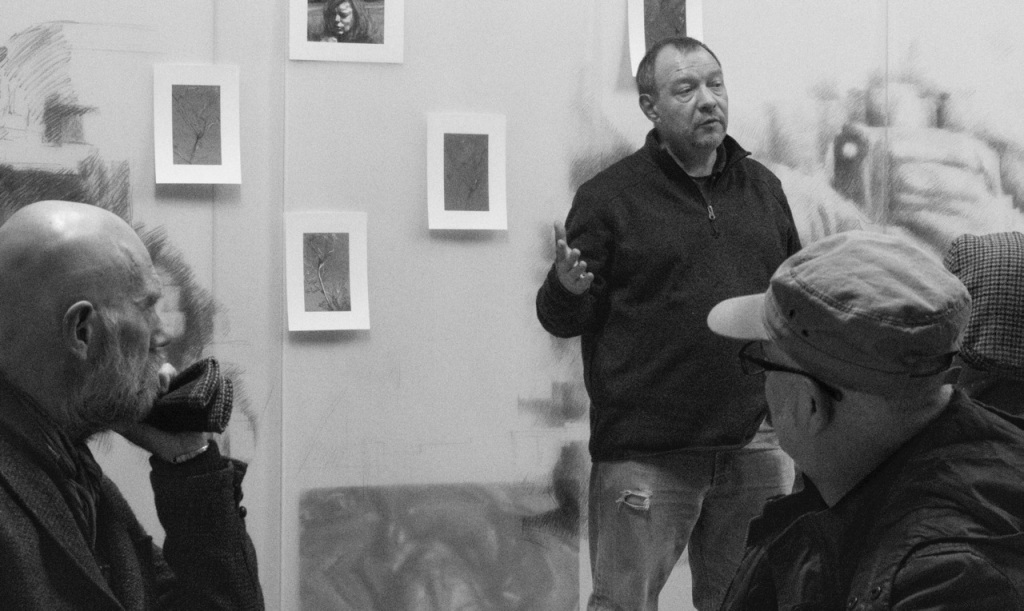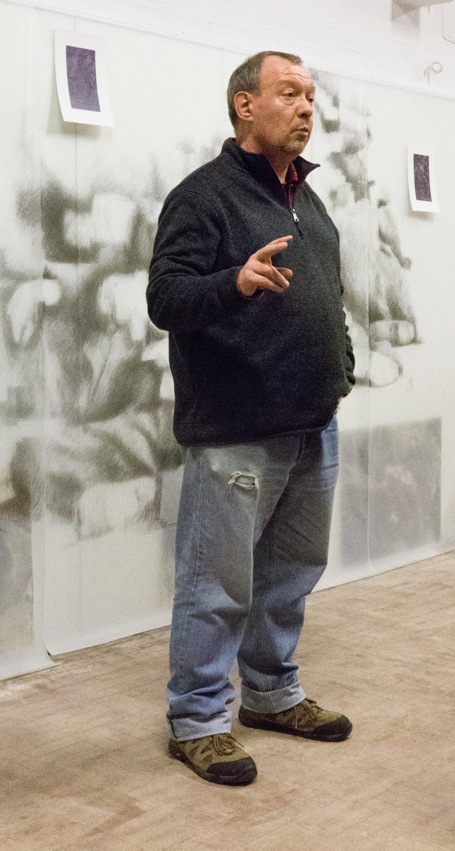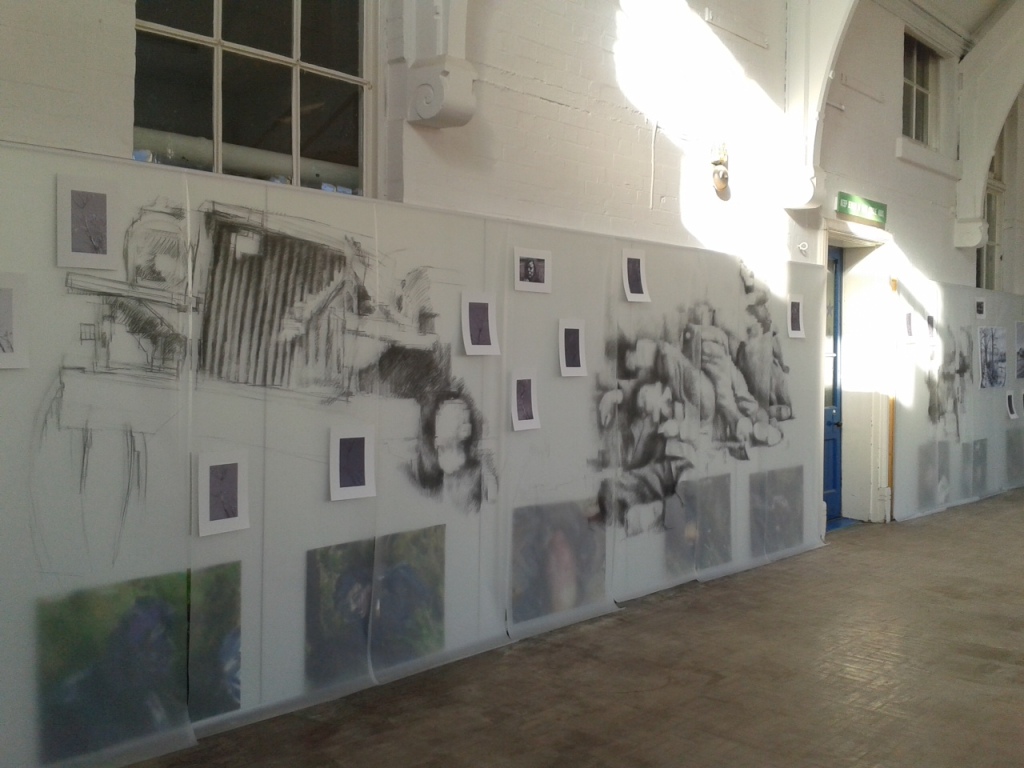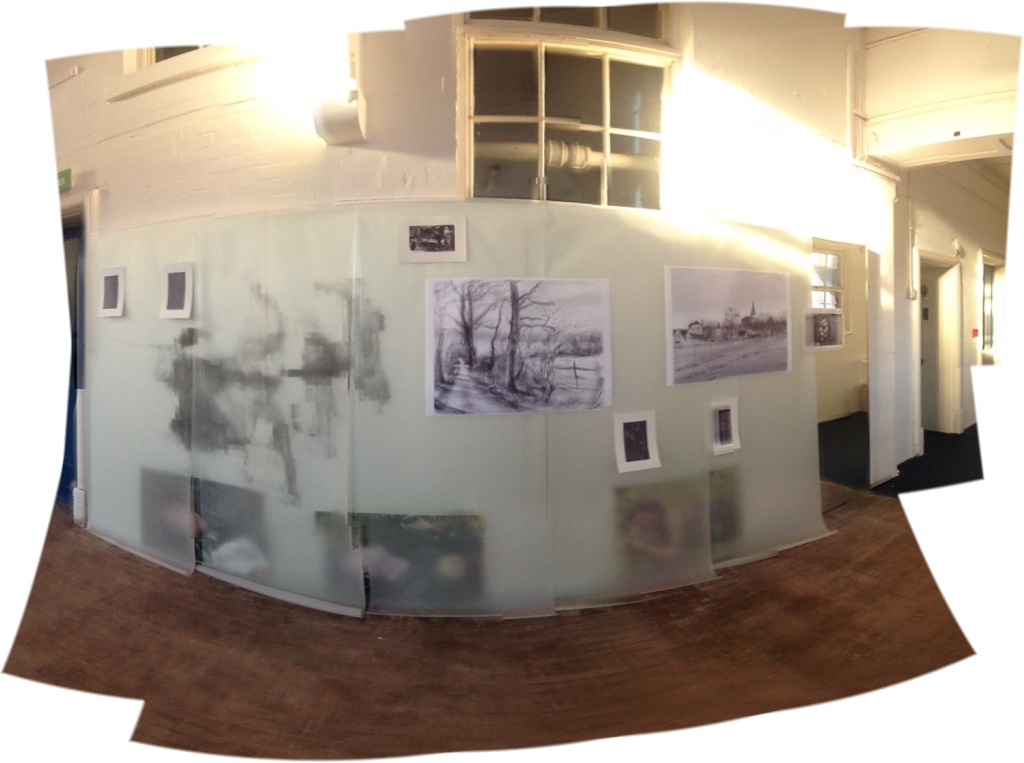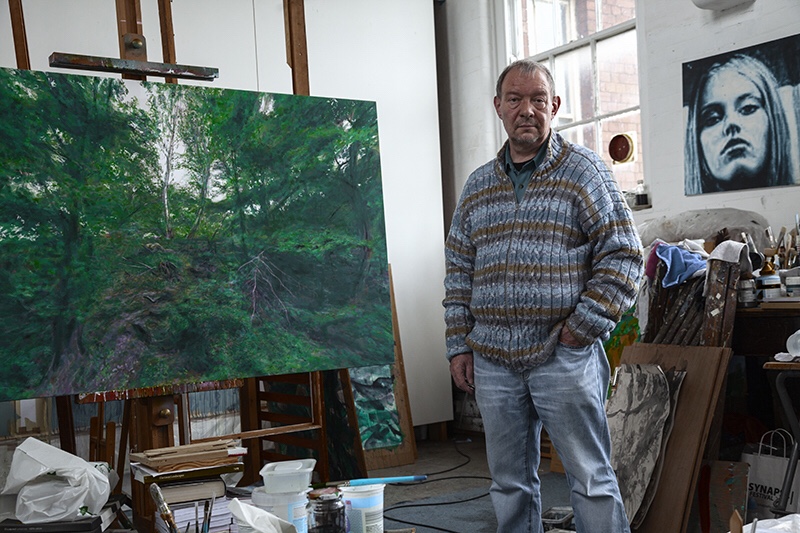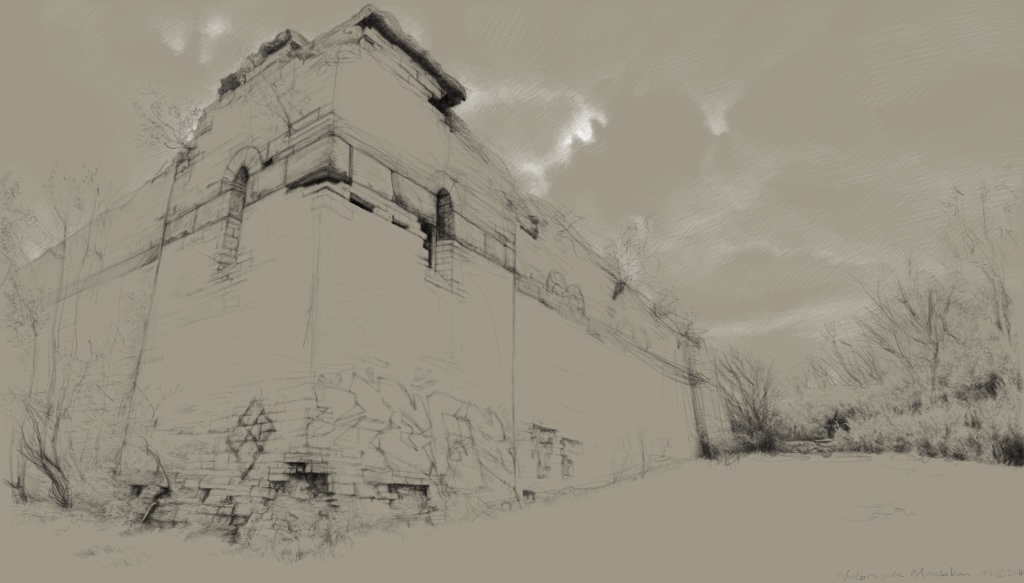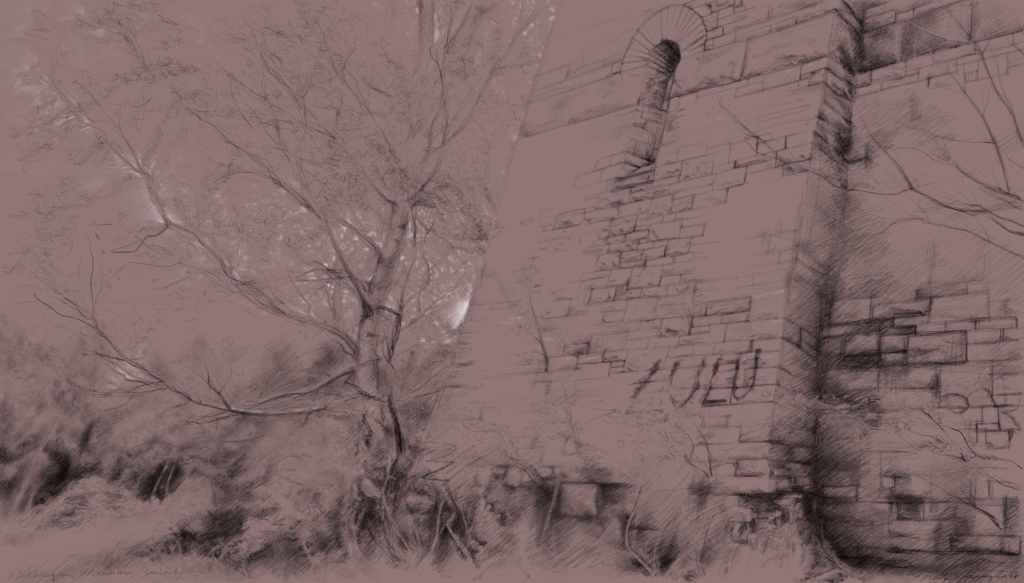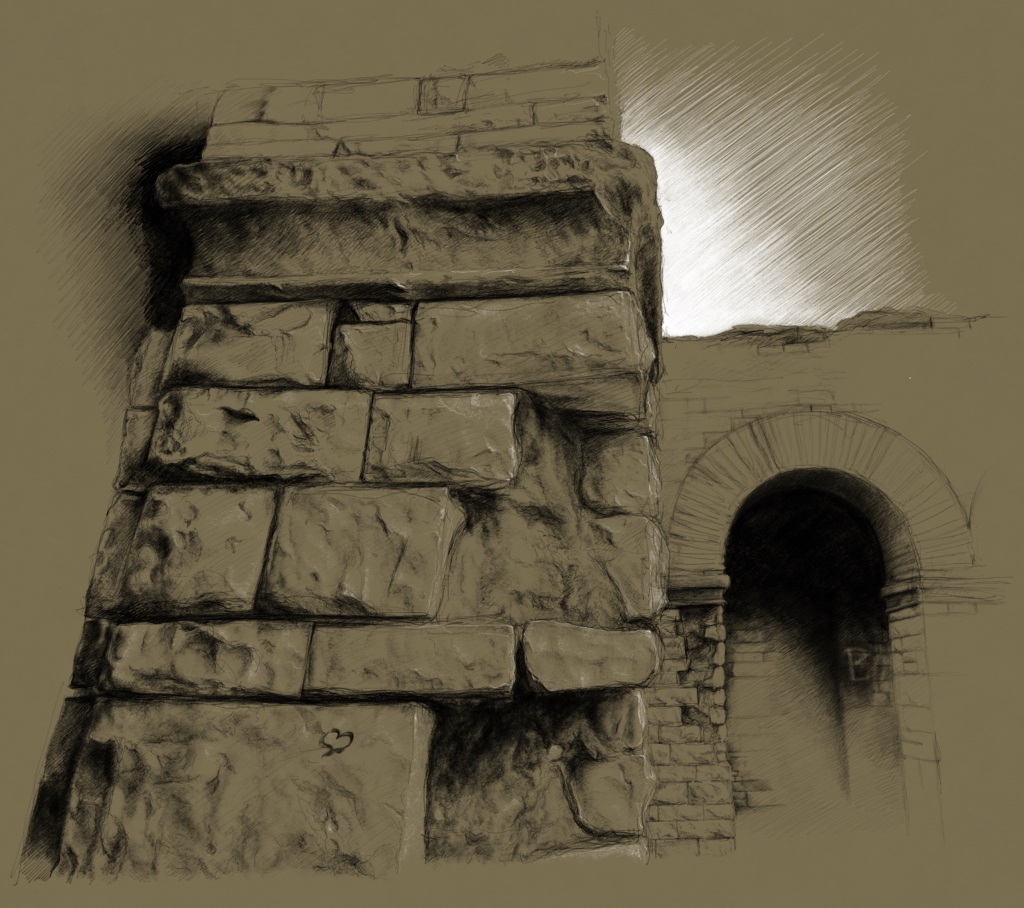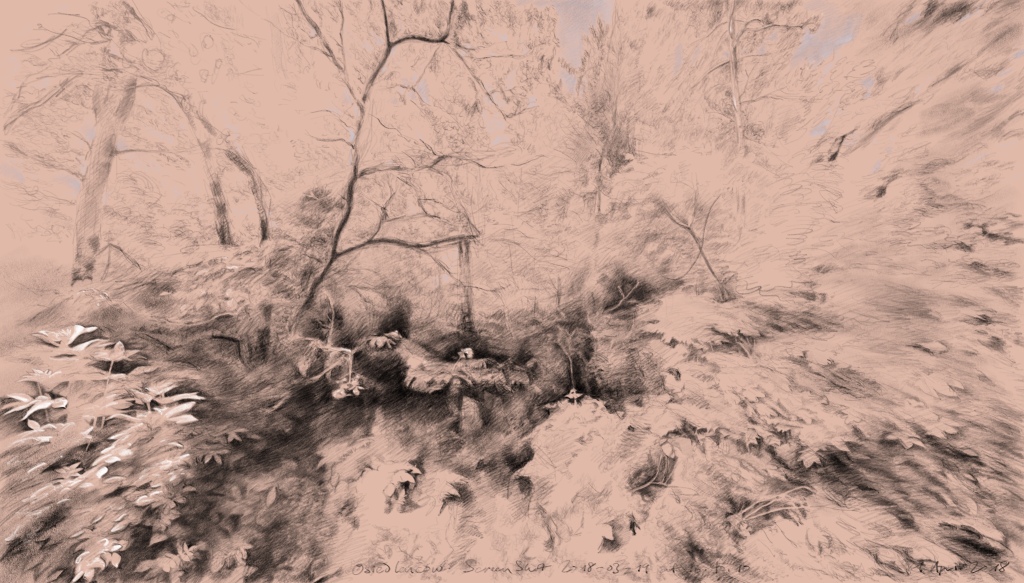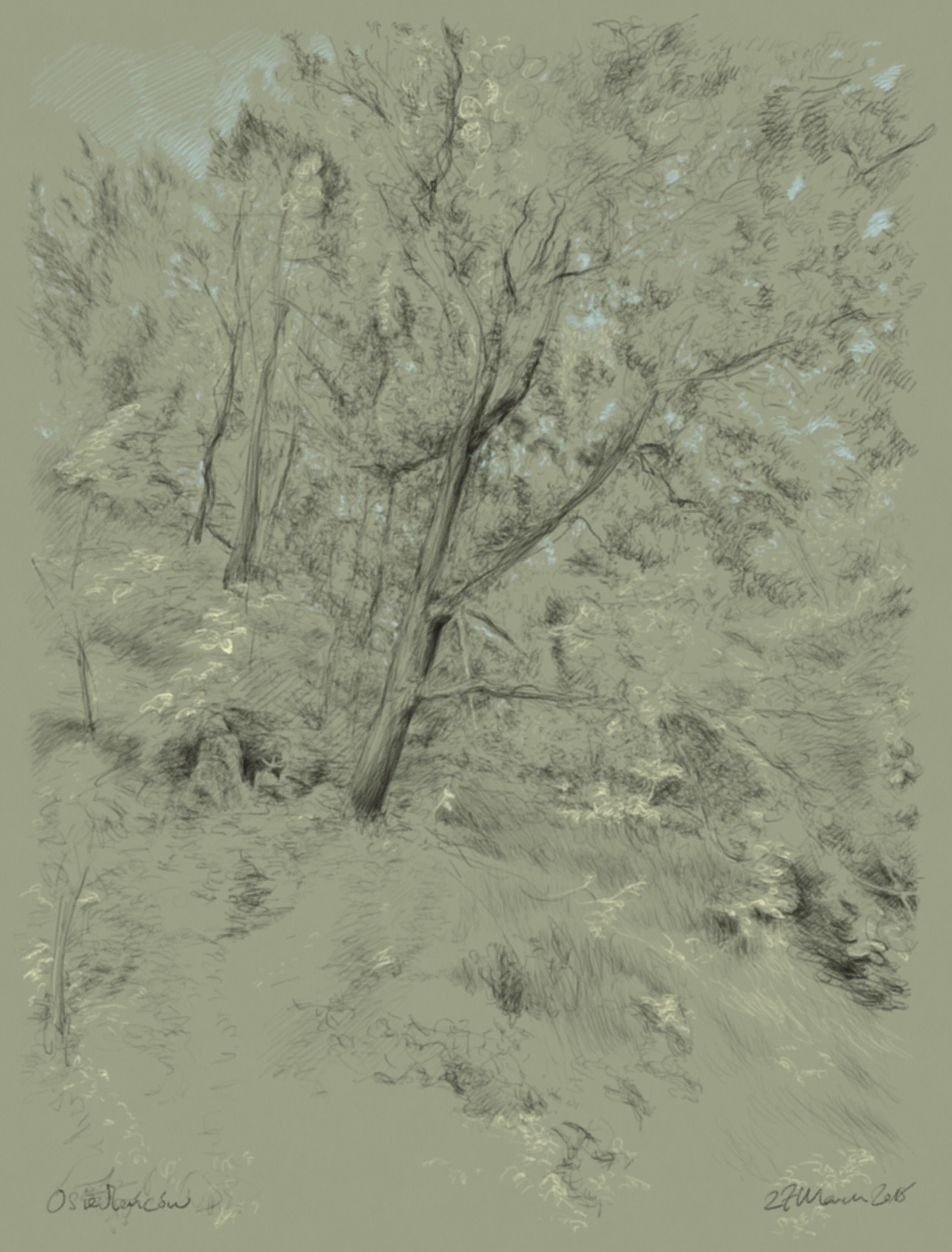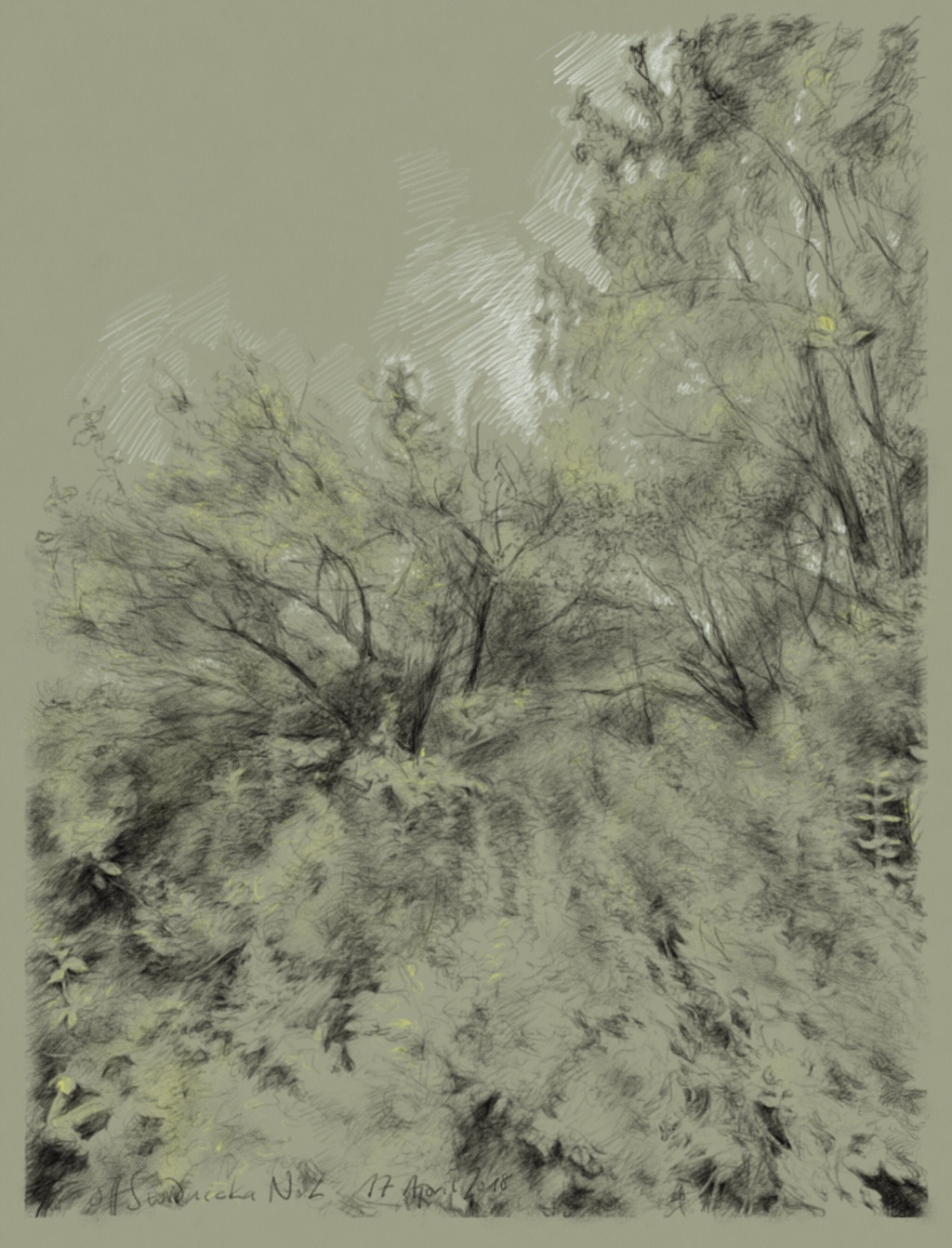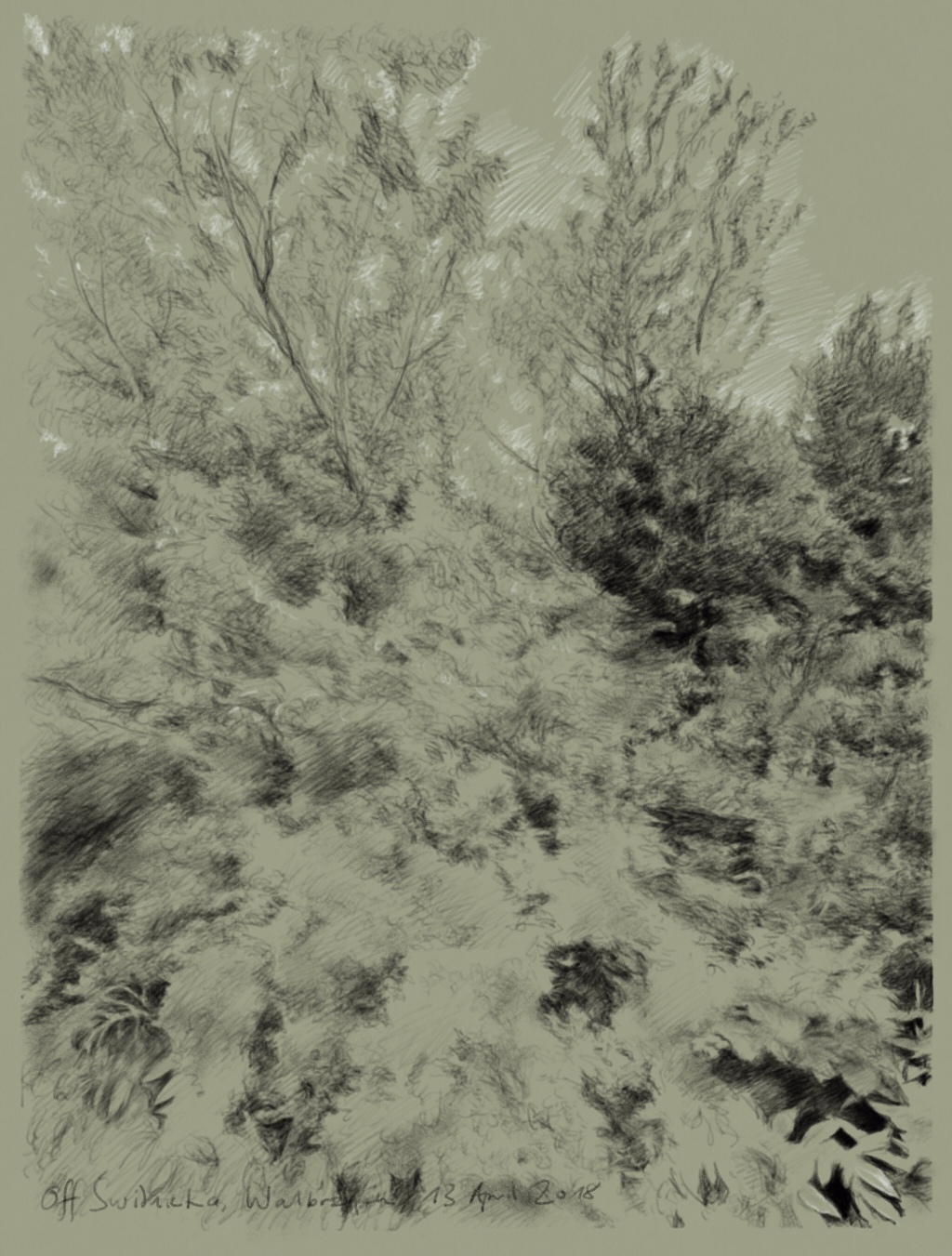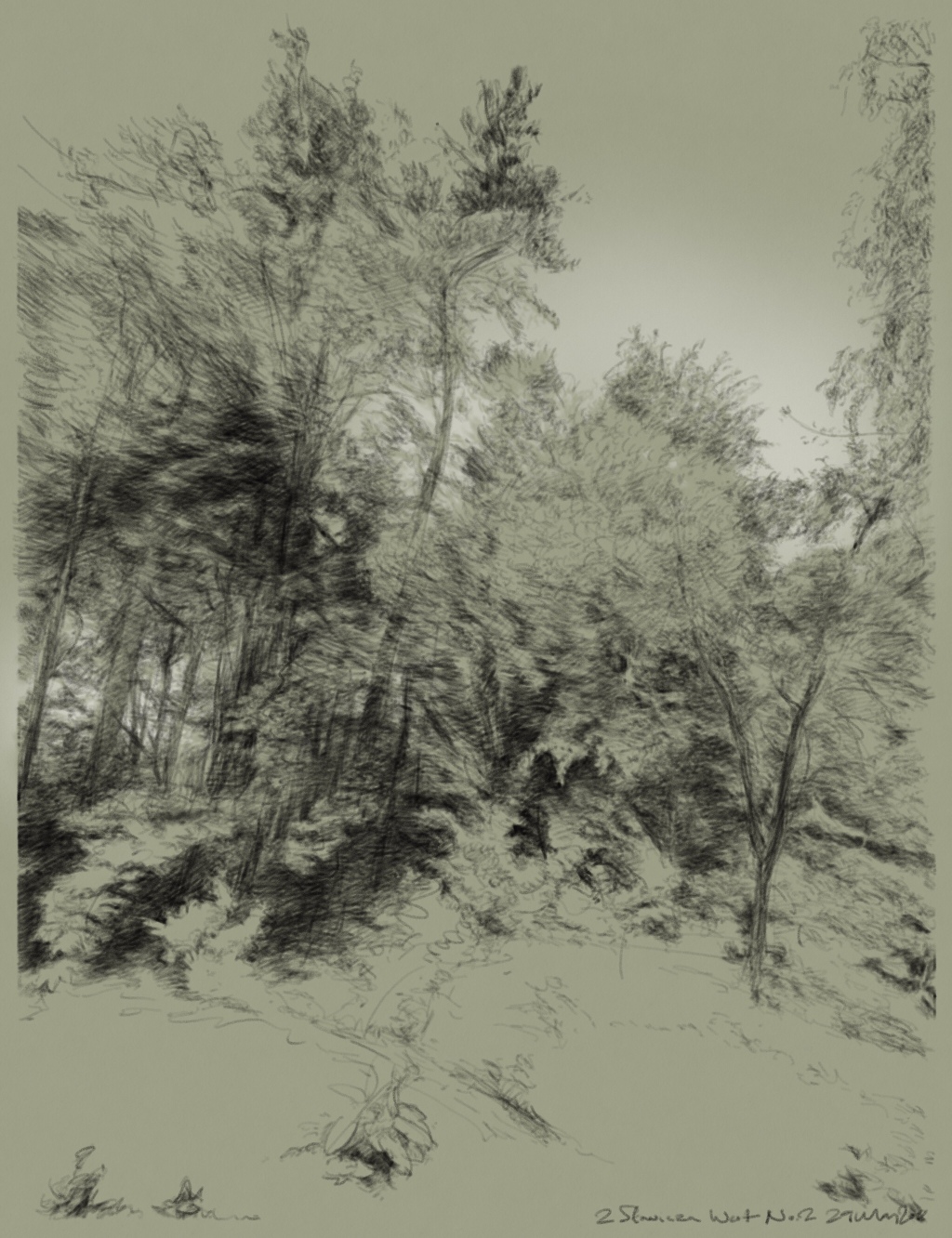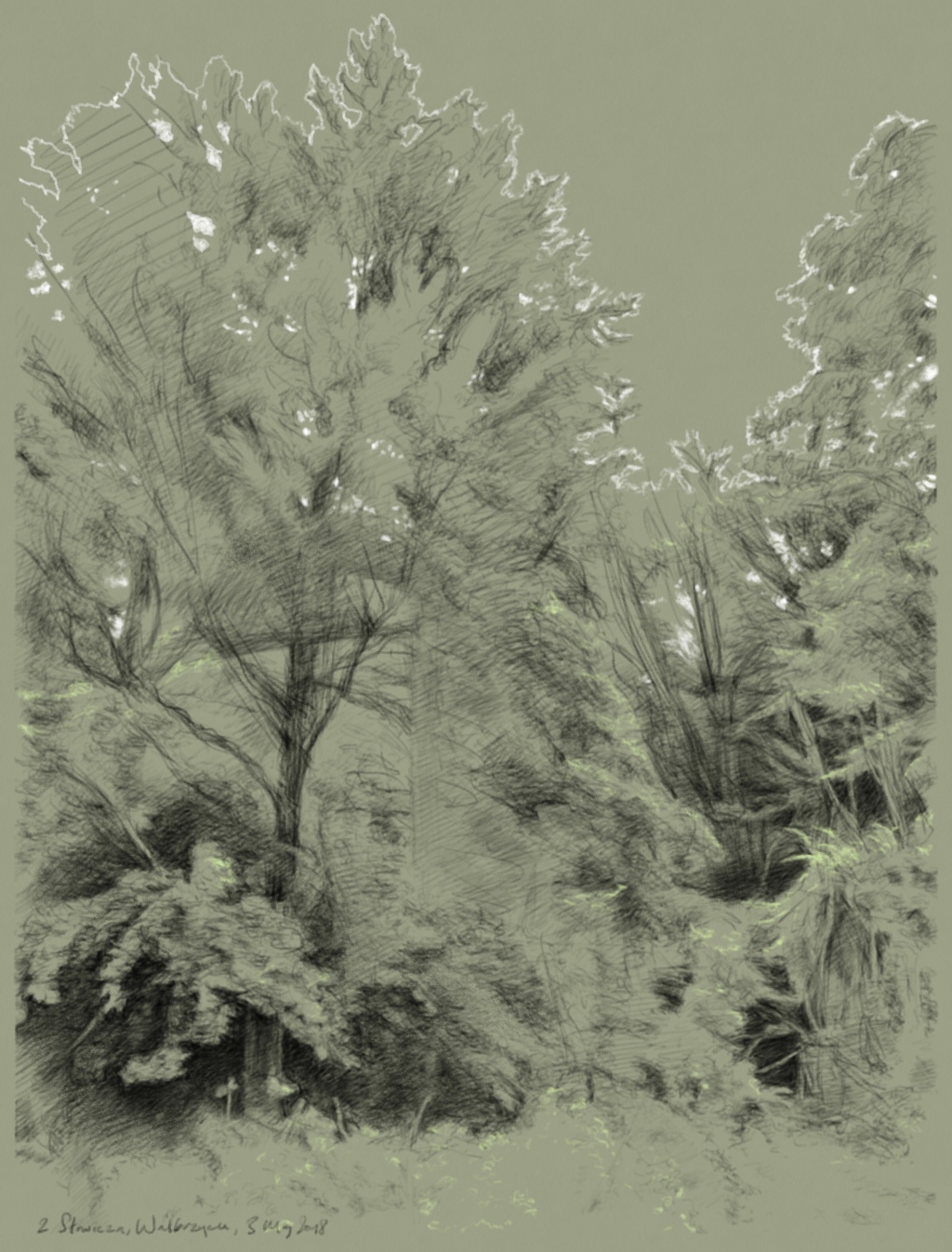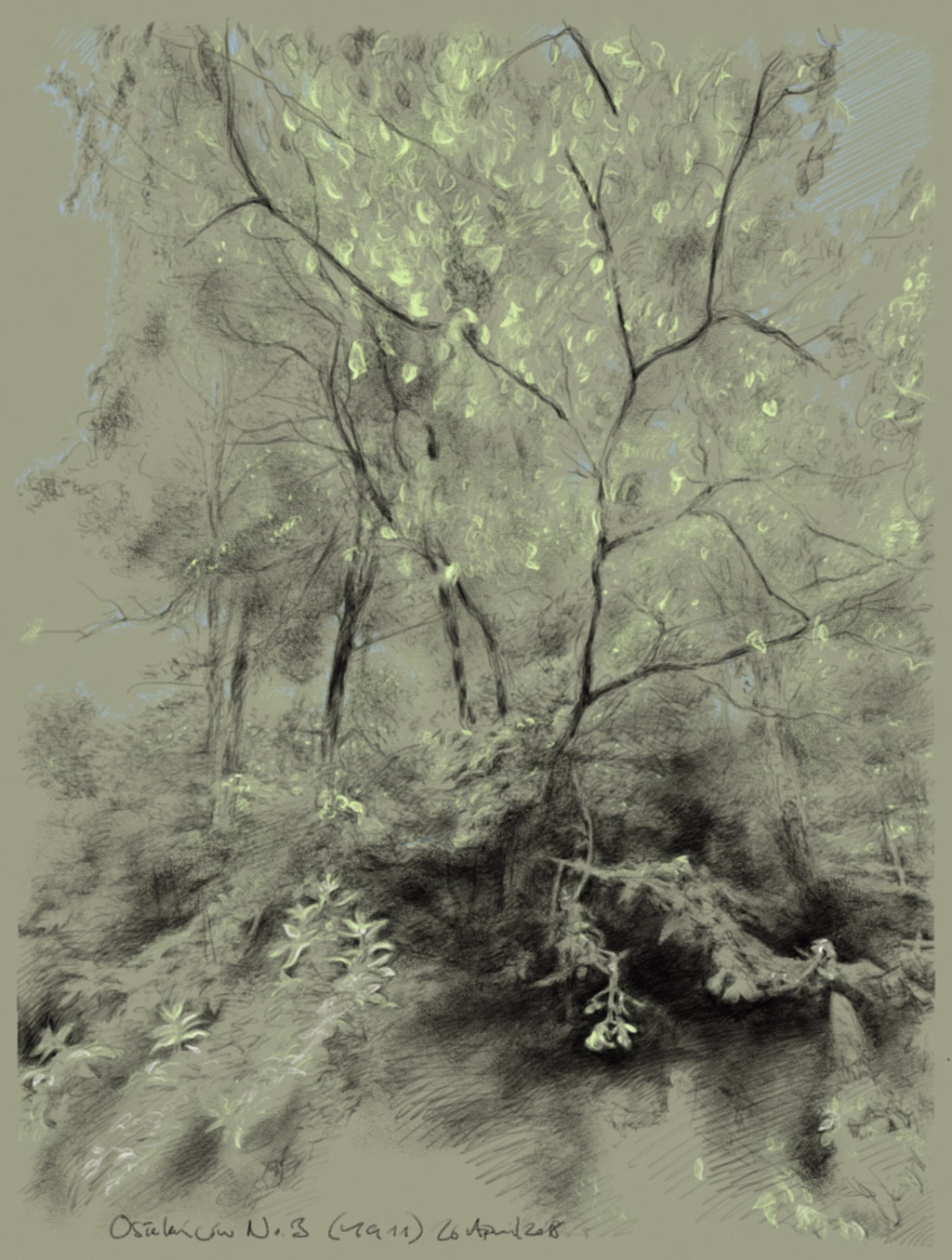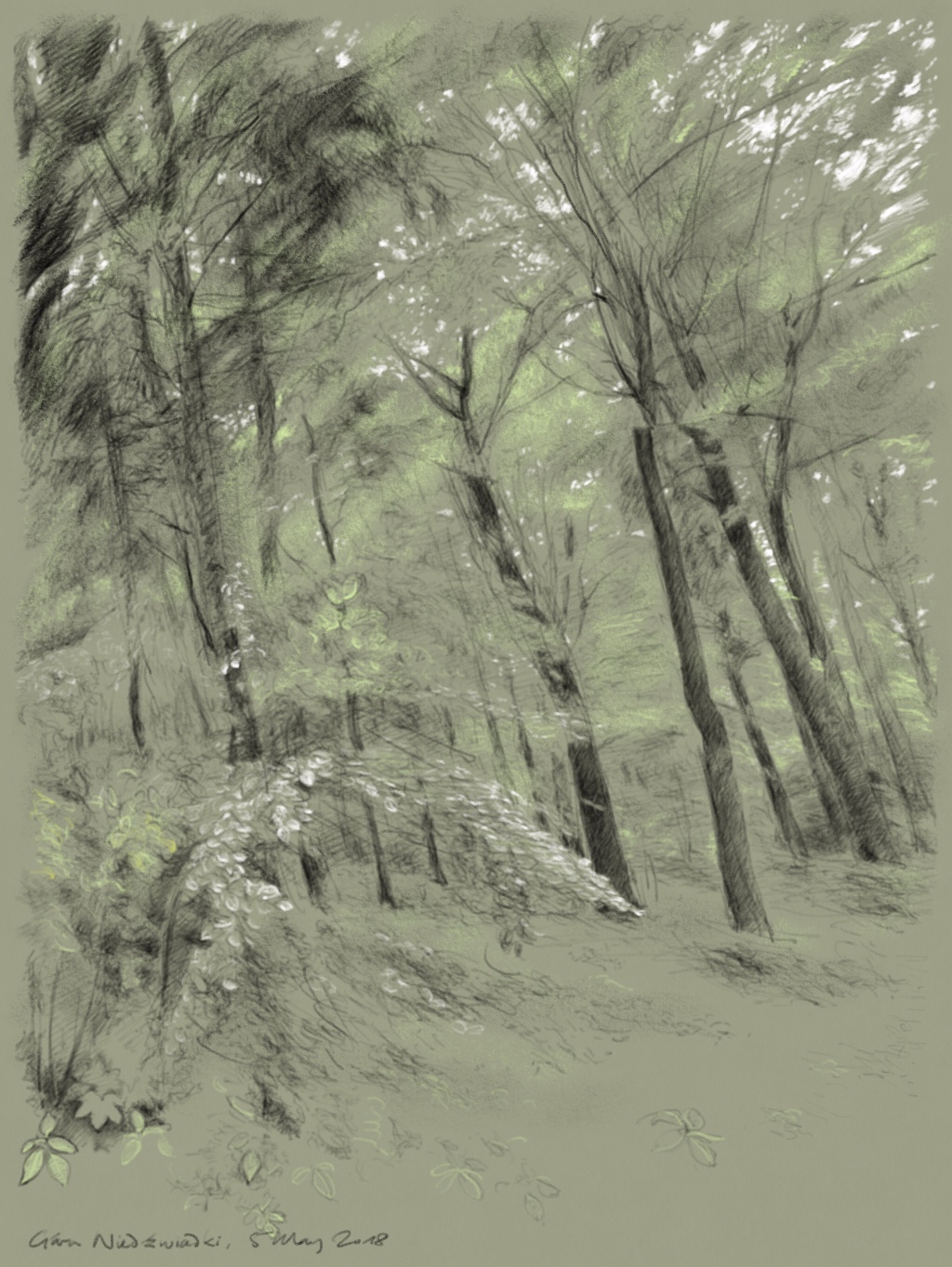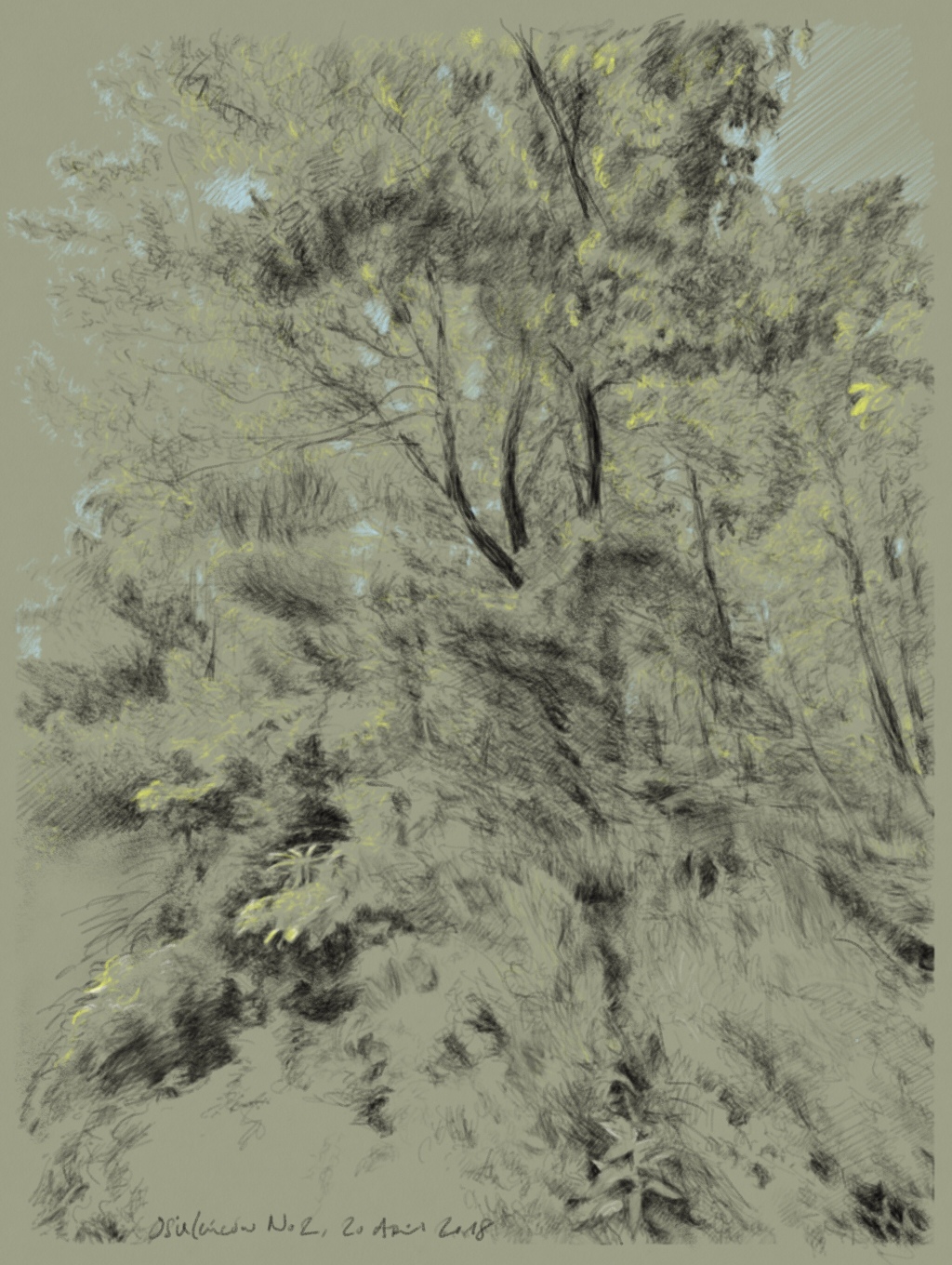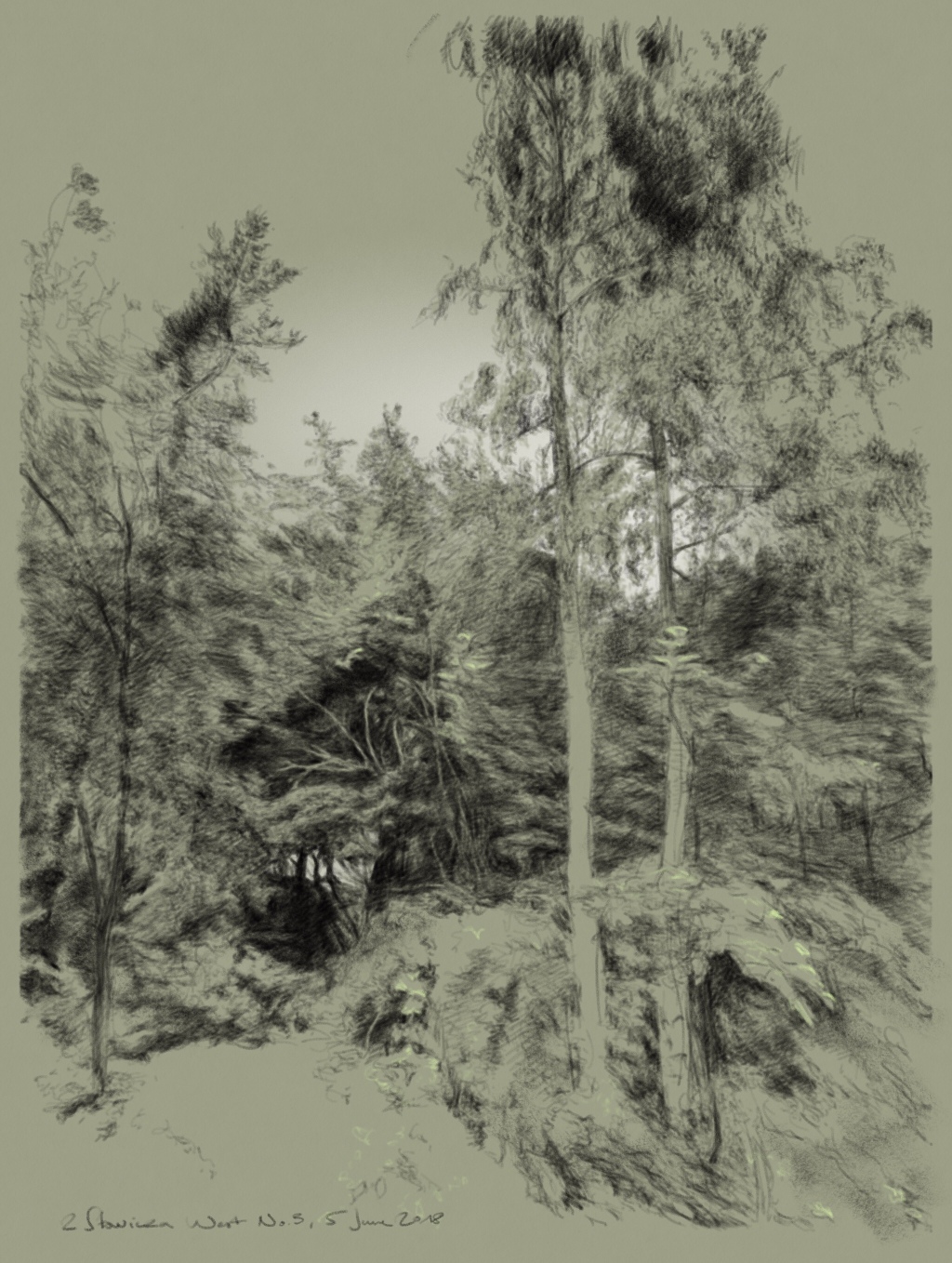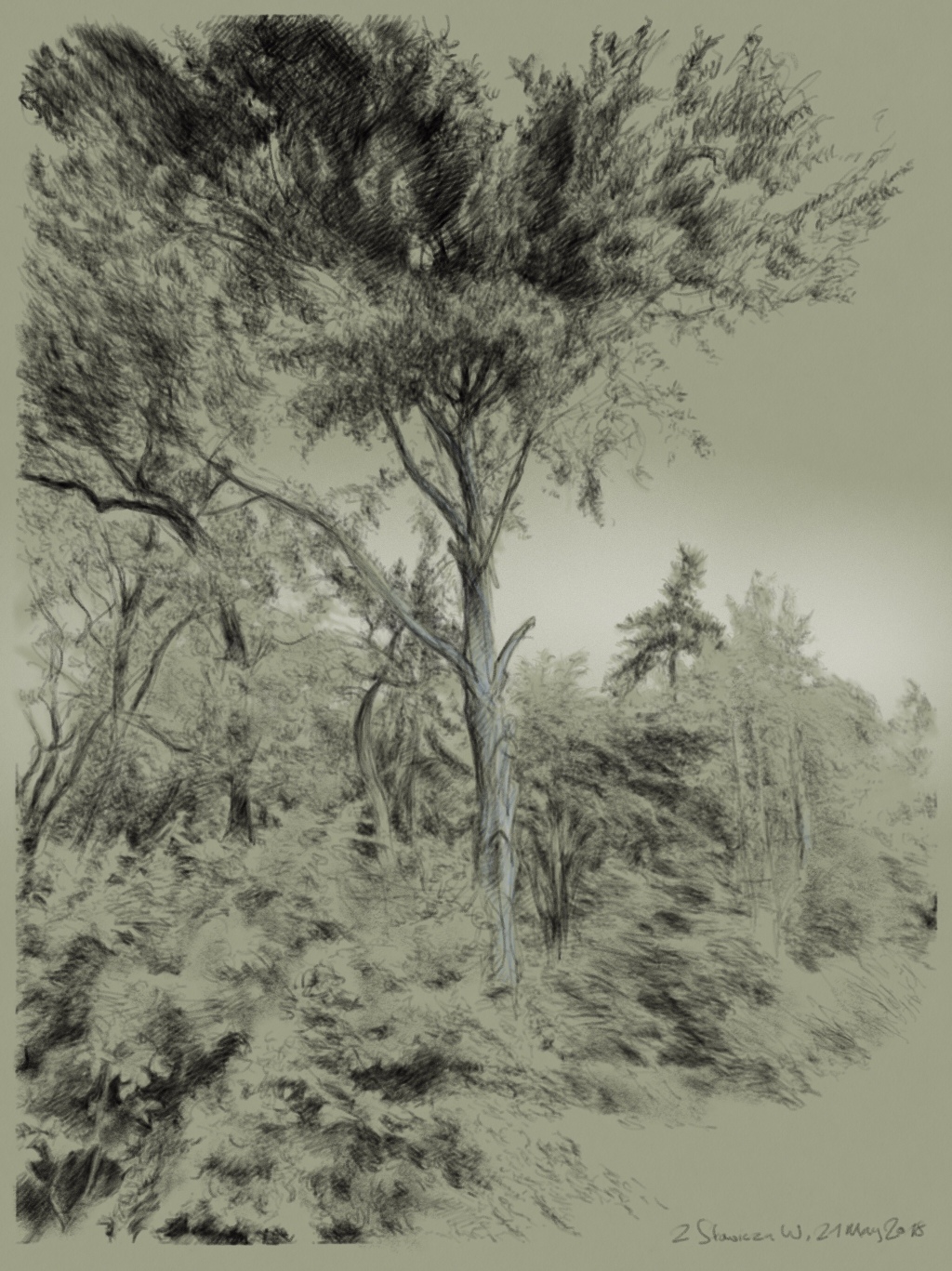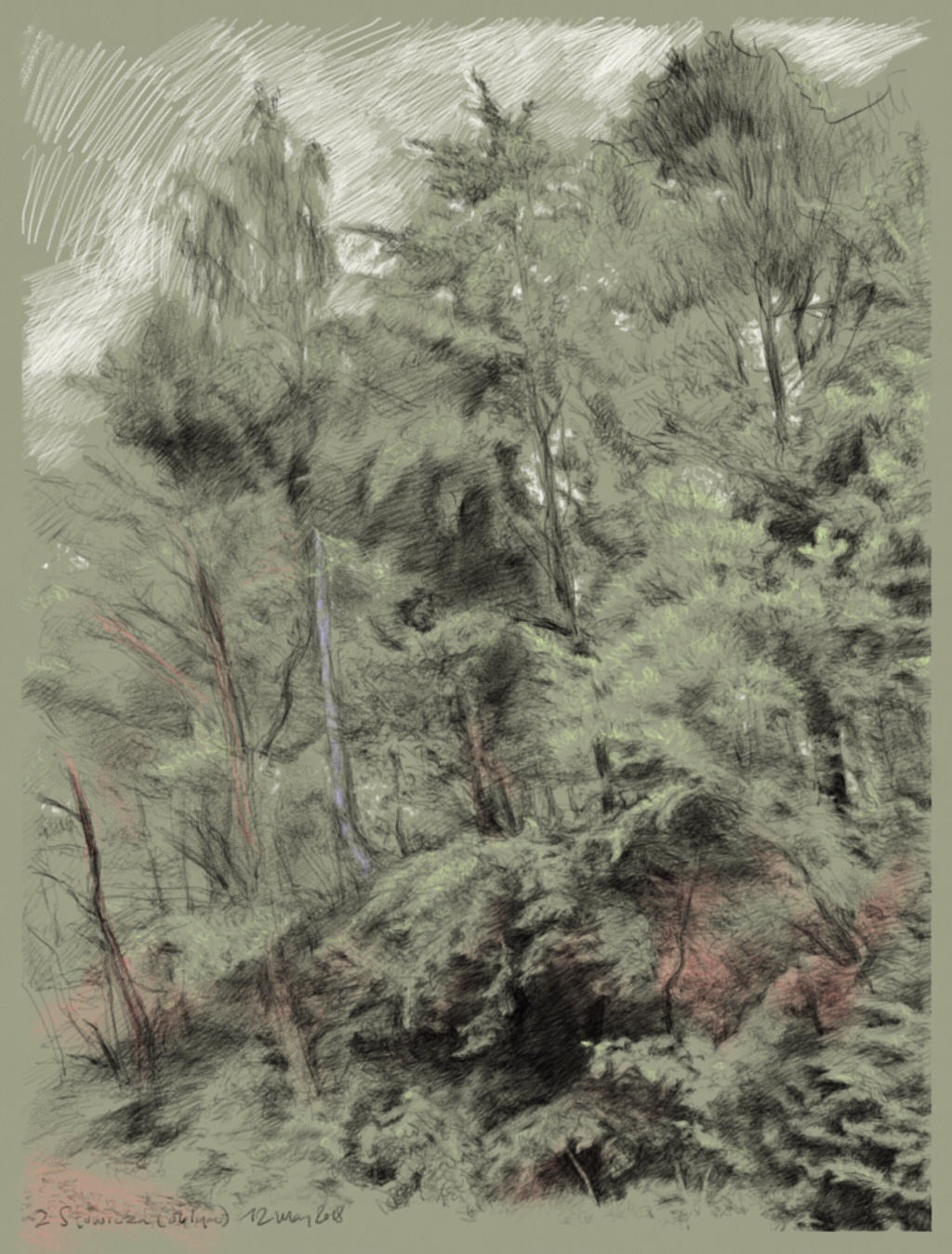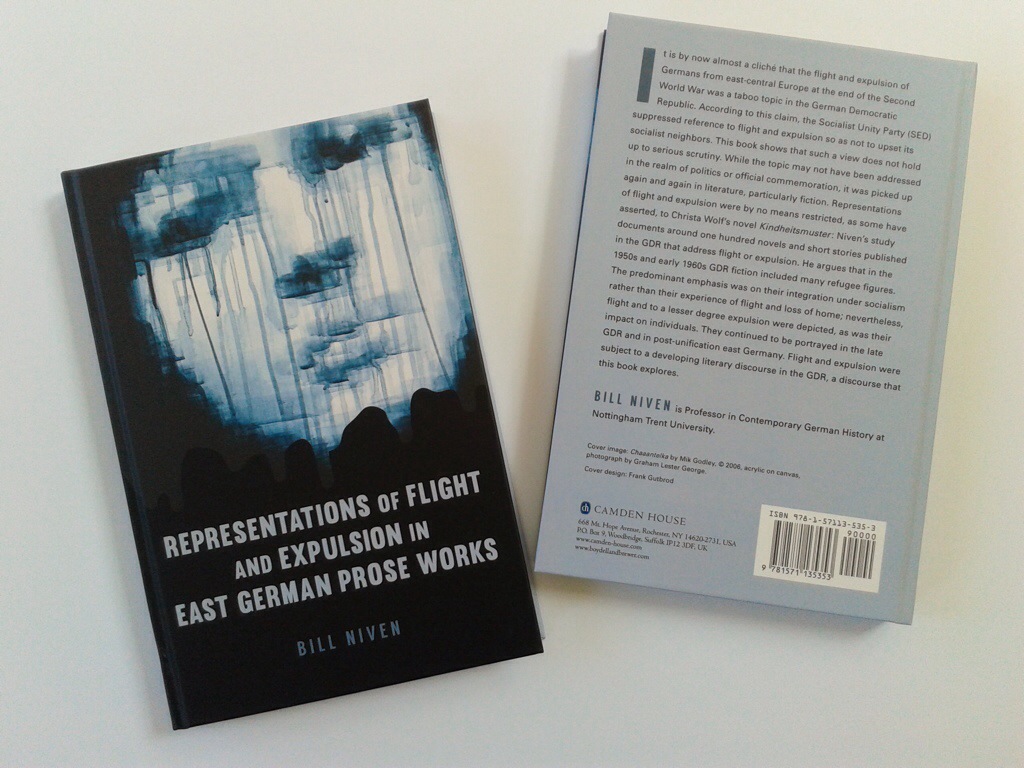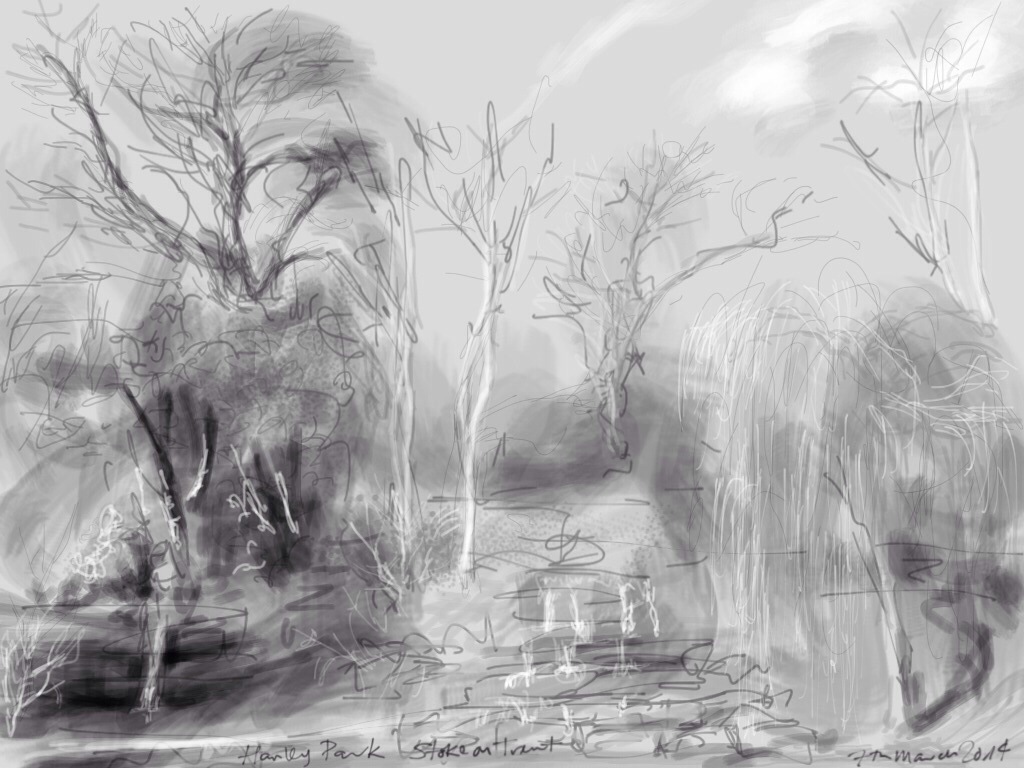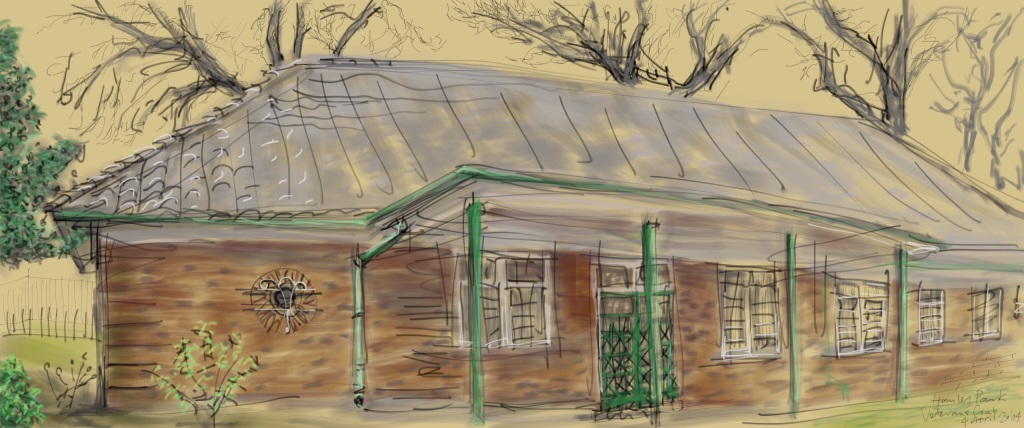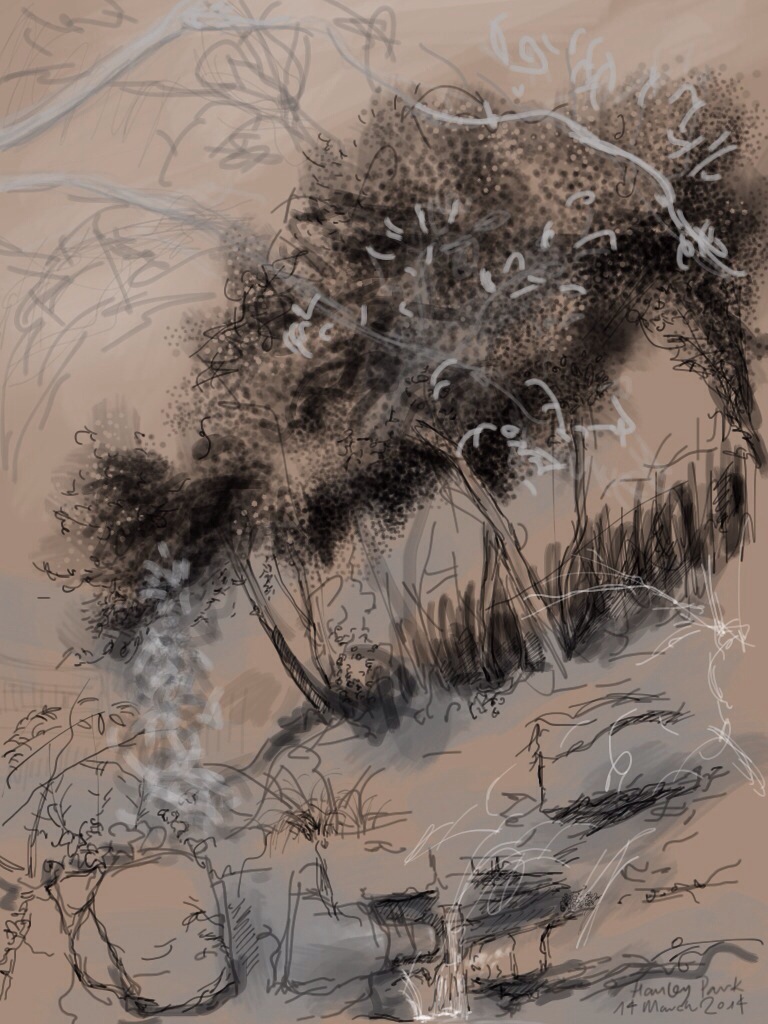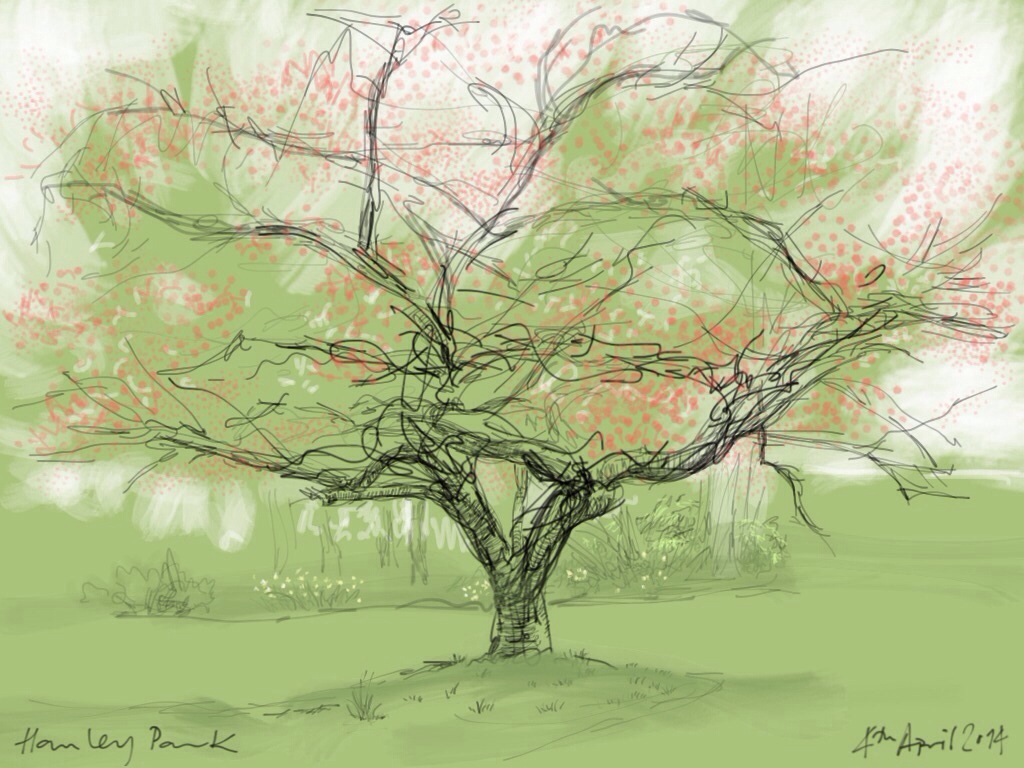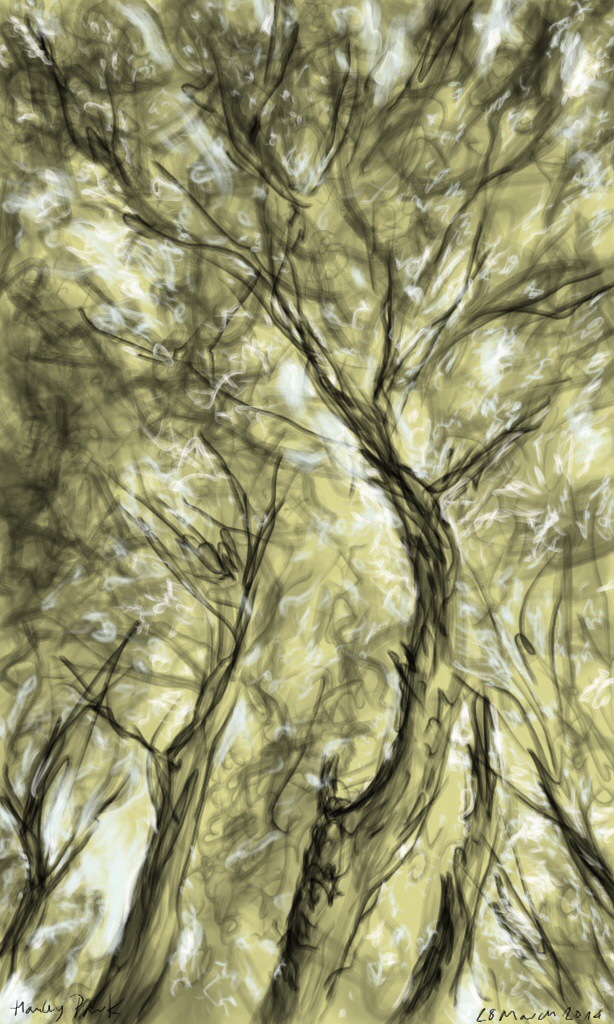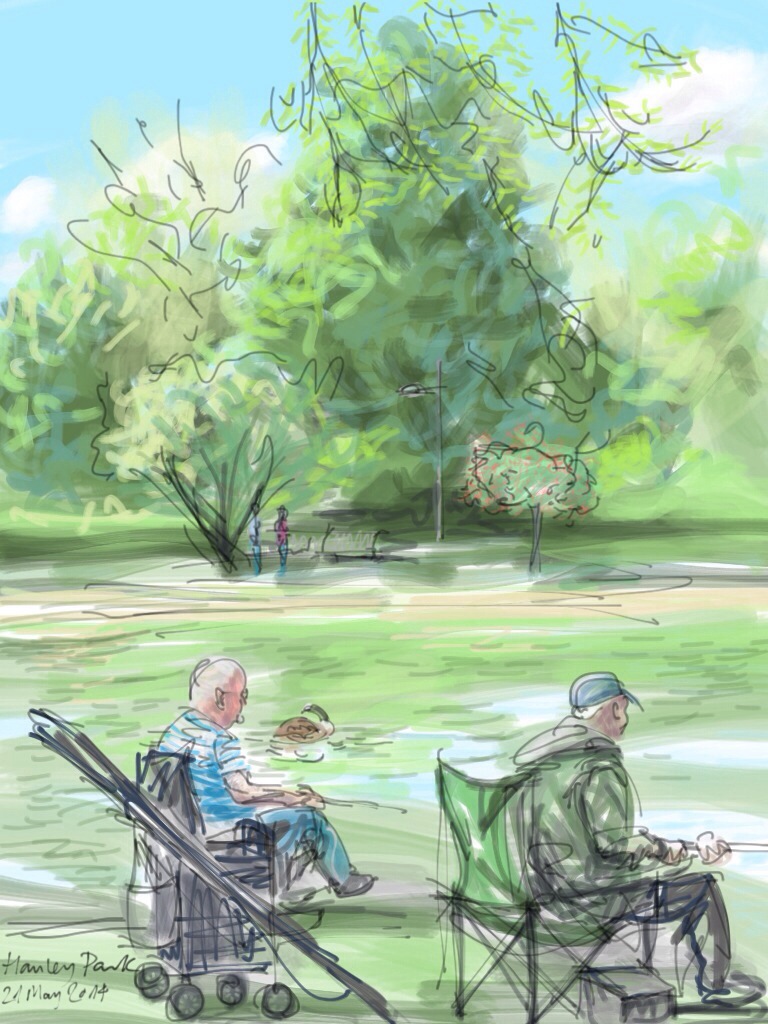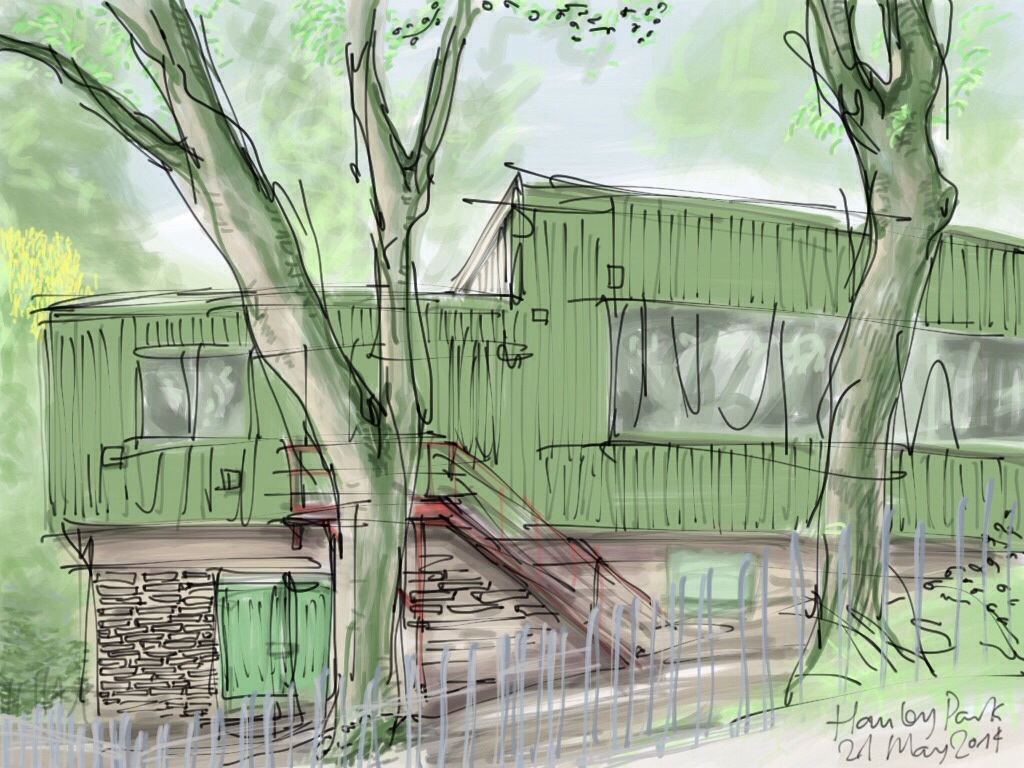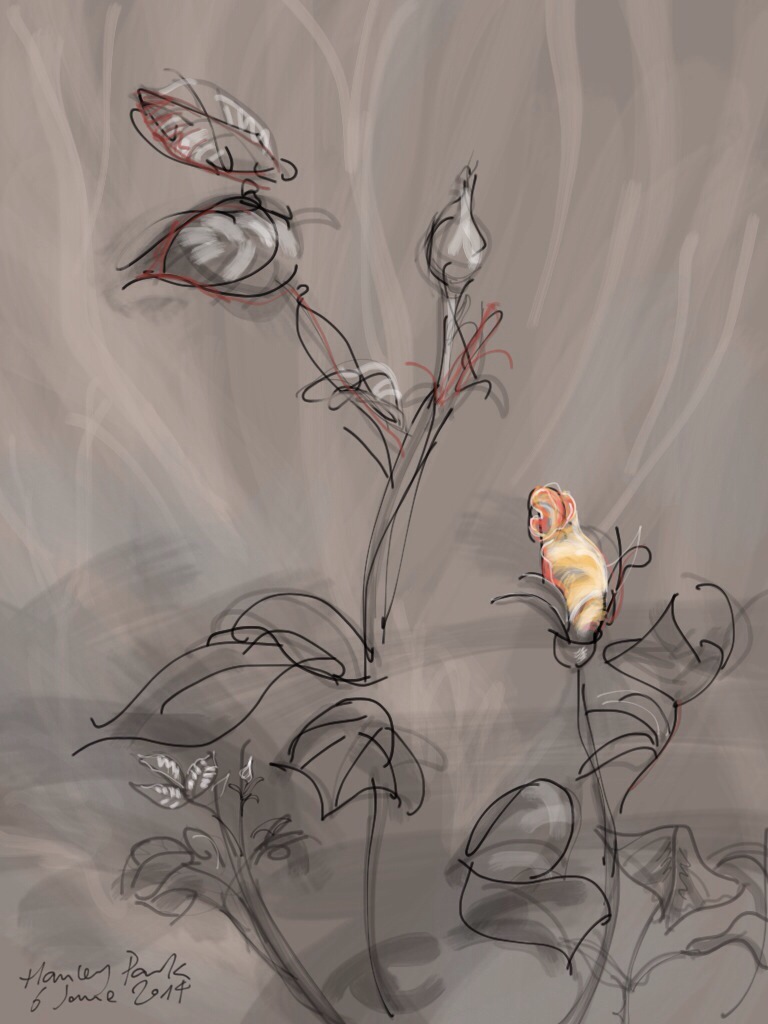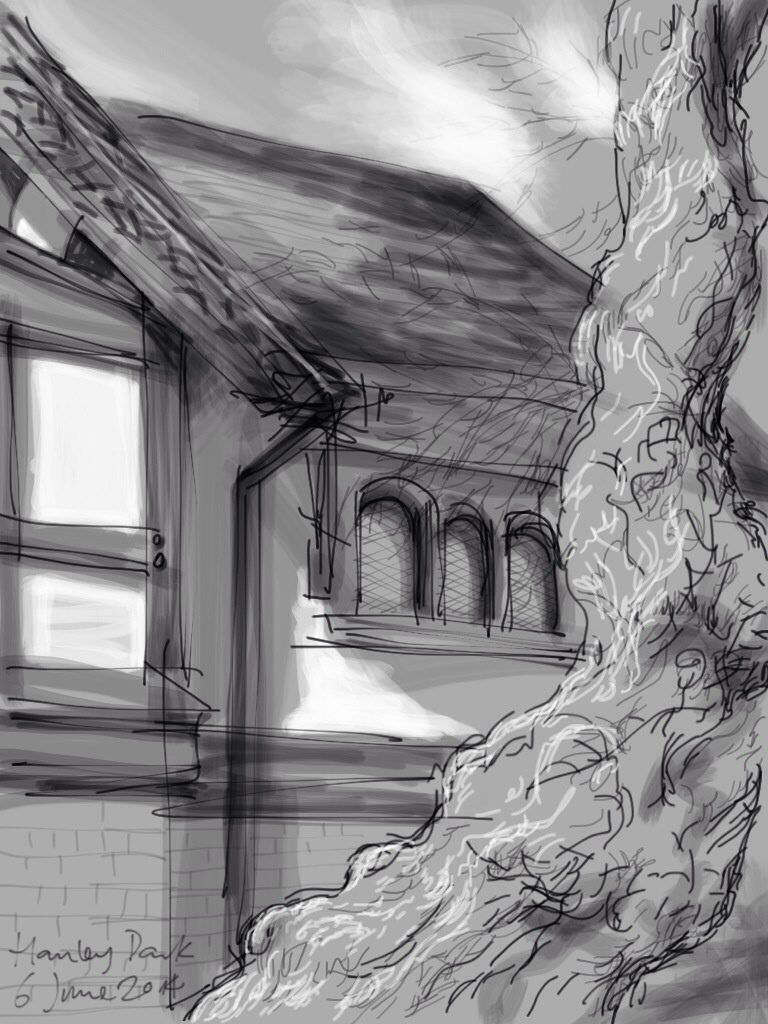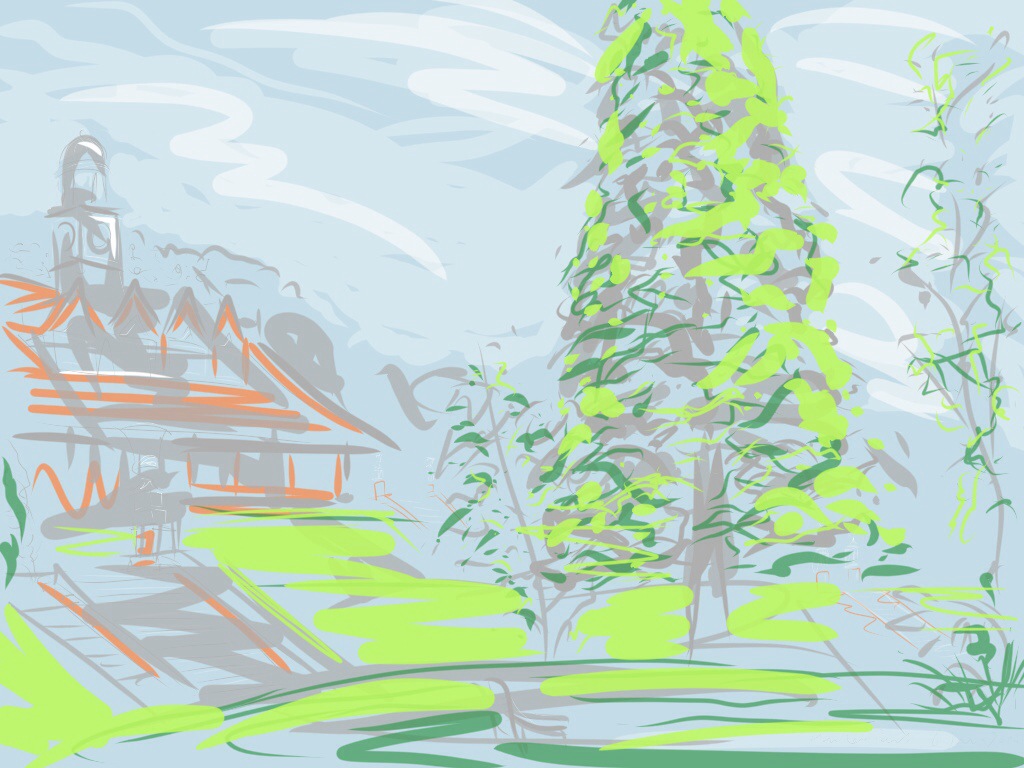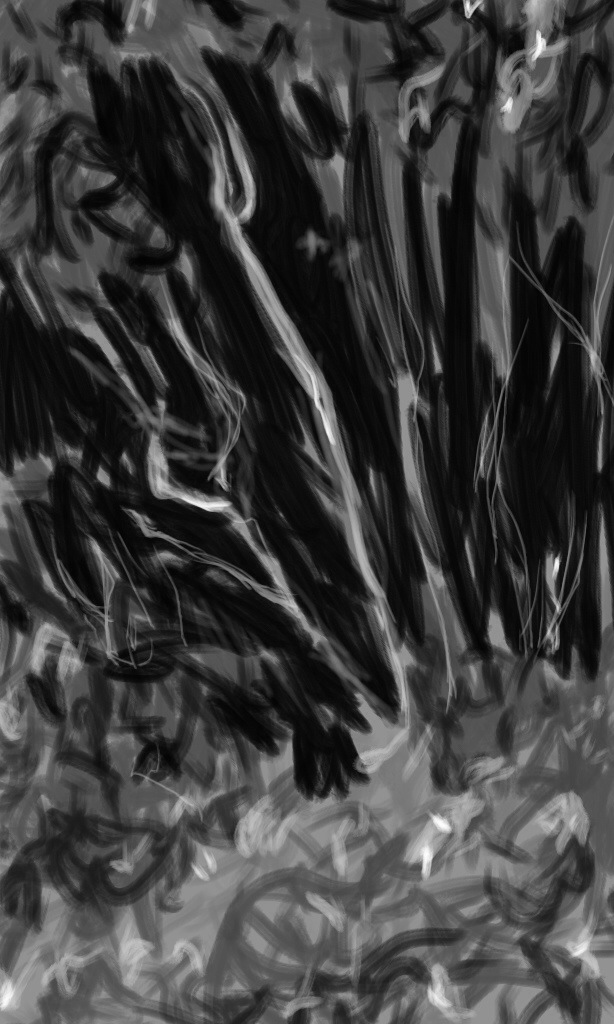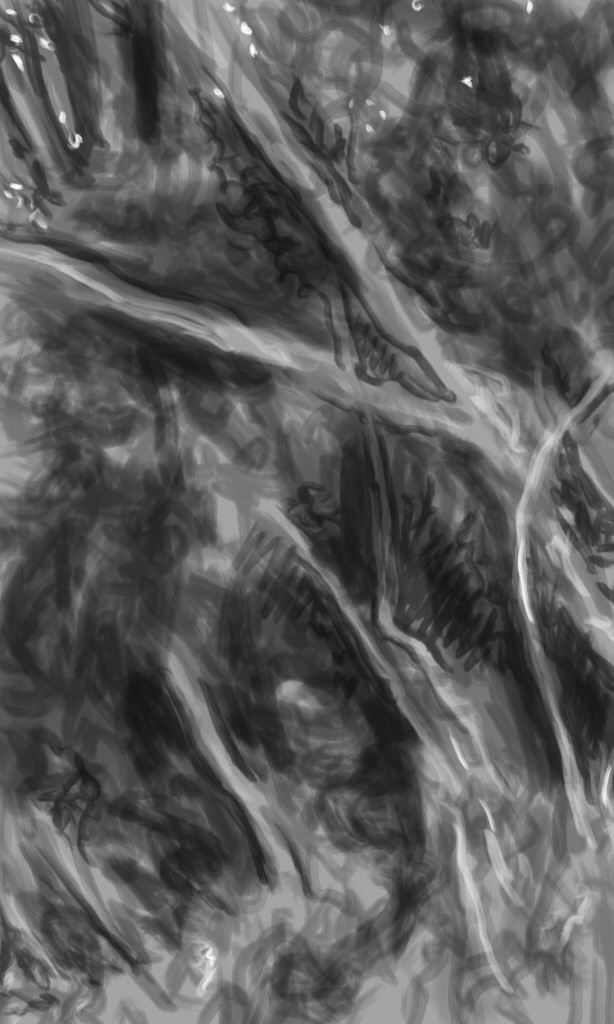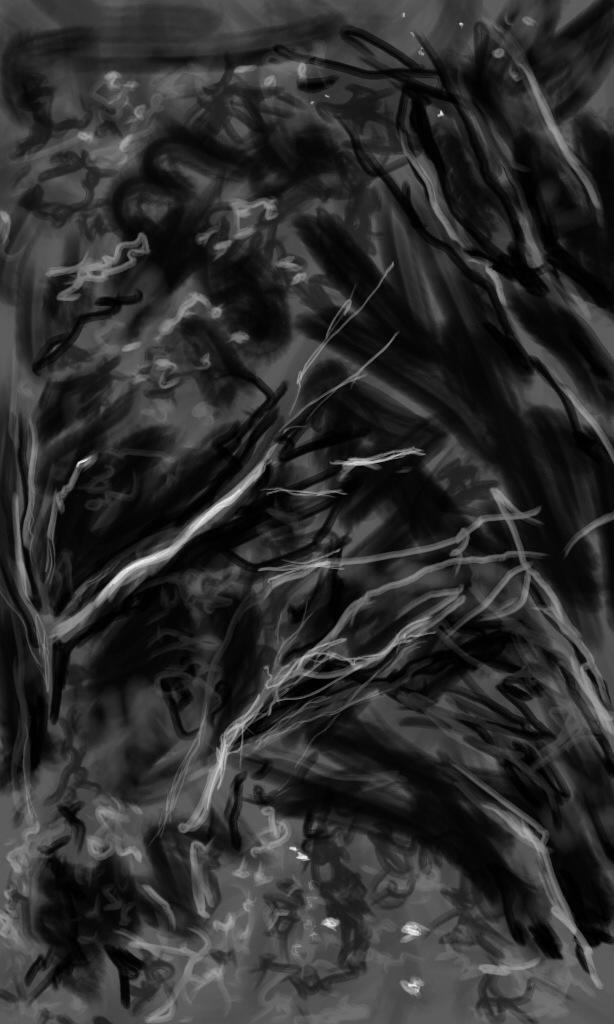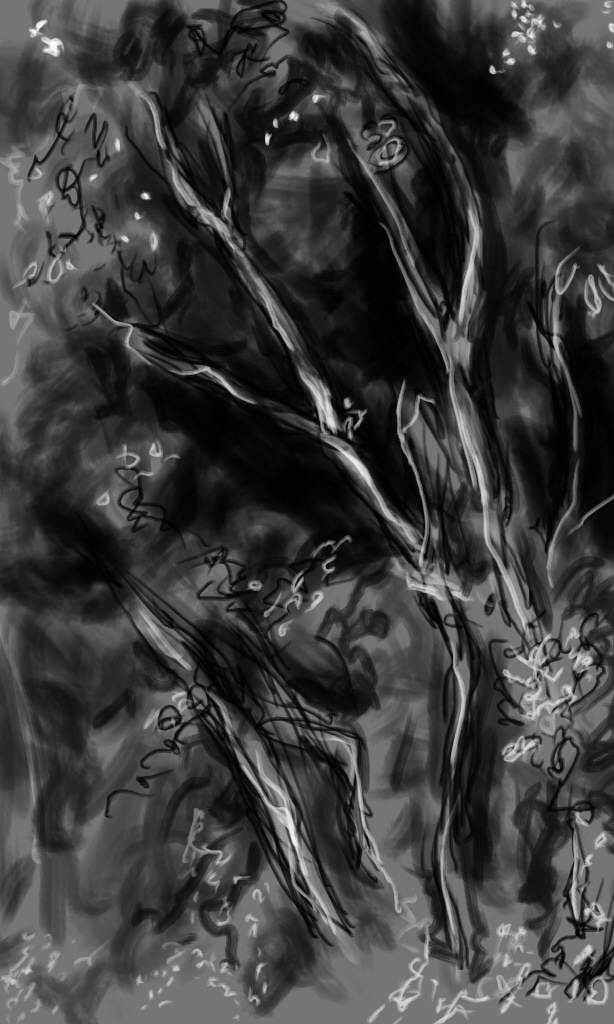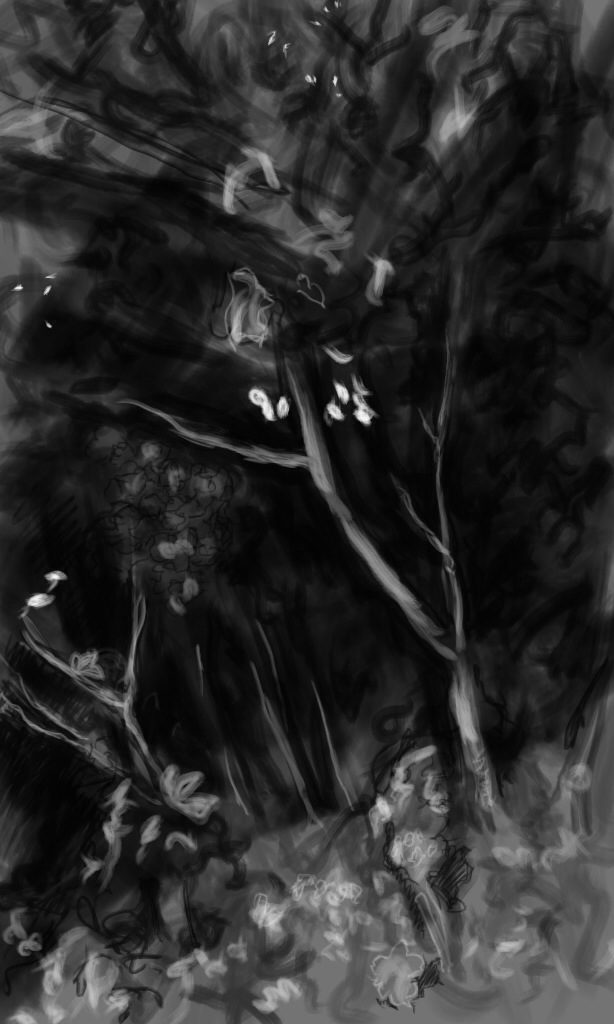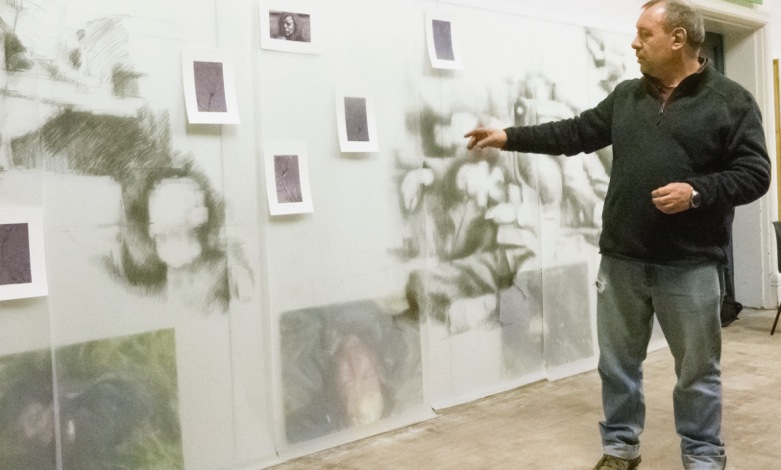mikgodley
Considering Silesia: a contemporary art project
The Death Castle search — Wałbrzych Mausoleum
Photo credit: Graham Lester George
Considering Silesia
“Who do you think you are?”
My personal and historical heritage project is approaching it’s fifteenth year, growing, evolving and offering new possibilities and more aspects to research. I’ve now been investigating the Wałbrzych Mausoleum (1) since 2012 when Michał Wicher, an architectural heritage enthusiast based in nearby Wrocłow, asked me to look at it and I decided to create a visual interpretation from discoveries online — perhaps as a kind of remote digital archeology. The Attenborough Arts Centre of Leicester University have asked to exhibit this in their newly built gallery in 2020.
I thought that investigating the mausoleum — or its online manifestation — acted as a visual metaphor and focus for several layers of experience and questioning. This process grew out of my family connections with Germany, England and Europe that started in the 1960’s. History: personal; family; conflicts of culture and heritage; the idea of ‘forgetting’ “Don’t mention the war”; an interest in propaganda — both historical and contemporary; and new forms of fascism — whether political or corporate, and the qualities of how we learn, see and process both digital information and fictions. Although there is no official information online, images of the much graffitied 1930’s ruin pointed it to being a document recording a century of European history through a piece of architectural propaganda.
NB. Dimensions vary for digital work
Wałbrzych Mausoleum, via Google Sphere View, 11 February 2018 (miss-dated), app Procreate on iPad Pro
Wałbrzych Mausoleum (Lulu #1), via Google Sphere View, 29 January 2018 (miss-dated), app Procreate on iPad Pro
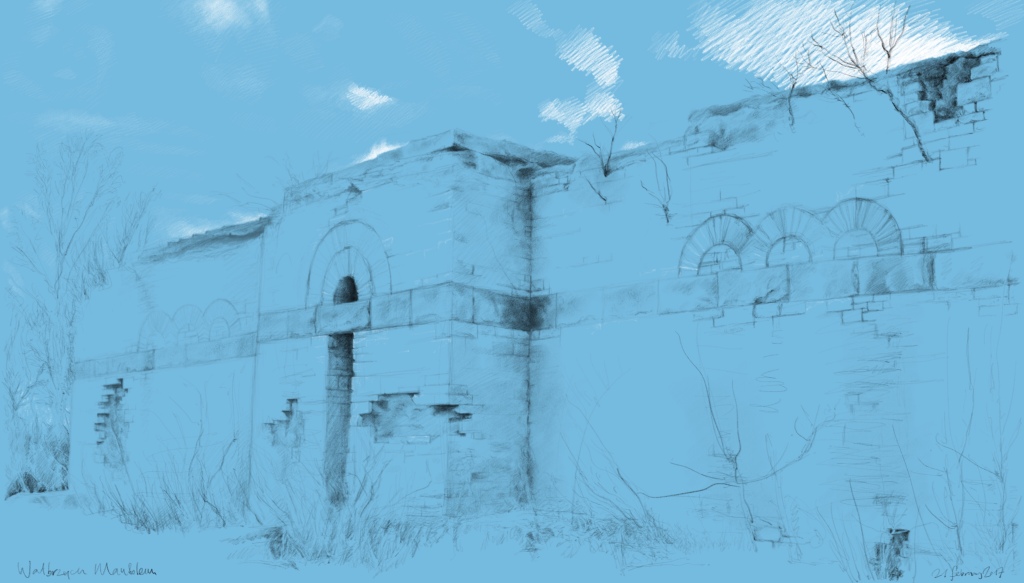
Wałbrzych Mausoleum via Google Sphere View, 21 February 2018 (miss-dated), app Procreate on iPad Pro
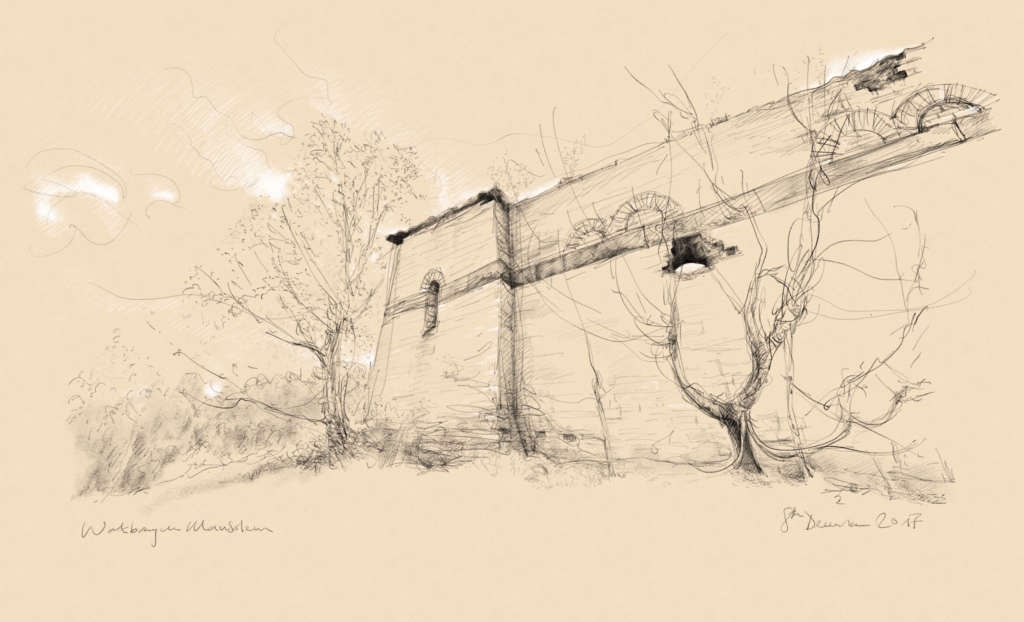
Wałbrzych Mausoleum (Waldenburg Totenburg) via Google Sphere View, exterior, 8 December 2017, Concepts app on iPad Pro
Born less than fifteen years after World War 2 with an English Grandfather who was a test engineer on Lancaster Bombers, and a German Opa (Grandfather) who worked for the Reichsbahn (later Deutsche Bahn) all his life, I grew up knowing little more about the war than through watching the British and American war films frequently shown on British television. The confusing message they sent was — half of me was good, and the other half evil. I stopped speaking German once I started school. In the Yorkshire coalfields it was safer to speak like a native. It was only later in life after my kids grew up — unequivocally English — that I began to look at where my Mother came from: research now made possible by the advent of the internet.
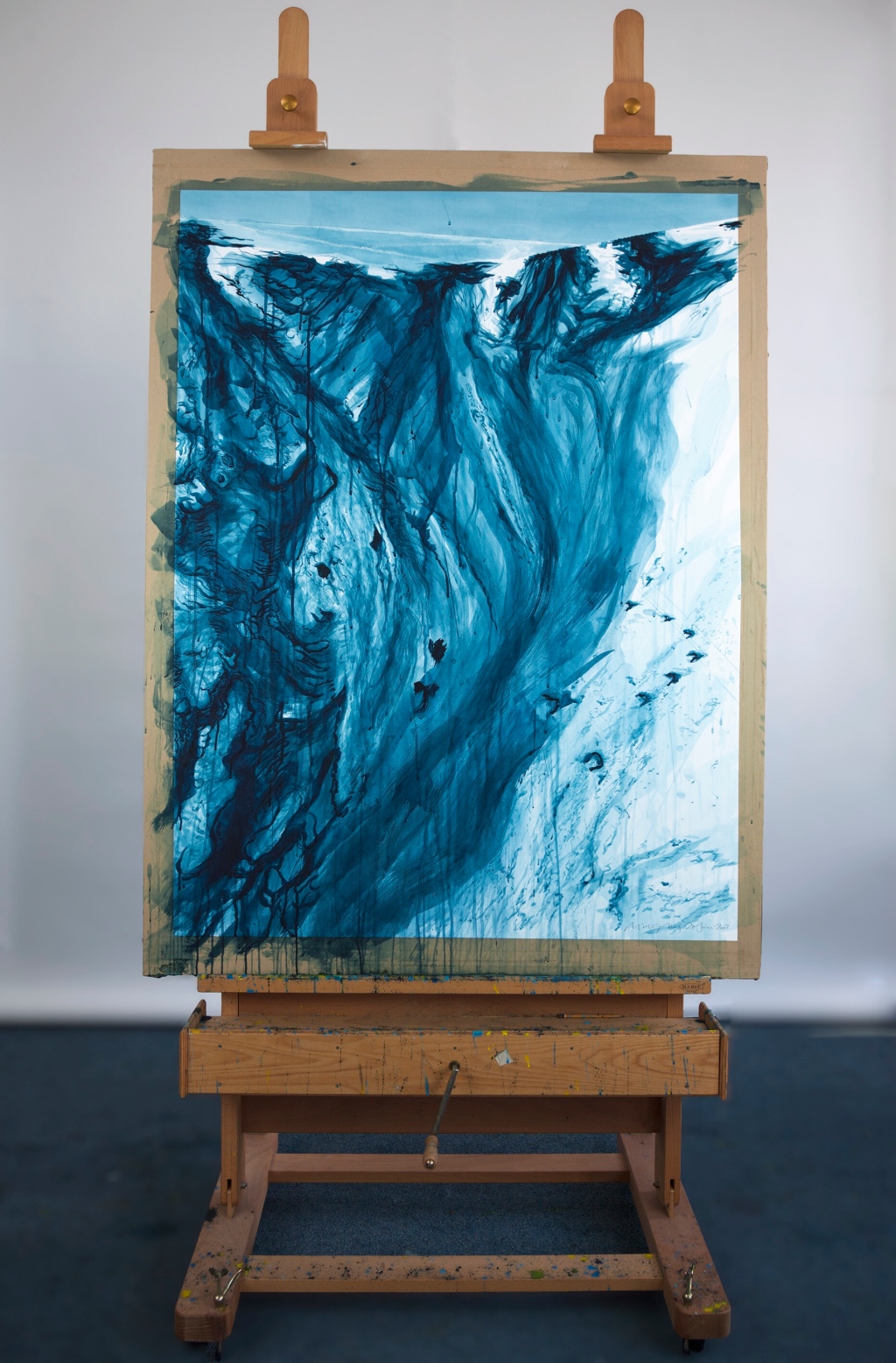
Google Earth Watercolour on Fabriano archival paper, approx 150 x 113 cm (58 x 43 inches).
Photo credit: Graham Lester George
“Flying” Google Earth: landscapes and new technologies
Over the years of investigating the mausoleum I’ve gradually found more information and images to work from. The little available online initially consisted of amateur history blogs discussing SS rituals, much of it in Polish, which I don’t speak, wobbly YouTube videos and images from one or two professional photographers. I think the information was scarce partly because the German War Graves Commission (Volksbund Deutsche Kriegsgräberfürsorge) does not have a relationship with the Polish state — probably the reason it remains abandoned. That and the lack of definitive information lead me to speculate why it had been built on that site in the first place. I therefore looked to the environment for clues — and to the Sudeten Mountains that ‘frame’ the site — through Google Earth before getting closer via Street View.
Politically I could guess that the idea was to place propaganda in the lands Nazi Germany stole from Poland, the Großdeutsches Reich. But why that precise location? That particular foothill of the Sudeten Mountains? Were there cultural reasons?
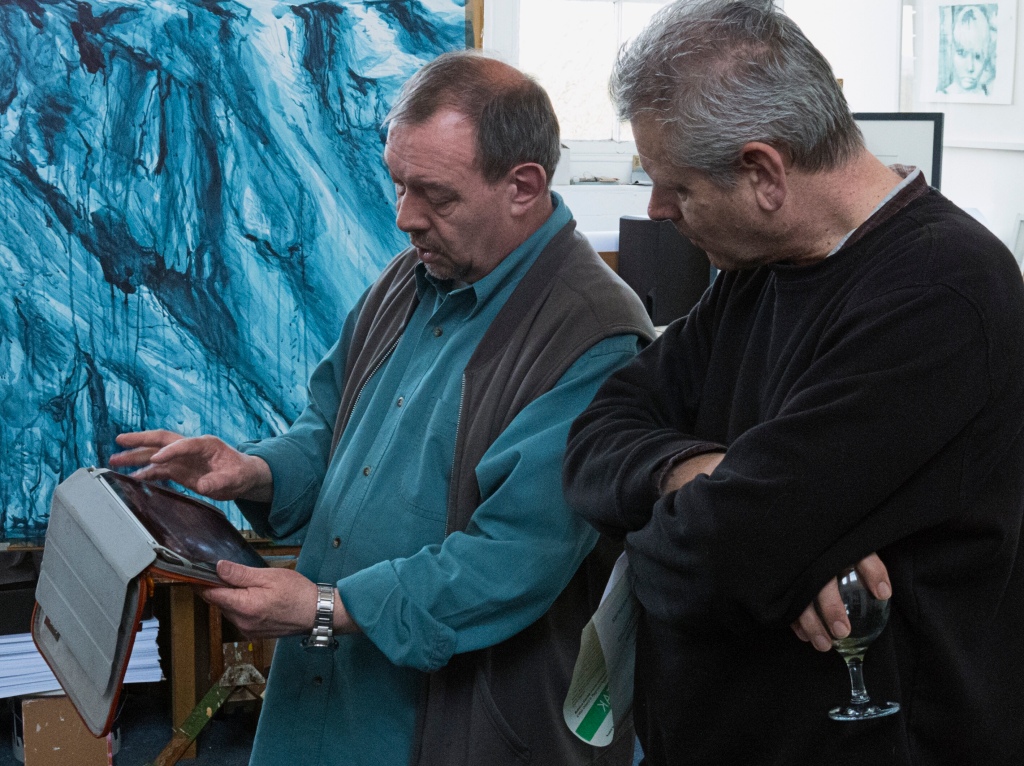
Photo credit: Graham Lester George
Granite links
Some of the most exciting work resulted from flying around the mausoleum’s wider location using Google Earth. Skimming along the mountains I discovered a glacial bowl of exposed granite on top of a mountain that divided Poland from the Czech Republic and realised that granite as a material and its cultural associations connected the different elements I was looking at. From the mausoleum’s architecture to the Gross Rosen granite quarry. The latter became the central concentration camp supplying Albert Speer with both the labour and materials for his Der Riese project. Something I’d investigated for several years. As well as the building stone intended to contribute to Hitler’s and Speer’s plans for a Thousand Year Reich.
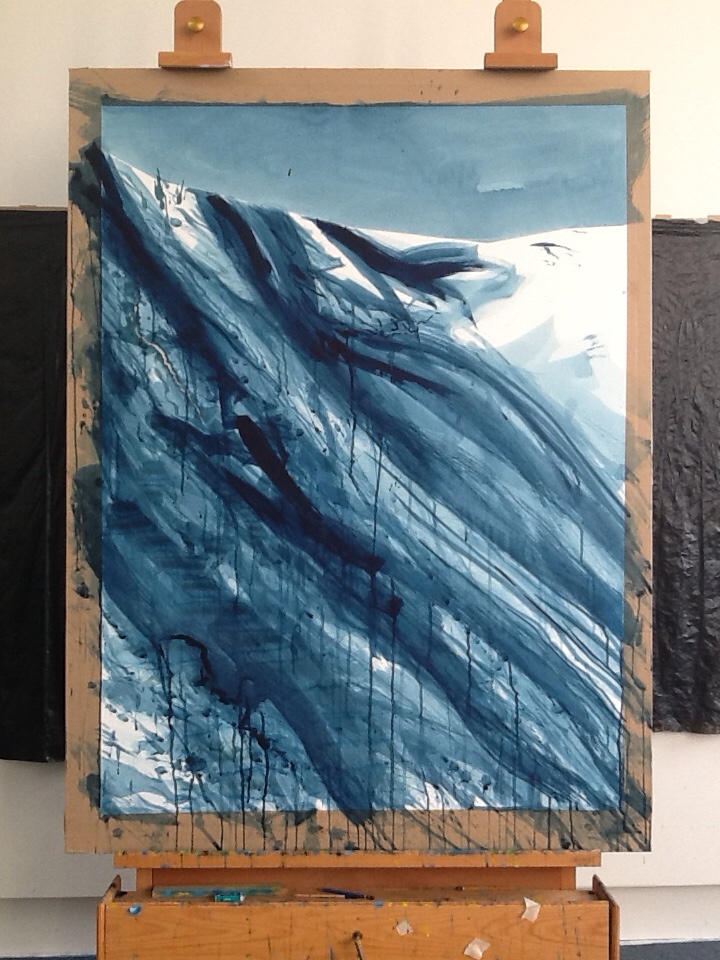
Google Earthscape, c. April 2013, watercolour on archival paper, 1.5 x 1.13 metres
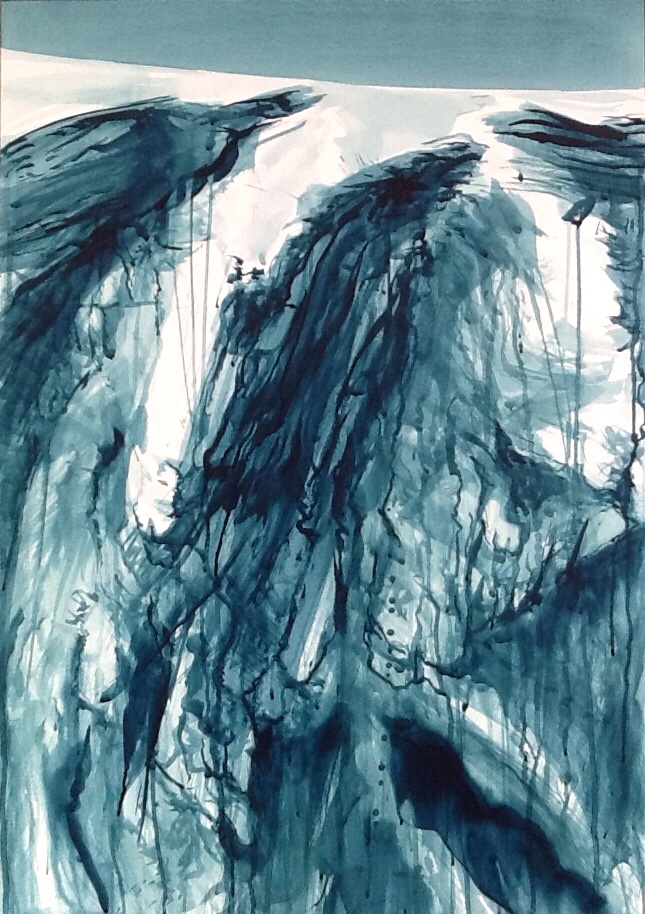
Google Earthscape, c. April 2013, watercolour on archival paper, 1.01 x 0.72 metres
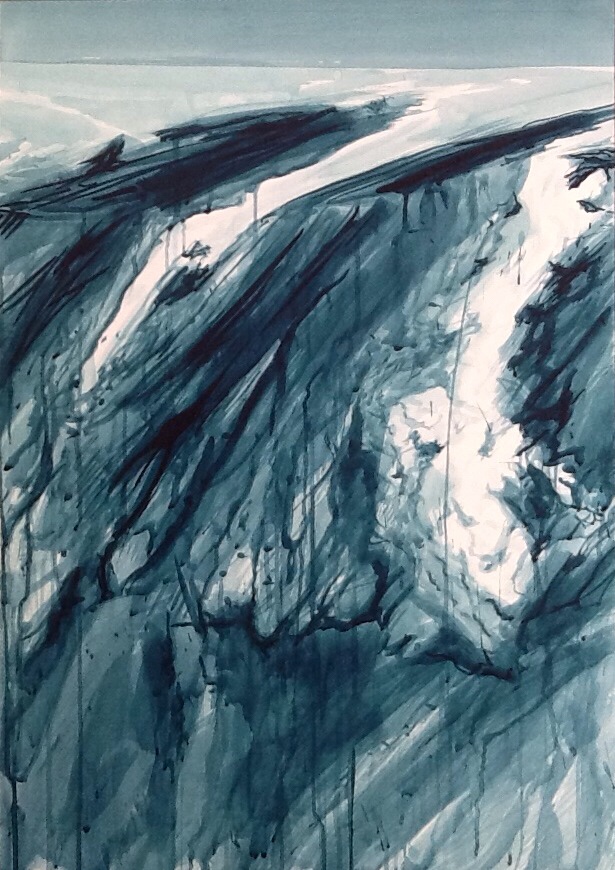
Google Earthscape, c. April 2013, watercolour on archival paper, 1.01 x 0.72 metres
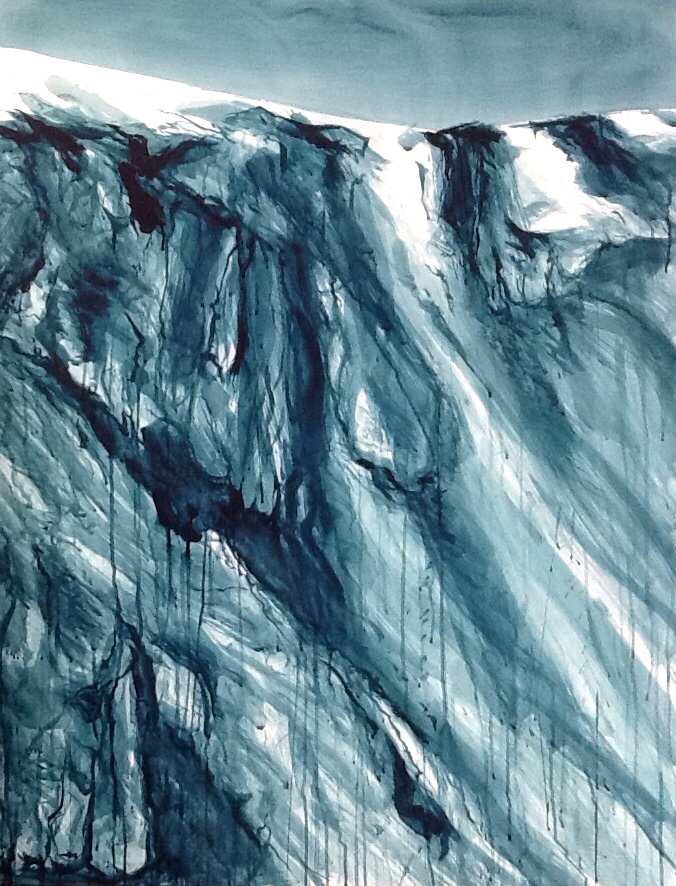
Google Earthscape, c. April 2013, watercolour on archival paper, 1.5 x 1.13 metres
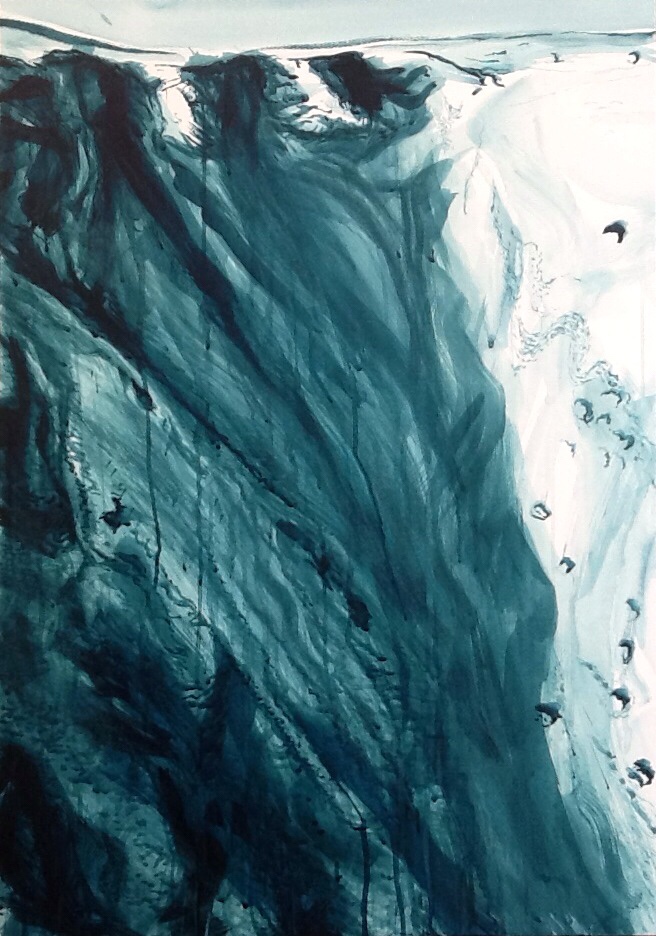
Google Earthscape, c. April 2013, watercolour on archival paper, 1.5 x 1.13 metres
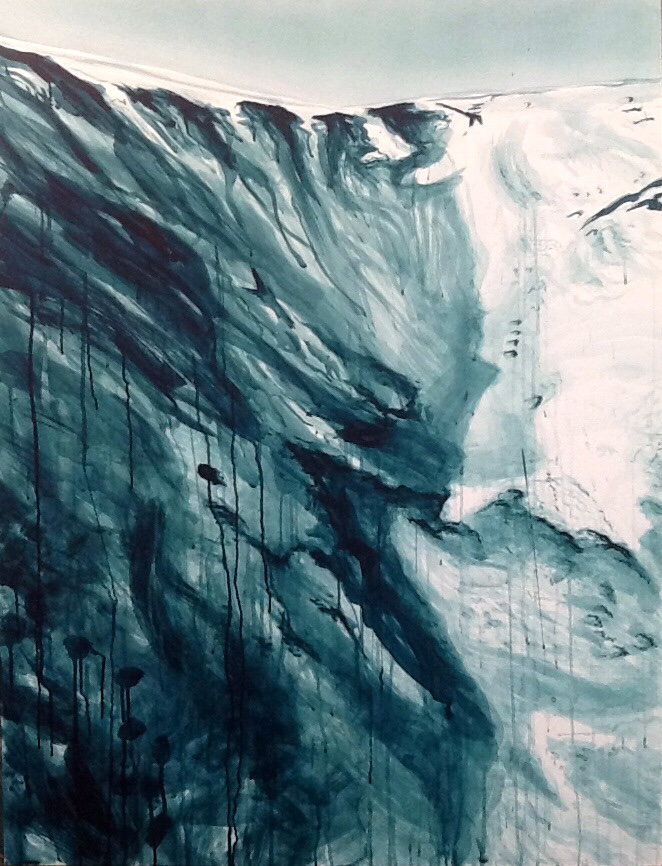
Google Earthscape, c. April 2013, watercolour on archival paper, 1.5 x 1.13 metres
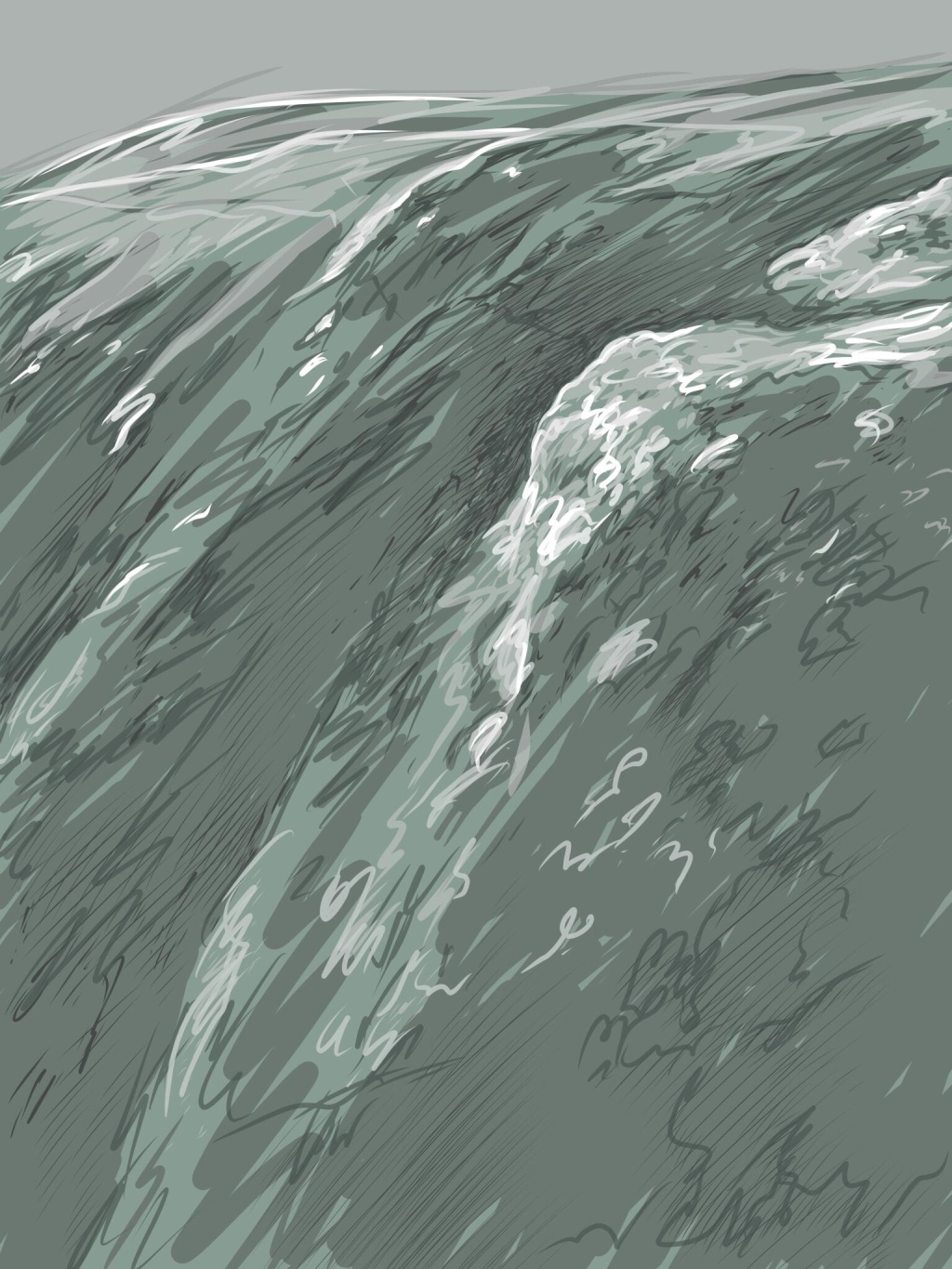
Google Earthscape, c. 8 May 2013, iPad2, app Autodesk Ink
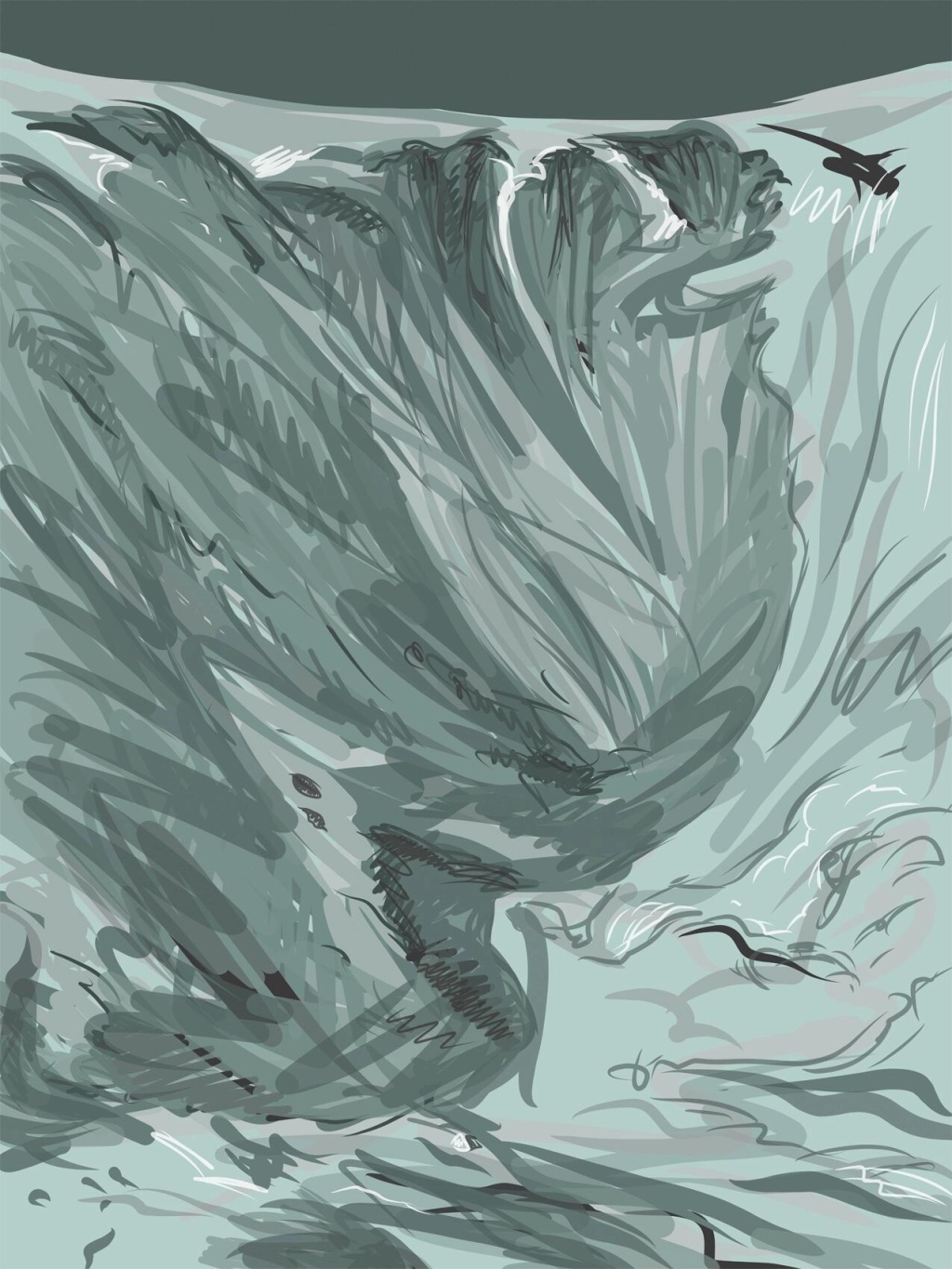
Google Earthscape, c. 8 May 2013, iPad2, app Autodesk Ink

Green screen echoes of Urwald
Having previously looked at ideas of Urwald — primeval forest — I became increasingly interested in how the mausoleum is effectively screened from view if seen via Google Street View. Hidden by surrounding woodland that has grown substantially since the mausoleum was built in 1938, old photographs show that it used to be very visible from the town below. (Incidentally, Speer’s Der Riese was camouflaged by the forests covering the Owl Mountains, a “déjà vu” landscape I felt I somehow inherently ‘knew’ although I’ve never been there). The Polish authorities don’t seem to know what to do with this unwanted alien heritage and would probably rather forget it. The growing trees and thick underbrush help the process of post-war “forgetting”. And it may be for the same reason that Google has deleted Street View imagery at several locations on the perimeter of the site. Perhaps a further act of hiding. This apparent attempt at censoring of the past in the context of today’s politics became key to my investigations: aiming to record it in its present state, and highlight such “aestheticisations of evil”.
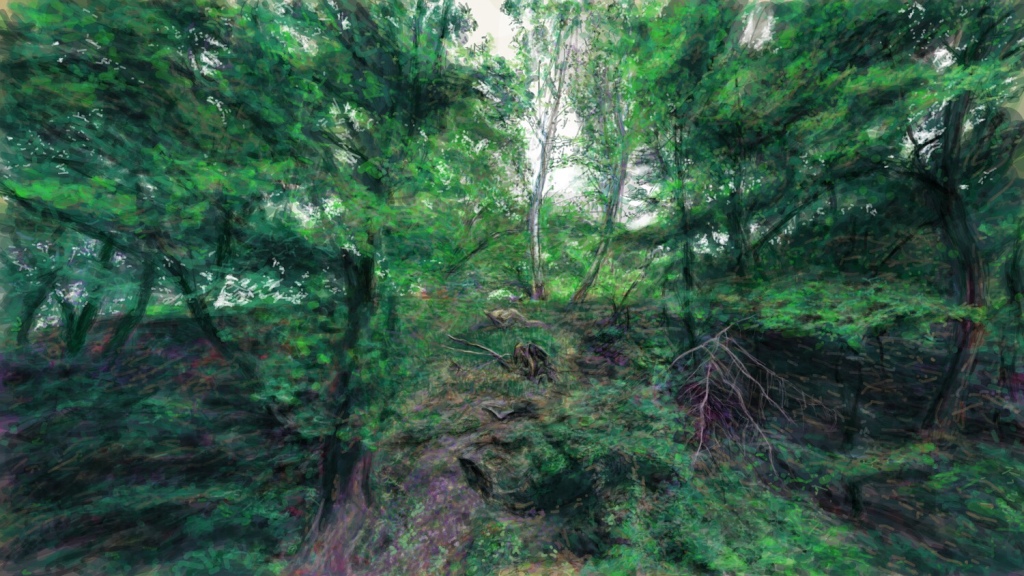
25 Słowicza, Wałbrzych, Lower Silesia, via Google Street View, 27 July 2015 – vector app Paintbook on iPad2
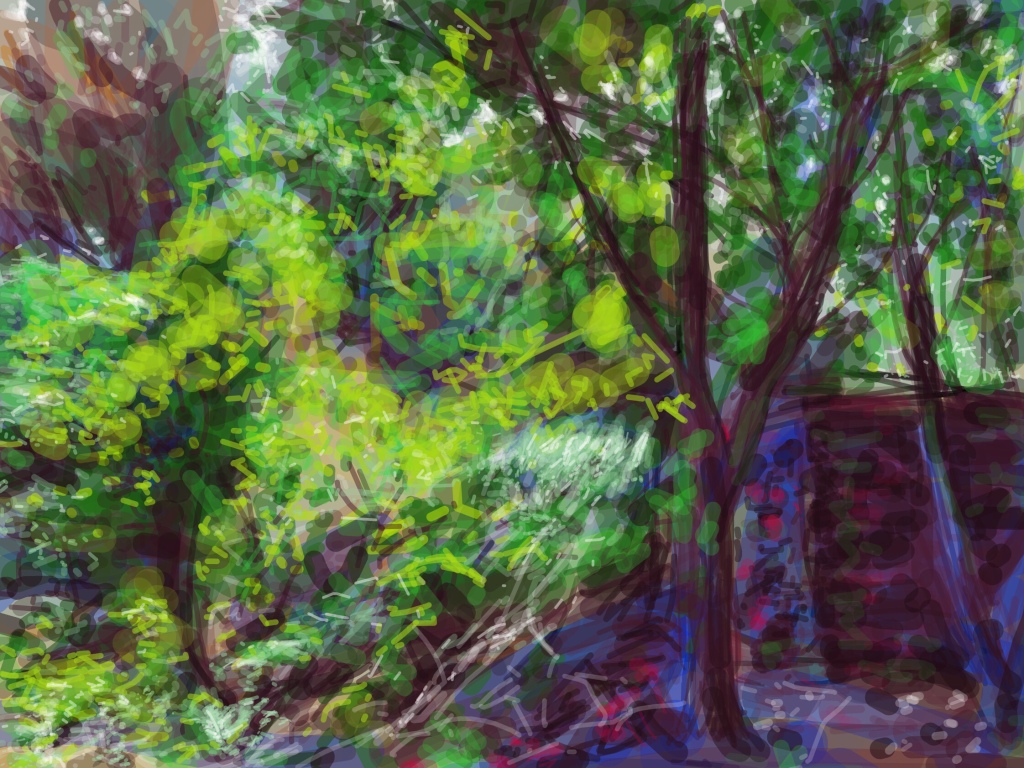
off Marszałka Józefa Pilsudskiego, Wałbrzych, Lower Silesia, 22 May 2015, vector app Paintbook on iPod Touch
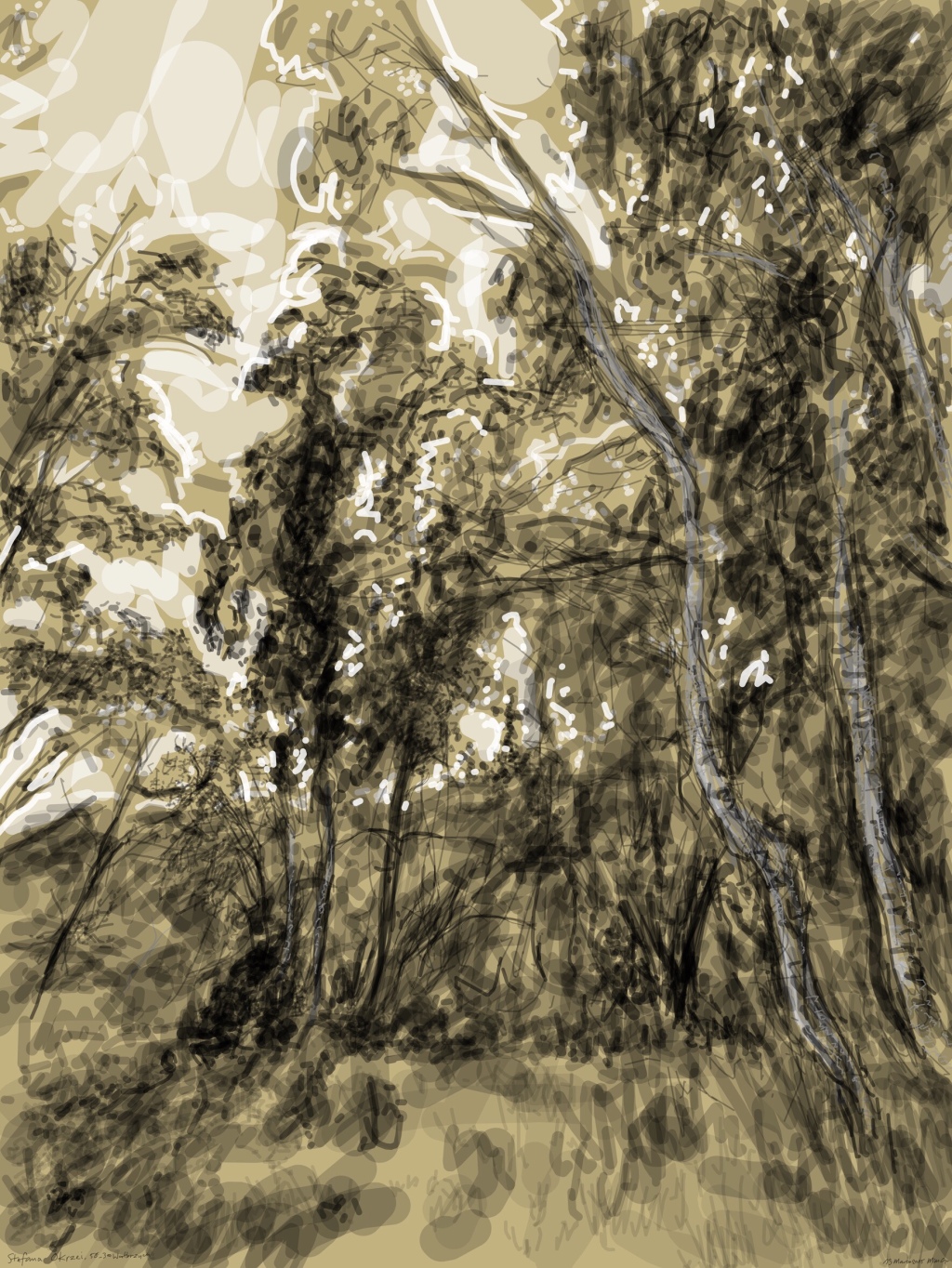
Stefana Okrzei, 58-300 Wałbrzych, via Google Street View, iPad2 drawing, app Paintbook, 13 March 2015
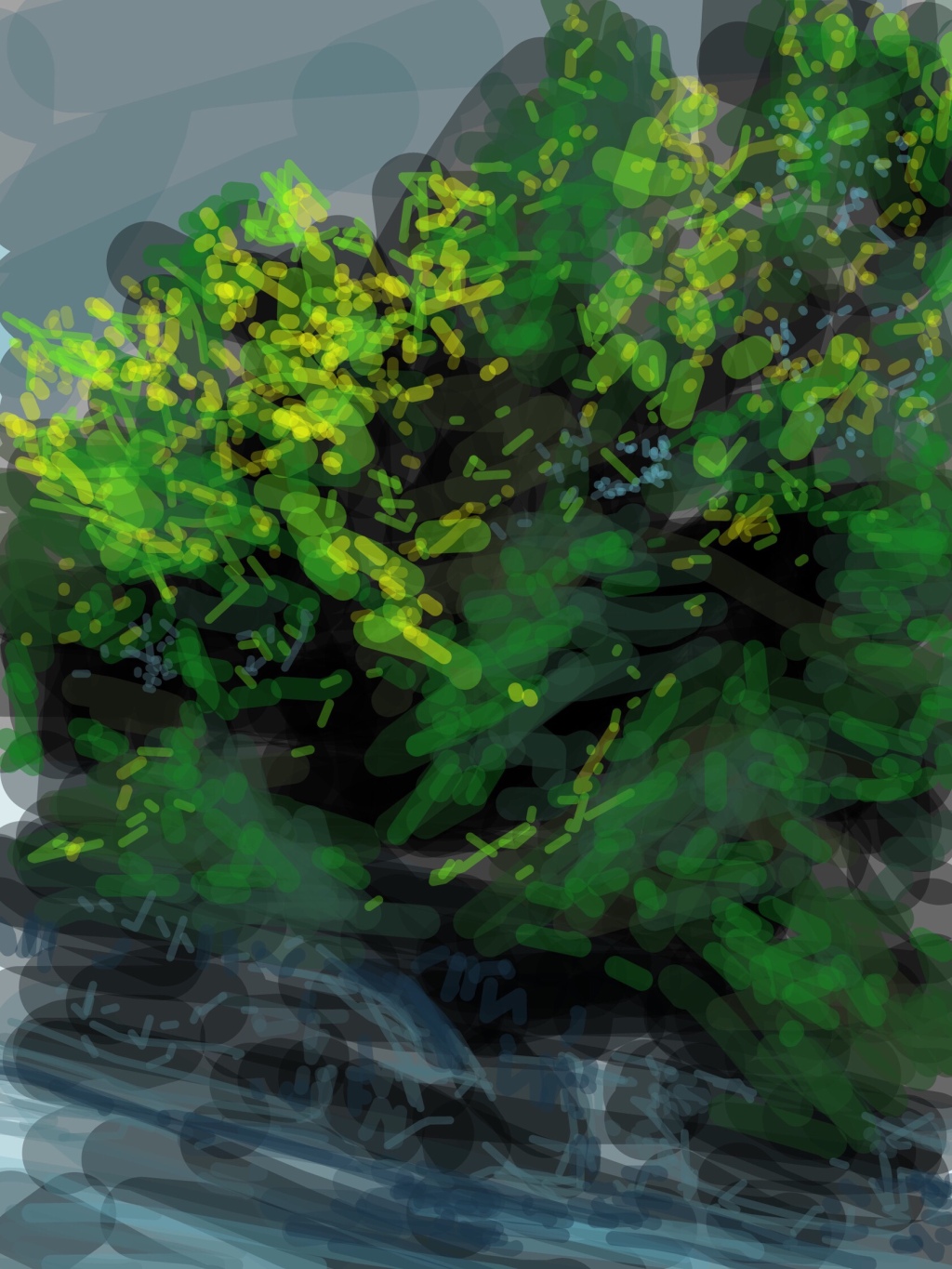
Marszałka Józefa Piłsudskiego, Wałbrzych, Lower Silesia, via Google Street View, footpath entrance iPod sketch, app Paintbook (vector), 11 May 2015
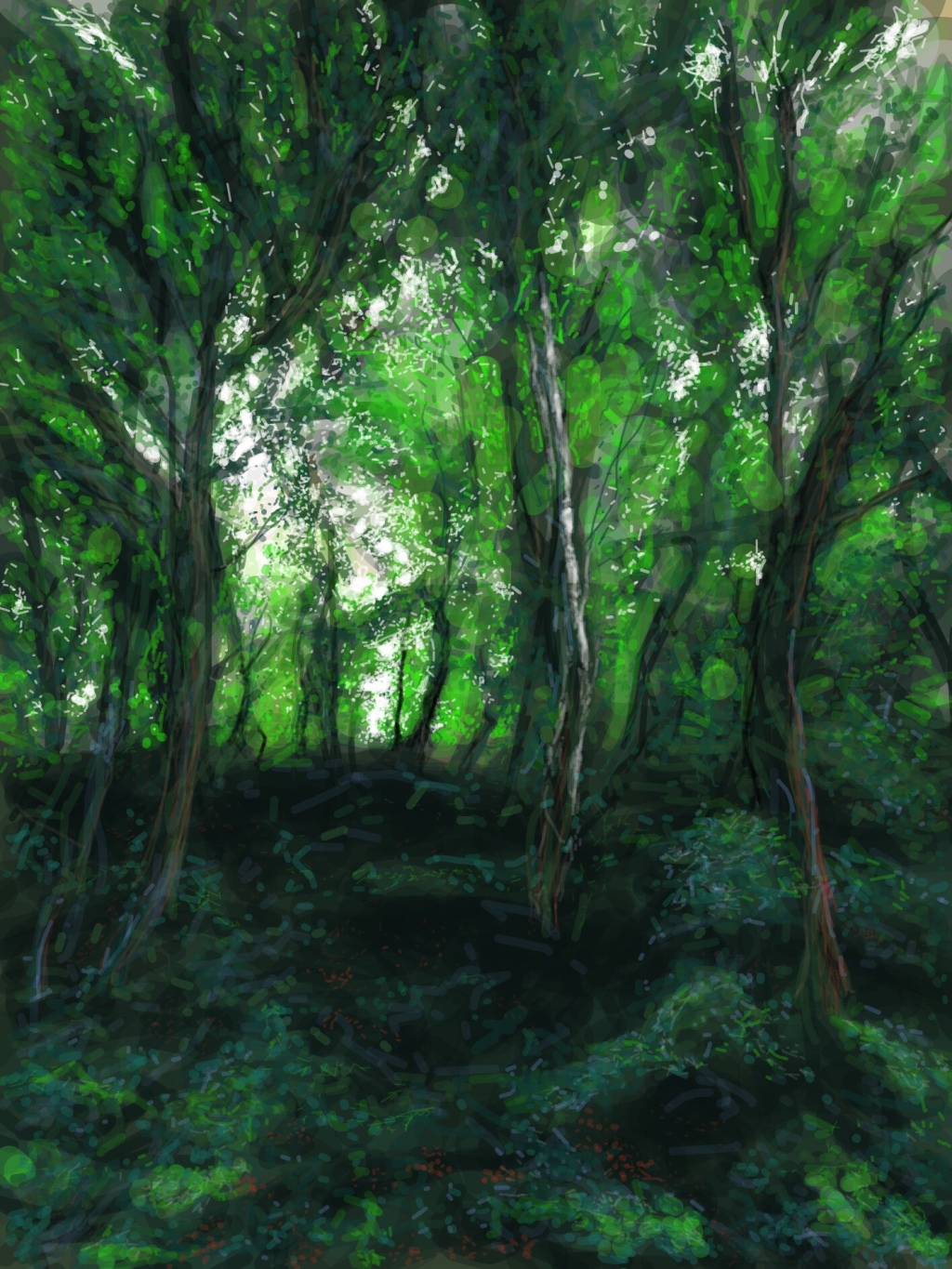
Near Słowicza 25, Wałbrzych, Lower Silesia, via Google Street View, 23 June 2015, vector app Paintbook on iPod Touch
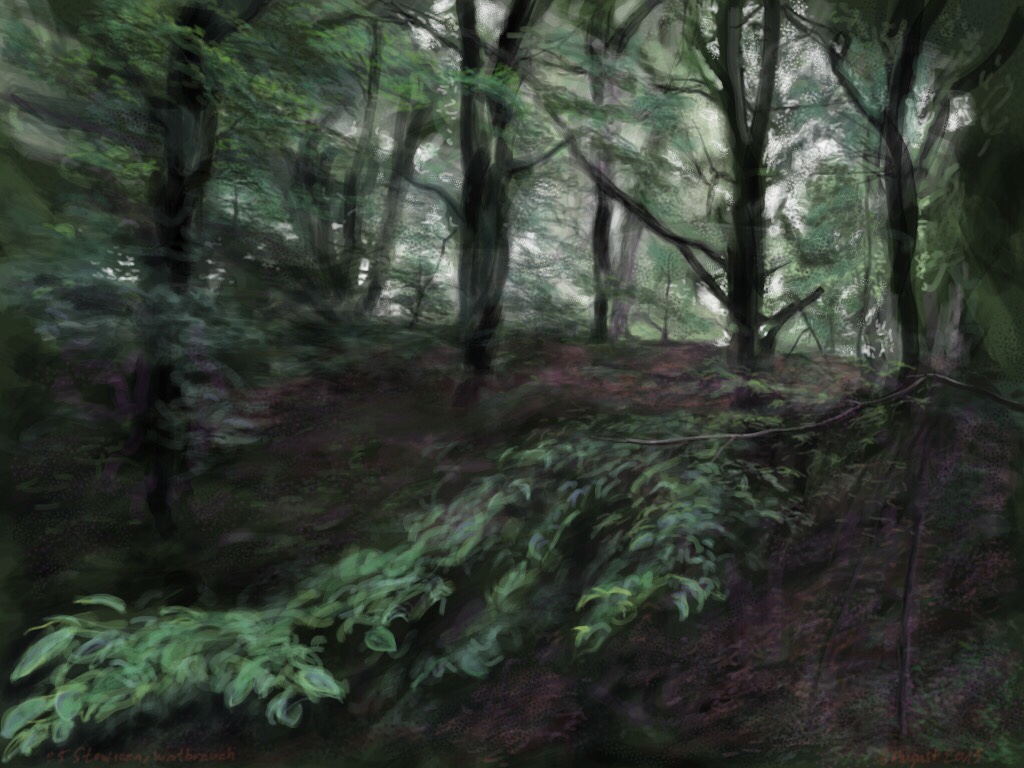
Słowicza 25 via Street View, 6 August 2015, app Brushes on iPad2

Nowowiesjka, Wałbrzych, via Google Street View, app Brushes on iPad2, 27 March 2015
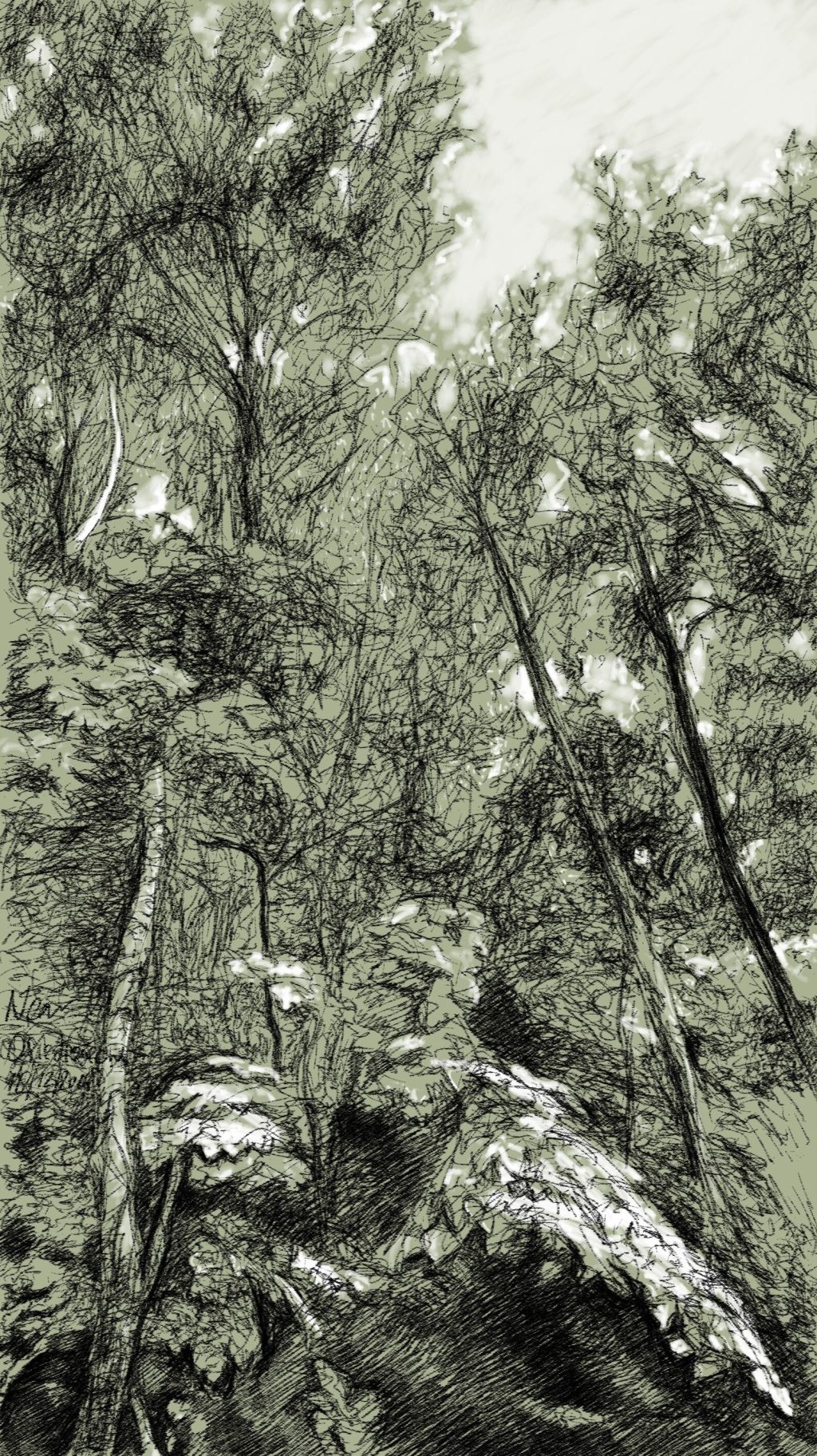
Near Osiédlénców, sketch 2, 18 December 2015, Autodesk Sketchbook on LG G4 mobile (cell) phone
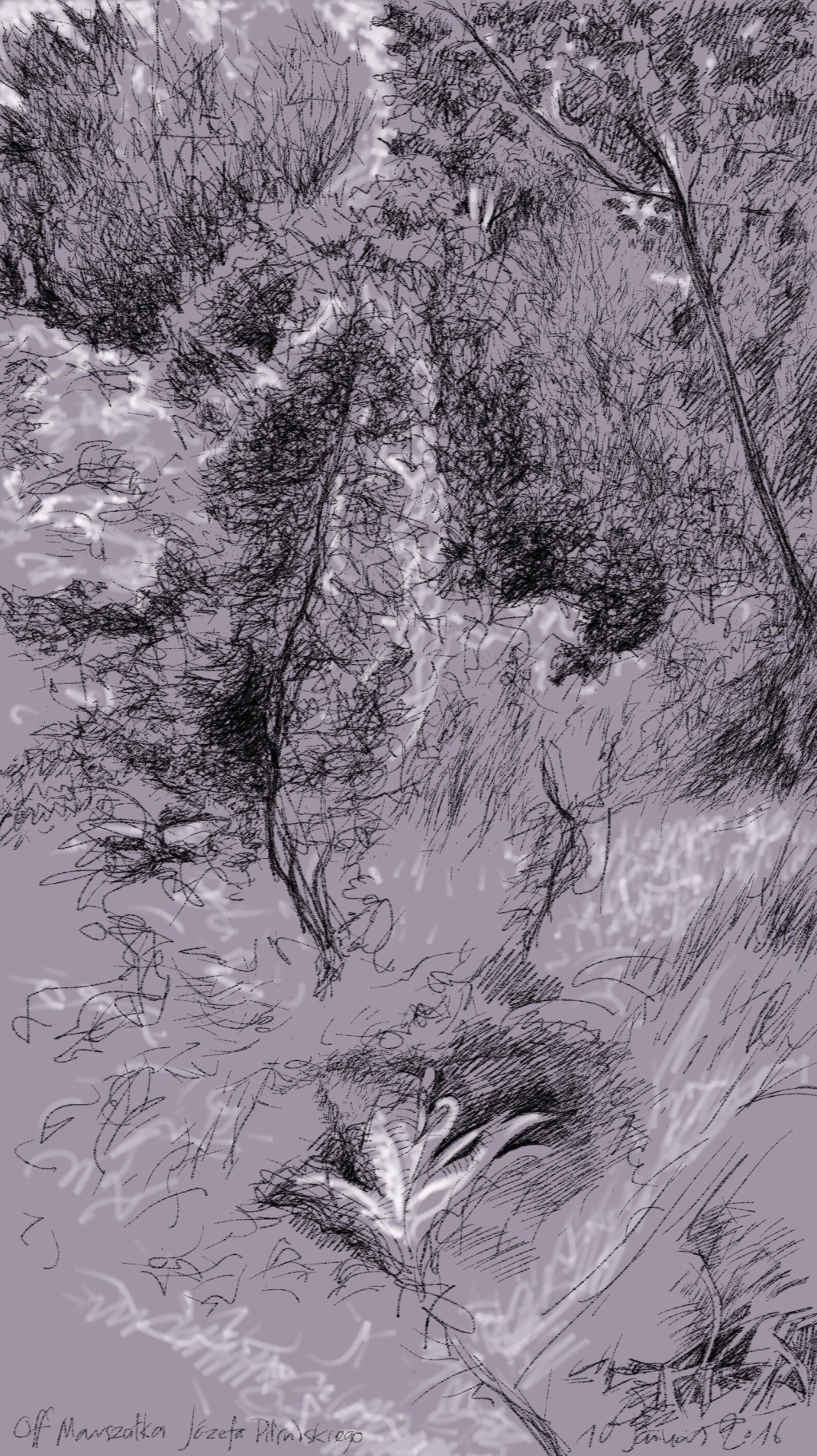
Off Marszałka Jósefa Piłsudskiego, Wałbrzych, Lower Silesia, via Google Street View, 10 January 2016, Autodesk Sketchbook on LG G4 mobile (cell) phone
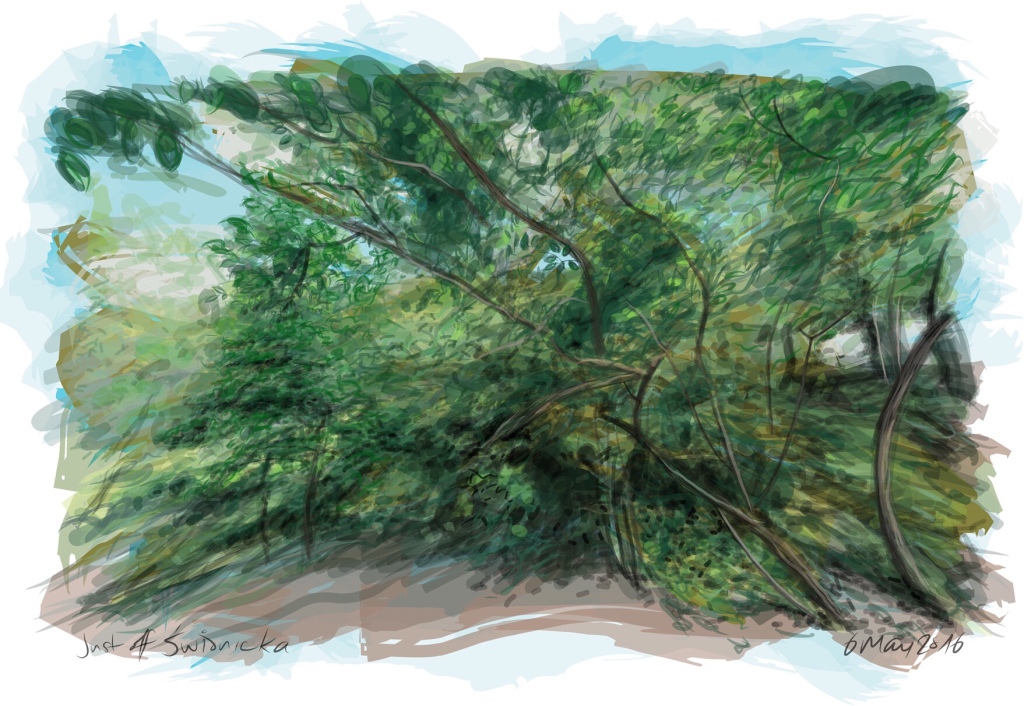
Just off Świdnicka, Wałbrzych, via Google Street View, vector app Infinite Design on LG G4 mobile phone, 6 May 2016
Sphere View
Further opportunities for visual research came in Autumn 2017. I discovered little blue dots on the map. Google Maps had posted Photo Sphere images from directly around and inside the mausoleum. Someone had wandered around with a camera taking higher resolution images at various points inside and outside the building that now allow me to pan all around in 360 degrees, up and down, to select compositions to work from. Very exciting!
Wałbrzych Mausoleum via Google Sphere View, 3 August 2017, vector app Concepts on iPad Pro
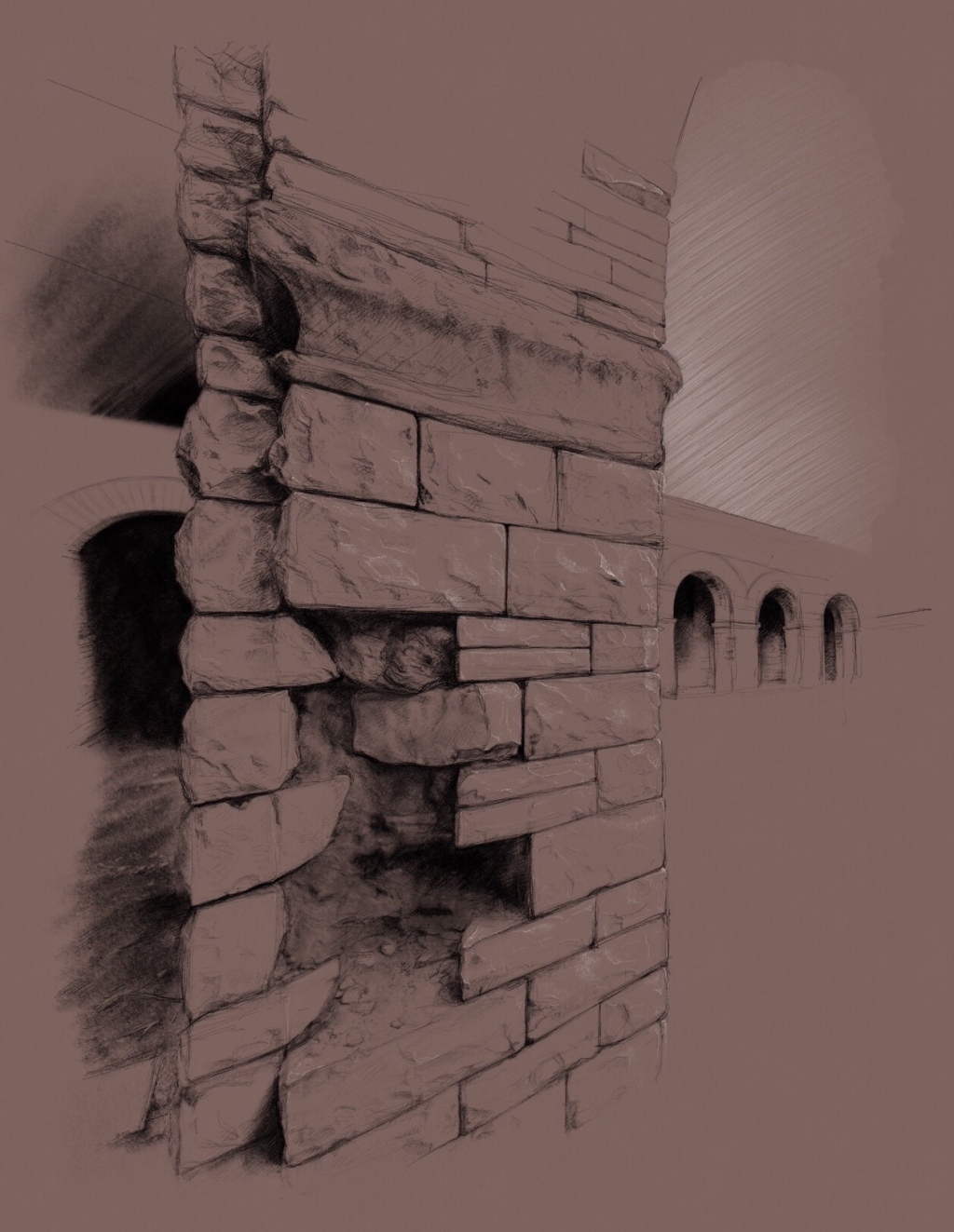
Wałbrzych Mausoleum via Google Sphere View, 11 August 2017, vector app Concepts on iPad Pro
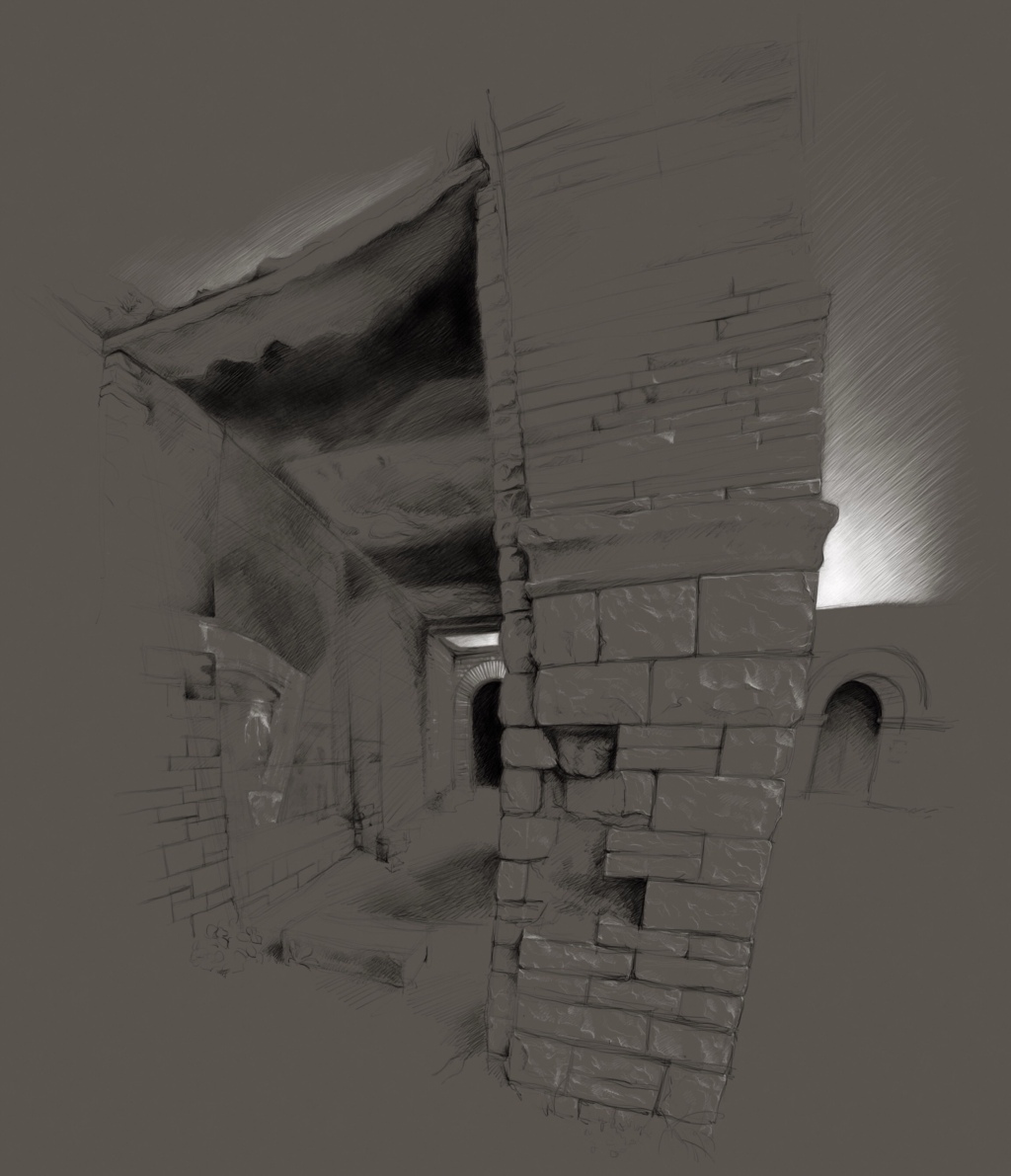
Wałbrzych Mausoleum via Google Sphere View, 27 July 2017, vector app Concepts on iPad Pro
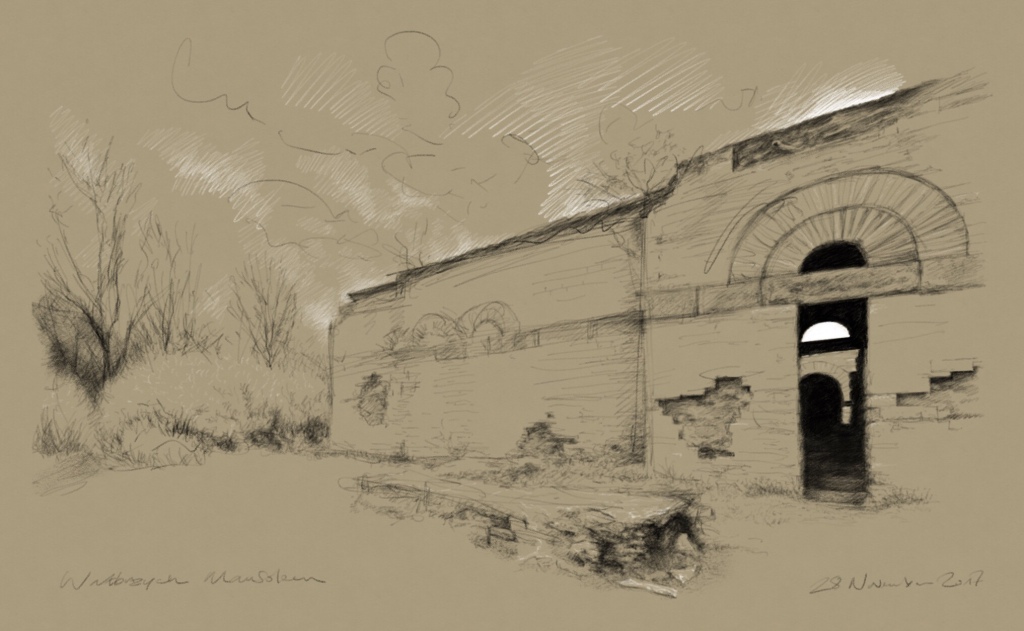
Wałbrzych Mausoleum (Waldenburg Totenburg) via Google Sphere View, entrance, 28 November 2017, Concepts app on iPad Pro

Wałbrzych Mausoleum (Waldenburg Totenburg) via Google Sphere View, exterior, 8 January 2018, app Procreate on iPad Pro
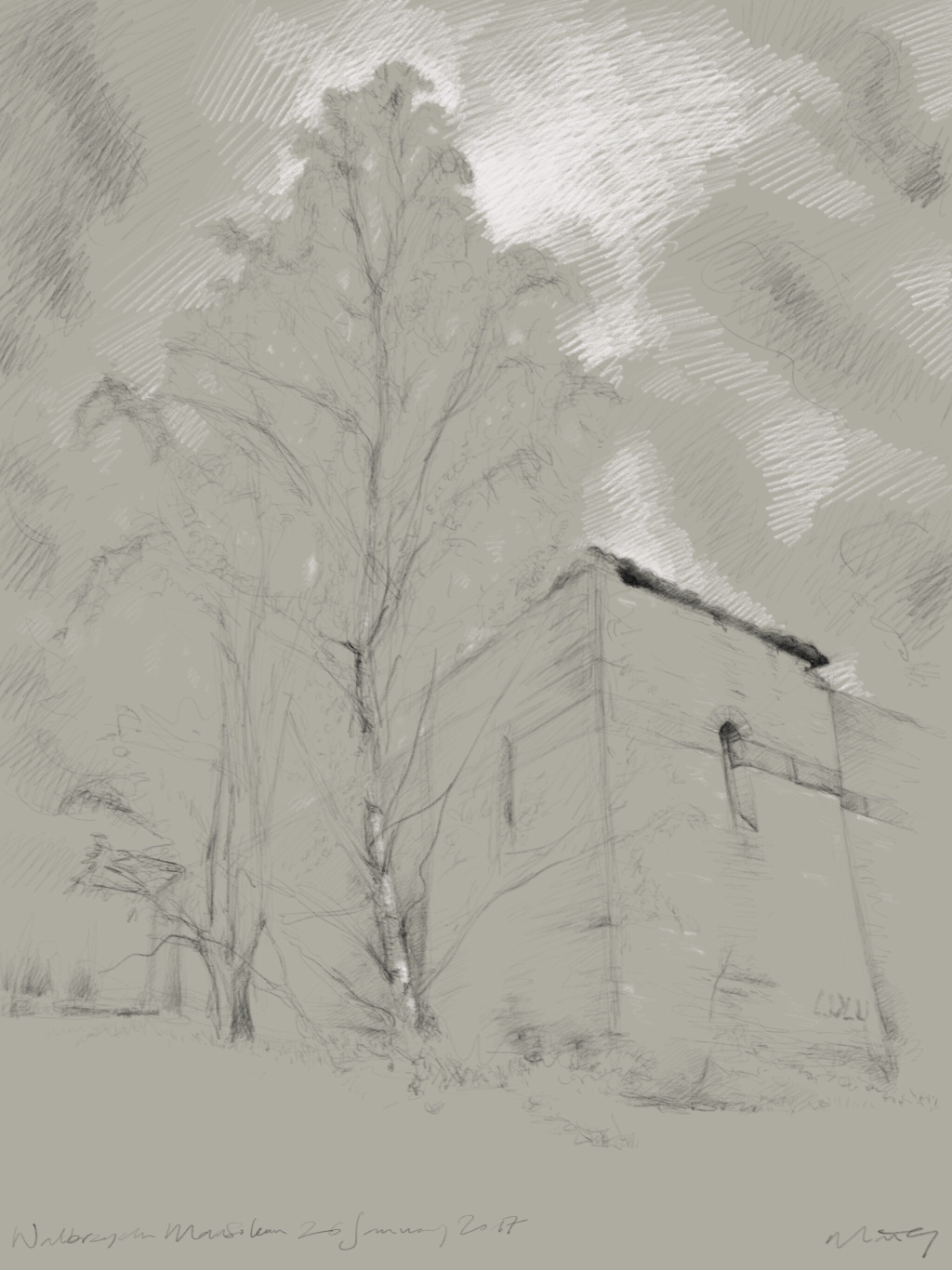
Wałbrzych Mausoleum (Lulu #2), via Google Sphere View, 26 January 2017, app Procreate on iPad Pro
The iPad Pro
I’ve been delving a good deal further into the potential offered by my iPad Pro and Apple Pencil stylus. The app Procreate offers 4K high resolution, video time lapse play-back of the drawing process. And a new app, Concepts, gives sophisticated vector possibilities to enable a great range of mark-making and very high quality prints. For instance I spent much of last summer testing Concepts with a view to using the vector files to create laser-cut wood engravings.
Osiedleńców, Wałbrzych, Lower Silesia via Google Street View, app Procreate on iPad Pro, 9 April 2018
Osiedleńców, Wałbrzych, Lower Silesia via Google Street View, app Concepts on iPad Pro, 27 March 2018
Un-named road off Świdnicka, number 2 (this one with yellow), Wałbrzych, Lower Silesia, South West Poland, via Google Street View, 17 April 2018, app Concepts on iPad Pro
Un-named road off Świdnicka, Wałbrzych, Lower Silesia, South West Poland, Friday 13th April 2018, app Concepts on iPad Pro
2 Słowicza West side #2, Wałbrzych, Lower Silesia, via Google Street View, 29 May 2018
2 Słowicza, Walbrzych, Lower Silesia via Google Street View, 3 May 2018, app Concepts on iPad Pro
Osiedleńców Number 3 (YG11) via Google Street View, vector app Concepts on iPad Pro, 26 April 2018
Góra Niedźwiadki, Wałbrzych, Lower Silesia, Poland, via Google Photo Sphere, 5th May 2018
Osiedleńców No. 2, mausoleum site perimeter, Wałbrzych, Lower Silesia, 20 April 2018, app Concepts on iPad Pro
2 Słowicza West side #3 via Google Street View, vector app Concepts on iPad Pro, 5 June 2018
2 Słowicza West side #1 via Google Street View, vector app Concepts on iPad Pro, 21 May 2018
2 Słowicza (oblique view) via Google Street View, vector app Concepts on iPad Pro, 12 May 2018
How to look
Because so much of my working life has been teaching art students the rudiments of “how to look” through life-drawing, observation and perception have naturally been at the core of my thinking about these documents of my observations via the internet. I’m fascinated by how our way of seeing is increasingly affected by our use of digital images as source material when working both with traditional media — paper, pencils, canvas, paints etc. And with digital imaging with devices such as smartphones and tablets.
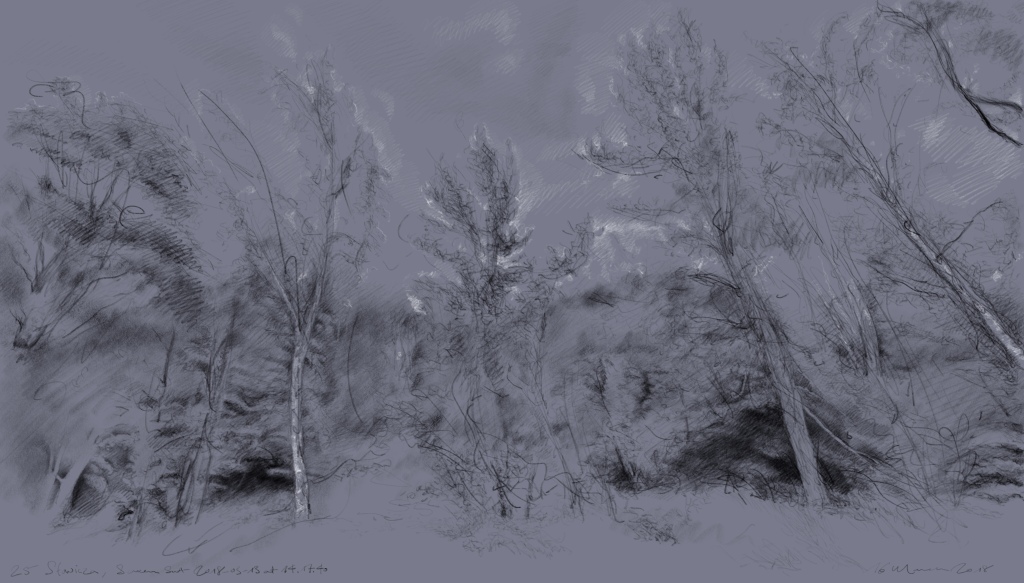
25 Słowicza, Wałbrzych (via Google Street View) Screen Shot 2018-03-13 at 14.17.40, iPad Pro, app Procreate, 16 March 2018
Often impulsive, while drawing my eyes flit around the screen and I’m aware of many “mistakes” I make in creating the drawings. Unlike cameras, for us looking is a process. And the idea is to draw my responses to what I see and learn — both good and bad. Interpretation changes in the perception and the process of drawing, and overall I like my mis-perceptions, or lack of control. It adds to the quality of the marks and image. With the iPad Pro I’m still learning how to use the tools and software, and to be honest, drawing with a piece of plastic onto a glass plate is not the easiest way of working. Sometimes I correct, sometimes I don’t, but there’s always a record of it, especially visible if the process is played back as video.
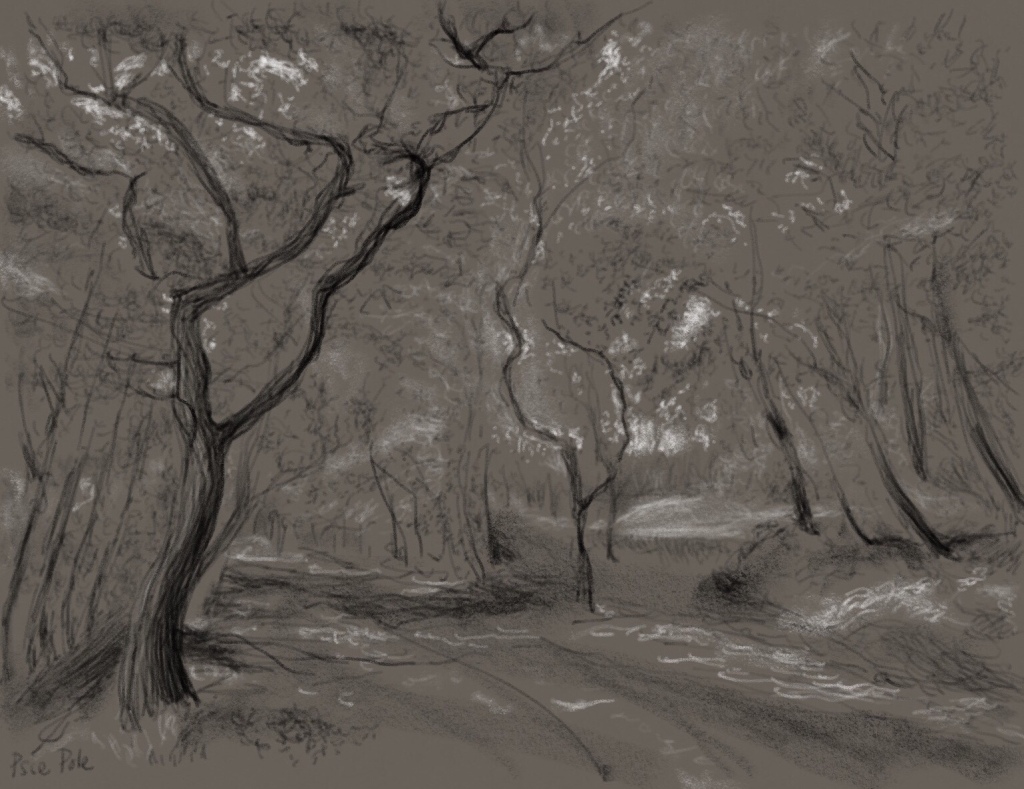
Psie Pole, Wałbrzych, Lower Silesia via Google Street View, Concepts on iPad Pro, 19 September 2017
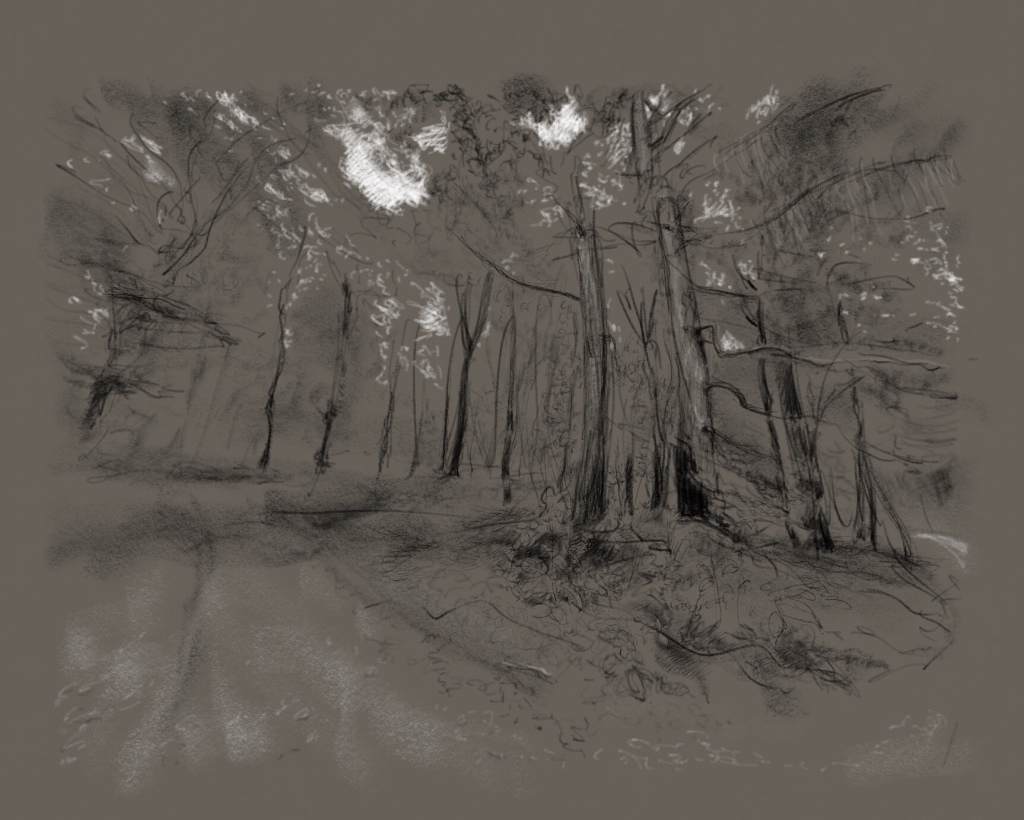
Park Góra Niedźwiadki, Wałbrzych, Lower Silesia, Poland, via Google Sphere View, 7 October 2017, Concepts on iPad Pro
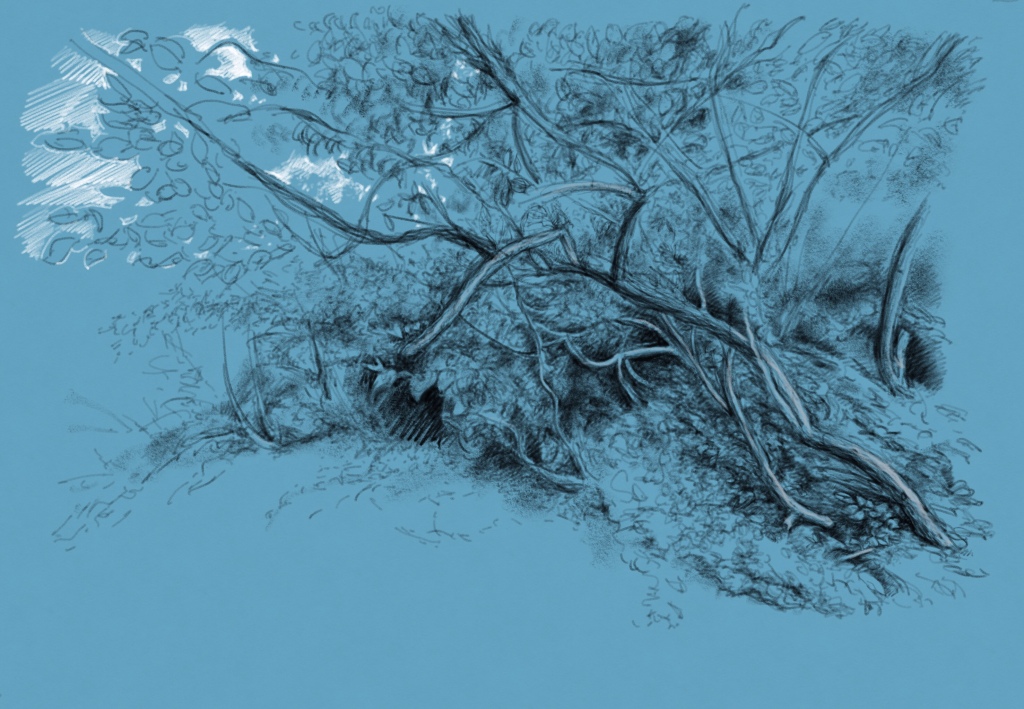
Inwalidów Wojennych, Wałbrzych, Lower Silesia, Poland, via Google Street View, 6 October 2017, Concepts on iPad Pro
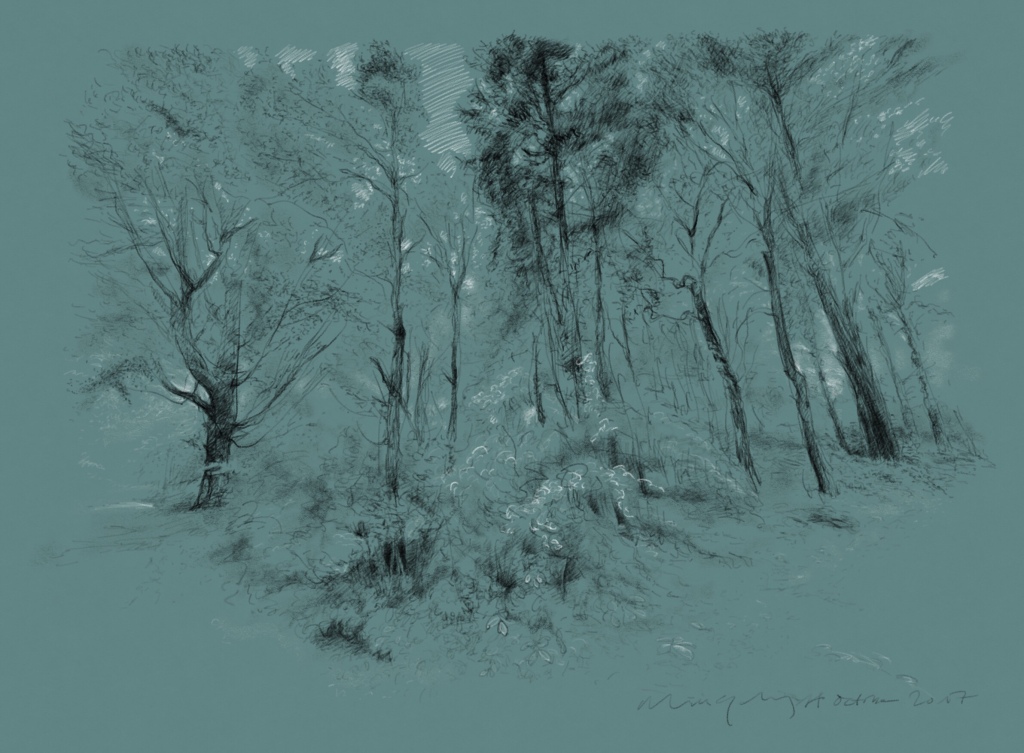
Park Góra Niedźwiadki, Wałbrzych, Lower Silesia, Poland, via Google Sphere View, 14 October 2017, Concepts on iPad Pro
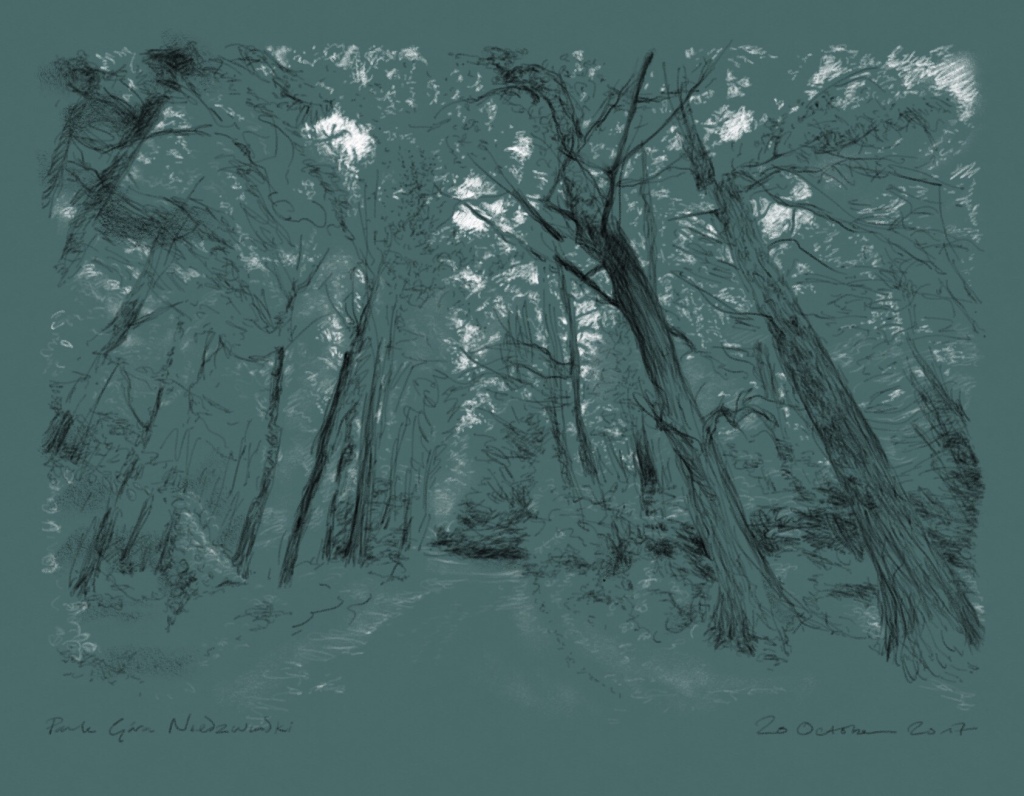
Park Góra Niedźwiadki, Wałbrzych, Lower Silesia, Poland, via Google Sphere View, 20 October 2017, Concepts on iPad Pro
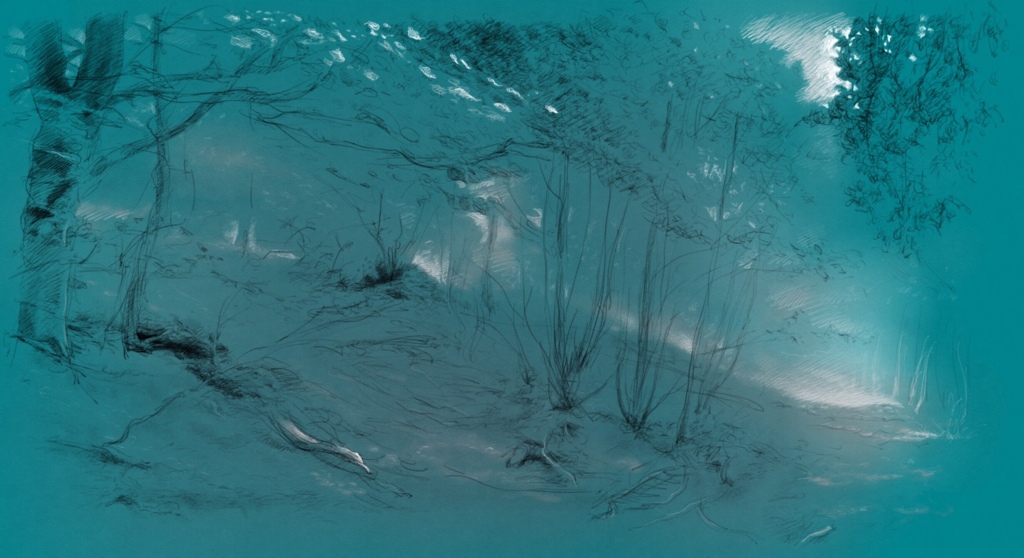
Park Sudeten Wałbrzyskie, Lower Silesia, Poland, via Google Sphere View, 25 October 2017, app Concepts on iPad Pro
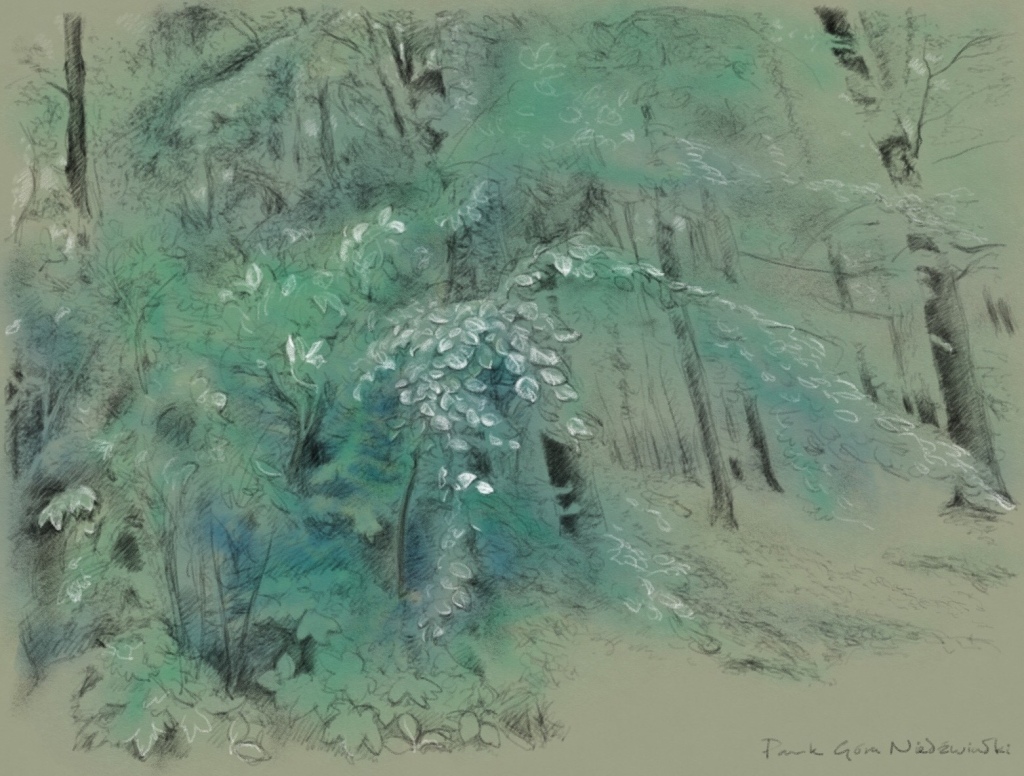
Park Góra Niedźwiadki, Wałbrzych, Lower Silesia, Poland, via Google Sphere View, 14 November 2017, Concepts on iPad Pro
Architecture as propaganda — the art history
I found more information about the mausoleum’s architect, Robert Tischler, recently, on an academic call out to research. In an article written by Christian Furhrmeister (2), for the periodical RIHA (3). Tischler was chief architect of the German War Graves Commission from 1926 until his death in 1959. Both his Munich office and the Berlin office of the Volksbund, containing between them a large archive of photographs and all documents, were bombed during World War Two.

North Plinth, Wałbrzych Mausoleum (Love), via Google Sphere View, 1 March 2018, app Procreate on iPad Pro
‘Ruin value’
However, as a staunch Nazi, by his designs Tischler seems to have agreed with Albert Speer’s ideas on Ruinenwert or Ruin Value in using the permanence of natural building materials for monumental architecture:
‘These immortal monuments or temples of the German Reich were not just a means of “bequeathing to posterity the genius” of Hitler’s age. A far more obvious Totenkult [death cult] aesthetic was also evident in Hitler’s monumental architectural plans. Specifically the construction of miles upon miles of mausoleums along the borders of Germany’s newly expanded empire.’
‘Following The Nazis supposed victory against the Allied powers, colossal citadels for the dead, or Totenburgen, envisaged by Hitler’s “were to glorify war, honor its dead heroes” and at the same time, “symbolize the impregnable power of the German race” as the massive stone structures would stretch “from the Atlantic to the Urals.”’
Meghan O’Donnell (4)
https://www.libraryofsocialscience.com/newsletter/posts/2014/2014-12-9-odonnell2.html
‘To this day, therefore, the appearance of numerous German cemeteries at home and abroad is shaped by the artist’s handwriting — by his aesthetic premises and convictions. These include, above all, an almost ostentatious craftsmanship and the use of natural materials, the avoidance of industrially prefabricated building elements and artificial building materials such as concrete or asphalt. For example, Tischler’s emphasis on traditional craftsmanship went hand in hand with elaborate solid construction — instead of cost-saving veneering or wall cladding.’
Christian Fuhrmeister essay, translated from the German via Google Translate
https://www.riha-journal.org/articles/2017/0150-0176-special-issue-war-graves/0159-fuhrmeister
Romantic notions of ruins were born during the Renaissance and later industrialized by artists of The Grand Tour. But I think here Tischler’s grand materials have been disrupted by a history shown by layer upon layer of graffiti, abandoned and screened off from the contemporary world — together a symbol of Europe’s post-war history and turbulent current events seemingly condemned to repeat it by deliberate forgetting.
One wall of the mausoleum has a sprayed image of a black eagle and swastika, with the words “Wir kommen wieder”.
…
PS. I am a little aware that Walter Benjamin’s ideas on ruins may be more in line with my own thoughts, but frankly don’t know enough about his work at this time to comment.
…
Notes
1. Wałbrych Mausoleum — Waldenburg Totenburg (in German) — Death Castle — the memorial for thousands of Silesians who died in World War One and twenty-three Silesian pioneers of the National Socialist movement.
2. Christian Fuhrmeister — an art historian at the Zentralinstitut für Kunstgeschichte in Munich.
3. RIHA — Journal of the International Association of Research Institutes in the History of Art: Special Issue “War Graves / Die Bauaufgabe Soldatenfriedhof, 1914 – 1989” 2017 (eds. Christian Fuhrmeister and Kai Kappel).
https://www.riha-journal.org/articles/2017/0150-0176-special-issue-war-graves
4. “The ‘Ruin Value’ of Monumental Architecture” (Part II of Dangerous Undercurrent: Death, Sacrifice and Ruin in Third Reich Germany) by Meghan O’Donnell, California State Monterey Bay
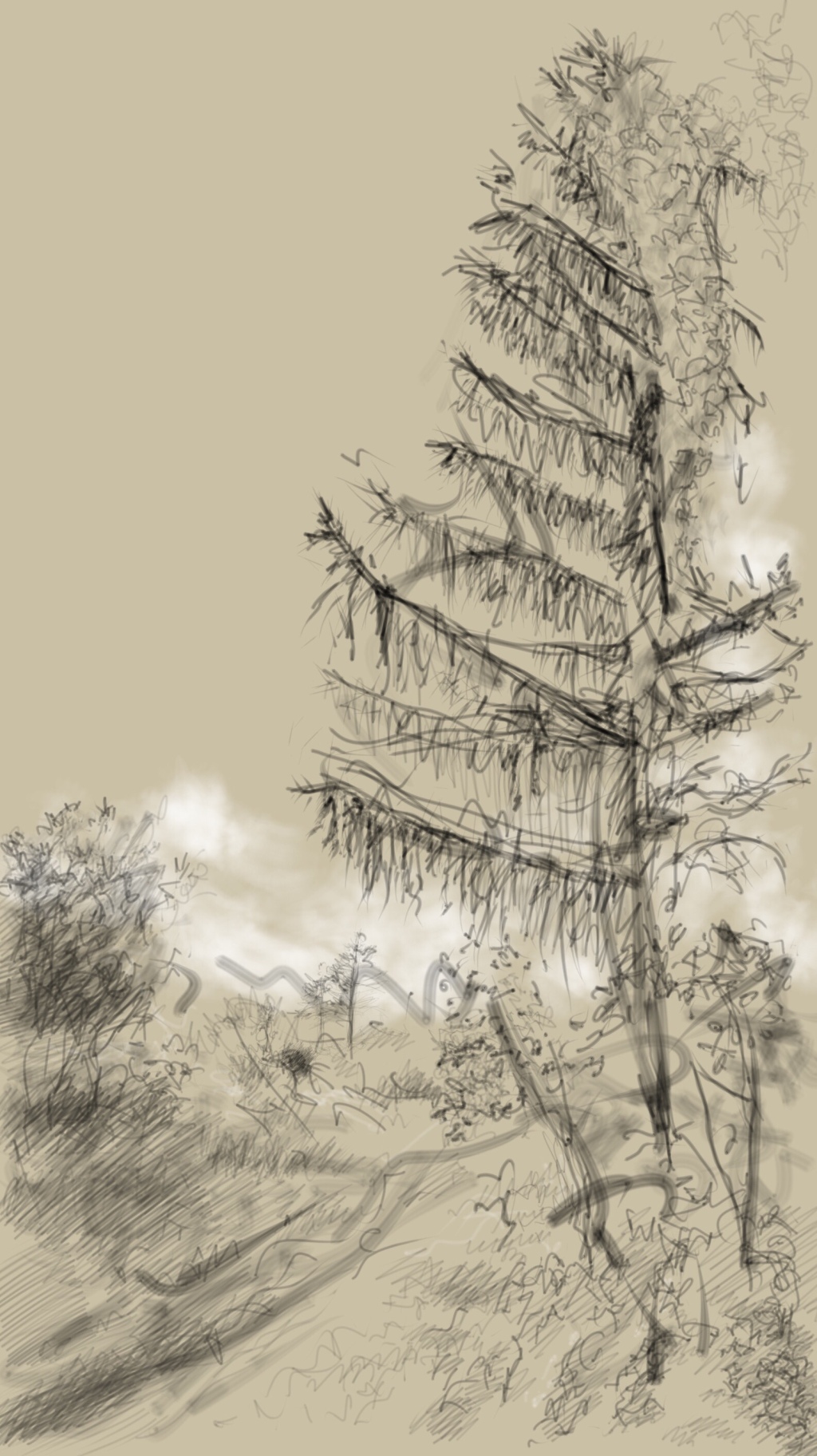
Osiedleńców, 10 November 2015, Autodesk Sketchbook on LG G4 mobile (cell) phone

Juliana Falata, 10 November 2015, Autodesk Sketchbook on LG G4 mobile (cell) phone
Ends
…
…
#mikgodley #drawing #contemporarydrawing #contemporaryart #contemporarypainting #painting #art #ipadart #vectorart #androidart #phonedraw #hiddenhistory #anglogerman #silesia #schlesien #germanhistory #hiddenheritage #conceptsapp #autodesksketchbook #propaganda #walbrzychmausoleum #wałbrzych #google #streetview #archeology #documentary #history #historyart #ipadpro #niederschlesien #dolnoslaskie #slask
Visualising the Network
Audio discussion of my recent exhibit in “Visualising the Network” at the Moss Gallery, Wollaton Street Studios, Nottingham UK – and despite it being my voice, it doesn’t sound too bad!
https://arttheoryreadgroup.wordpress.com/visualising-the-network/mik-godley/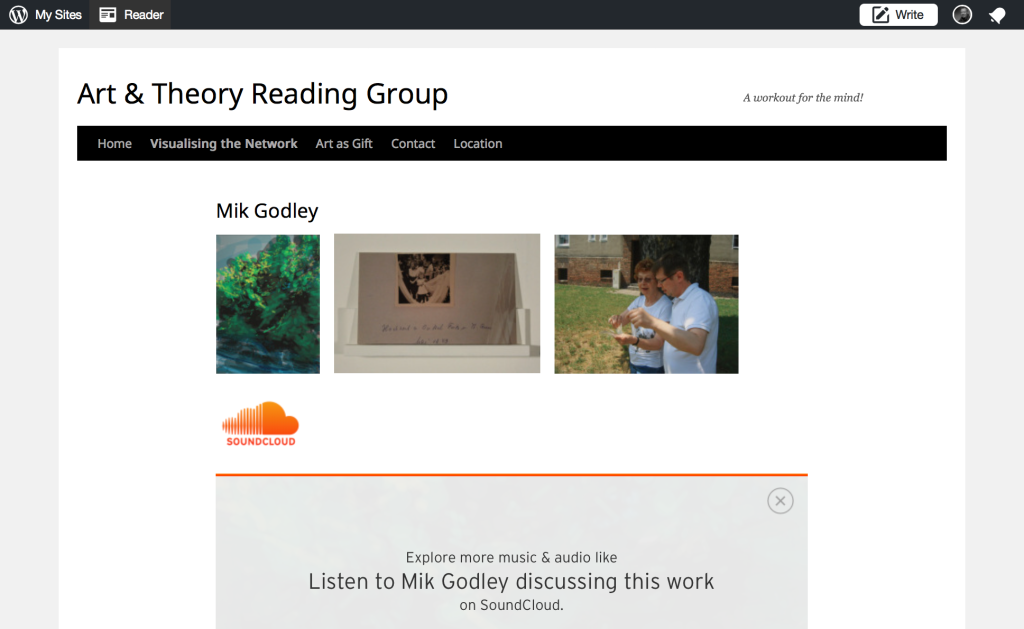
Grappling with Concepts
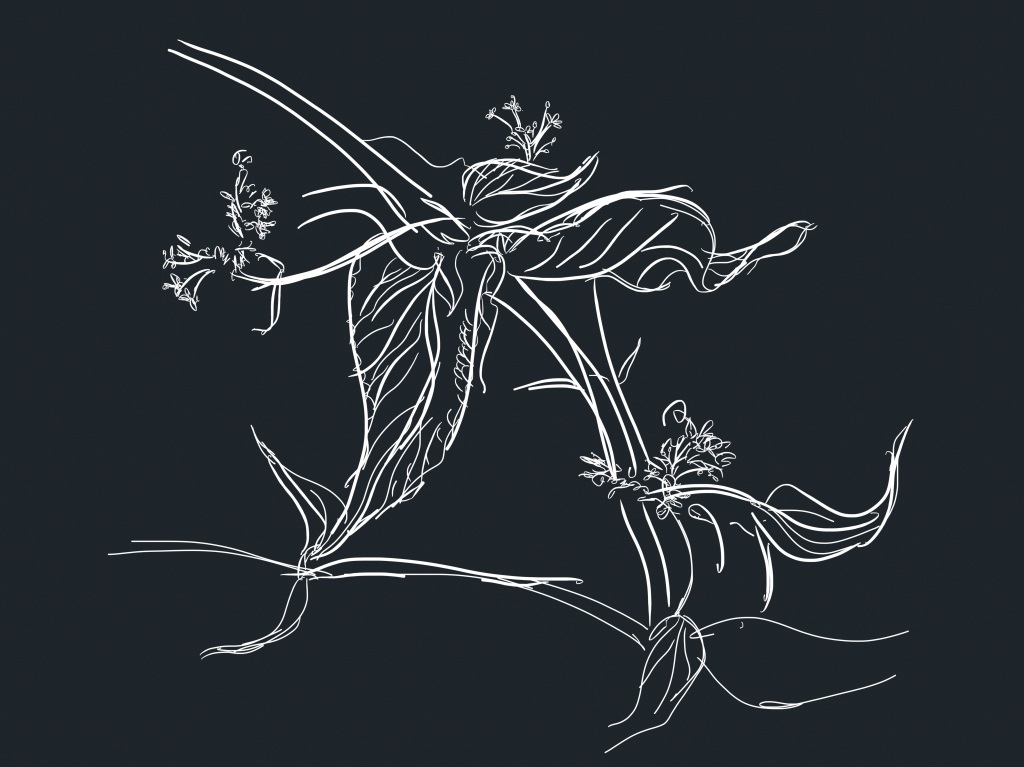
For a field study project I have in mind I want to test the possibility of using iPad vector drawings with laser cutters to create woodcuts or wood engravings, having used vector apps for several years on an old iPod Touch and a couple of iPads. But now having finally got a big iPad Pro most of my old vector apps haven’t been re-configured for the Pro so I had to try some new ones.
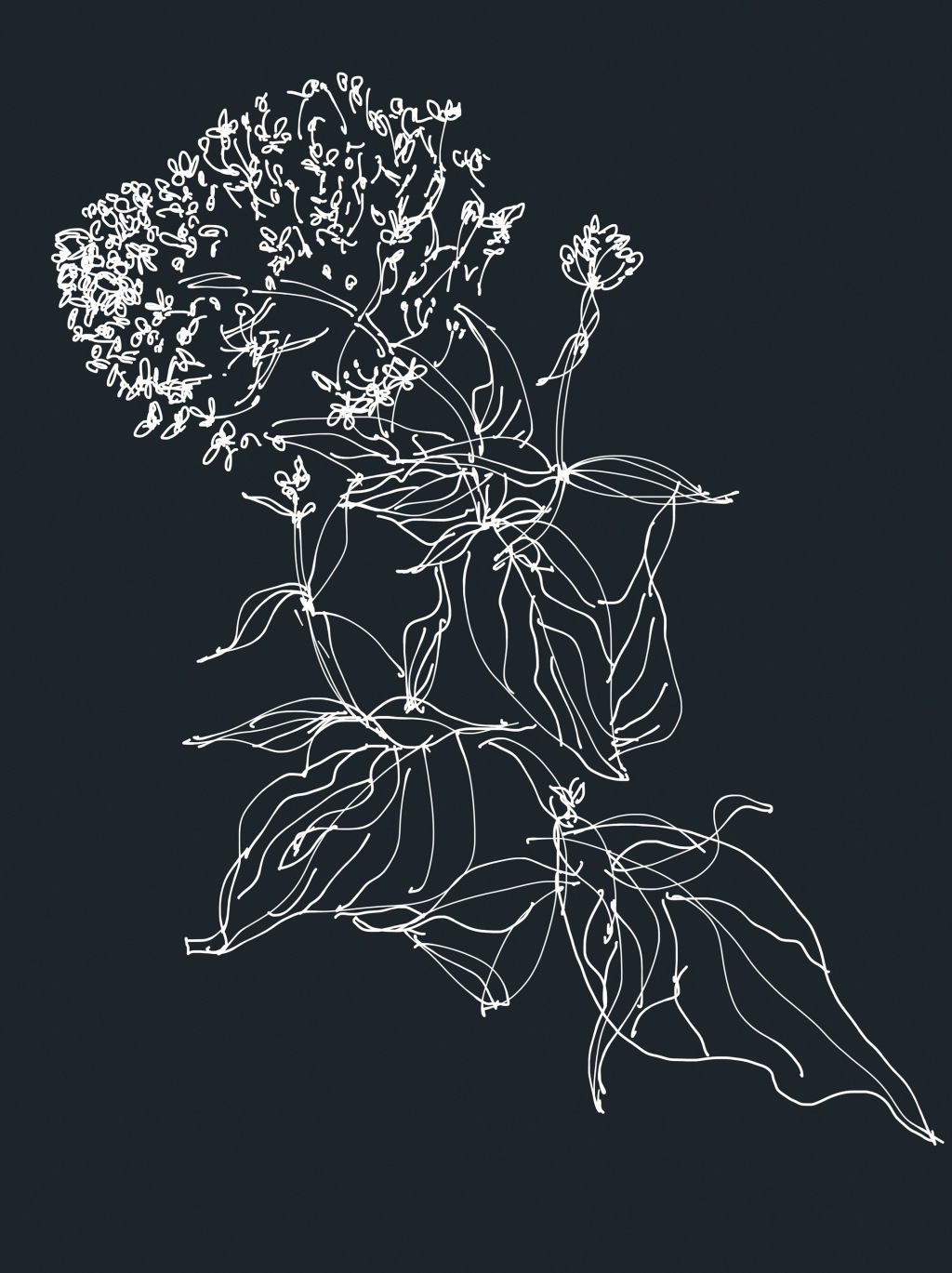
Testing Concepts as a vector app to draw towards woodcut printmaking, I discovered that the Fountain Pen “brush” most appropriate for the appearance of woodcut lines didn’t fully support the Apple Pencil (which I’m also learning how to use) so I couldn’t control the thickness of line, often have to re-draw lines several times or else tweak the position or length after drawing by “transforming” individual lines, so that very intense concentration was required to get a drawing of relatively few lines right, though I gradually improved over about a month of use.

I did try Adobe Draw (a kind of Illustrator lite — but this only offered a white background: I wanted black) and Autodesk Graphic for this job but didn’t like the equivalent brush, the way that the app over “smoothed” every mark (a problem with the Concepts Pen brushes but less so: whose drawing is this — the artists or the apps?) or the “user interface”. Probably fine for the designers well practiced on desktop programs like Illustrator that this app was built for; these vector apps have lots of whistles and bells that I don’t need and the UI often gets in the way. I just want to draw and then use the vector file to print from.

So I got in touch with Tophatch, Concepts developers, through their Facebook page asking if they had plans to make the Pen “brushes” respond to the Apple Pencil, giving a link to the drawings I’d posted to show what I was talking about, and also posted some of them on Instagram using the Concepts hashtag.
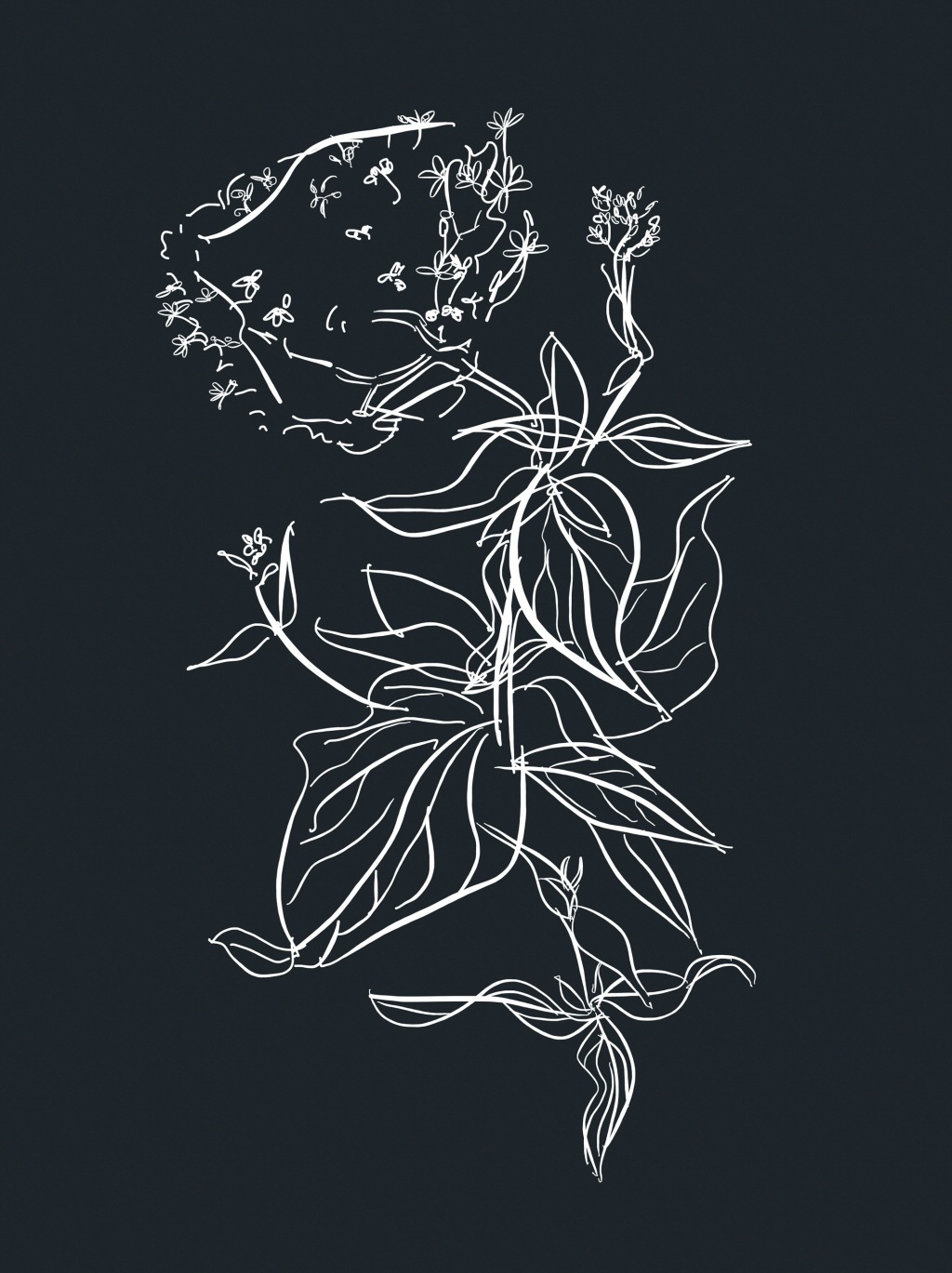
The response from the Tophatch Communications Director was “they are gorgeous!” asking if they can “share along your series of sketches with our community” and wanting to keep in touch about how they print. “On the laser engraving, I realize this is new for you, but if you wouldn’t mind keeping me posted on your process… this is exactly the type of application we’ve intended for Concepts, and our team would like to see your progress and hear your feedback as an artist.”
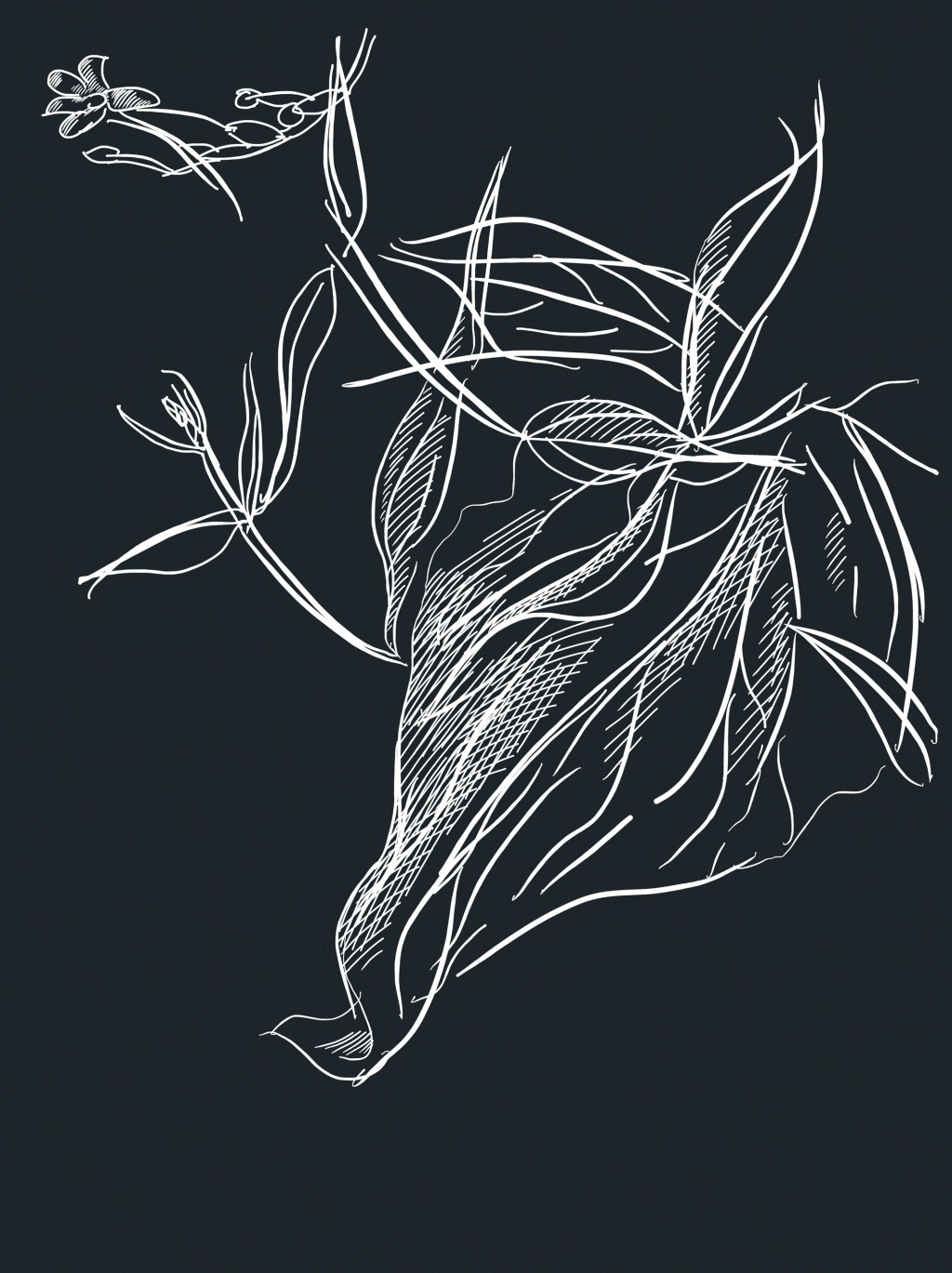
Fine, I’m happy to help, but it’s the summer holidays and the technicians at the art college will be off, so no laser cutting or printing for now, it will have to wait. Besides, I had a long list of things I needed to get on with before teaching starts again, including getting back to “real” painting which I haven’t had time to do since last summer (these days the underpaid over-demanding day-job is killing my art!)
Oh, and I’ve since found out from their Facebook group that the Concepts developers are working on the Pen issue.
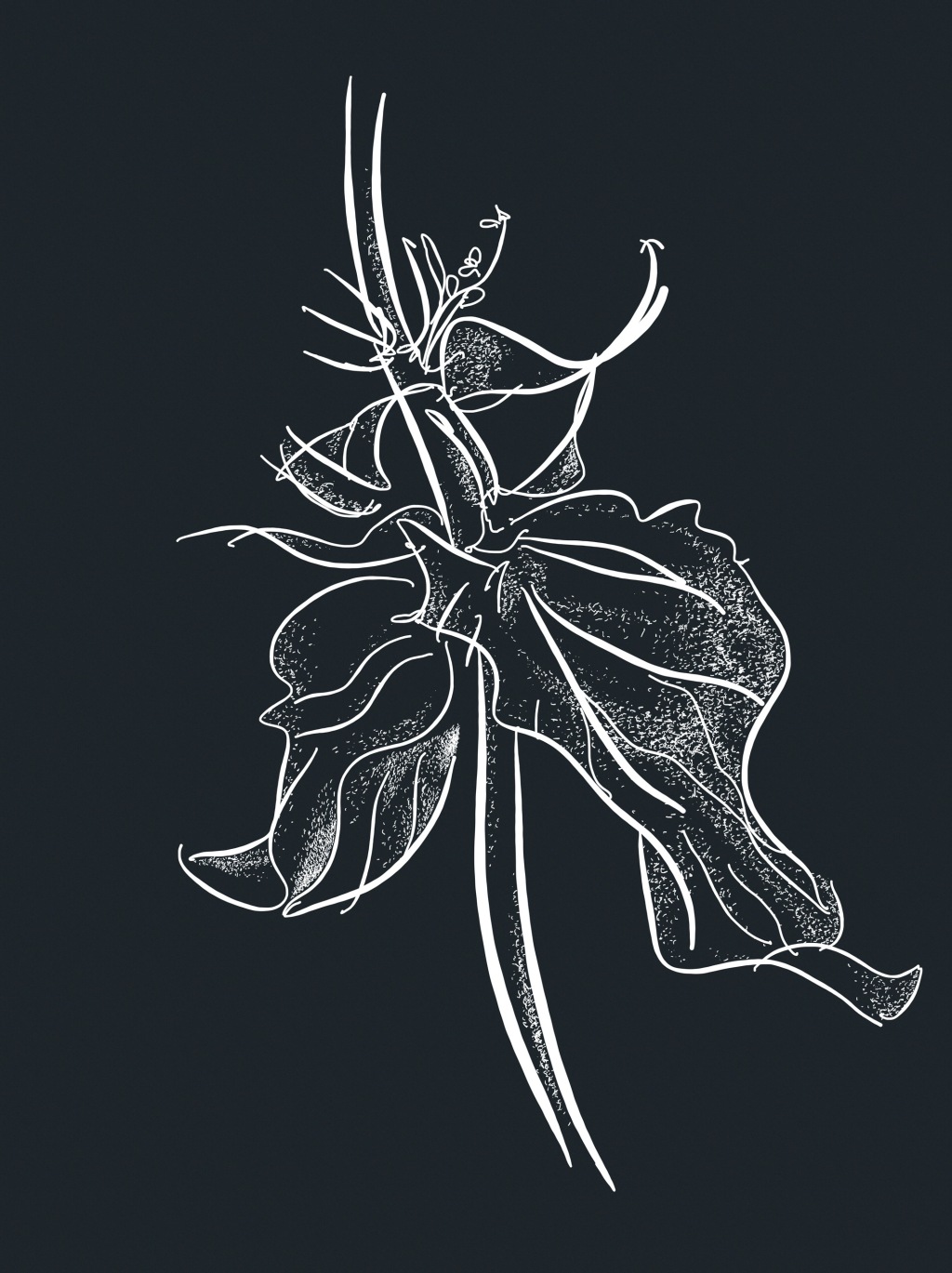
So next I thought I’d test Concepts for more conventional drawing, beginning technically very simply by using a fixed width “pencil” brush in black, then white over a mid-to-dark toned ground. I’ve always found it easier to get to know an app — or anything else for that matter — by starting as simply as possible, gradually testing functions cumulatively so that I don’t get lost, wondering how on earth I did something. A few days before I had discovered a set of Google Sphere View postings on Google Maps of the Wałbrzych Mausoleum, a ruin that I’ve been surveying online for my project Considering Silesia for several years. These Sphere Views were photographed in May of this year (2017) so are very new. I thought that Concepts property of enabling an endlessly add-able “infinite canvas” might offer possible ways of ‘documenting’ with Sphere Views’ all round 360 degree panoramas, offer ways of exploring an equivalent way of looking to panning around and zooming in and out on the computer screen, continuing my investigation into our digital “ways of seeing”.
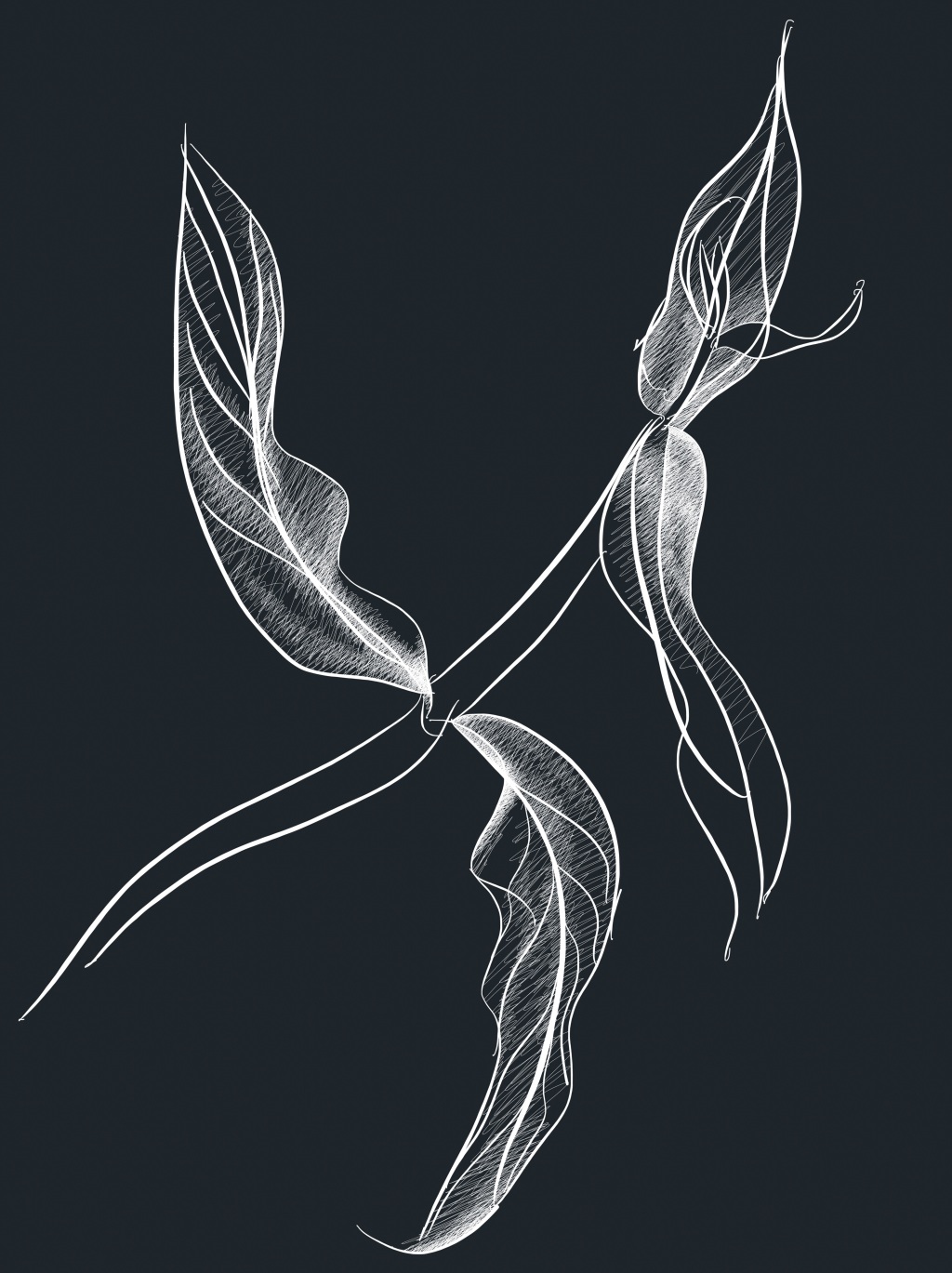
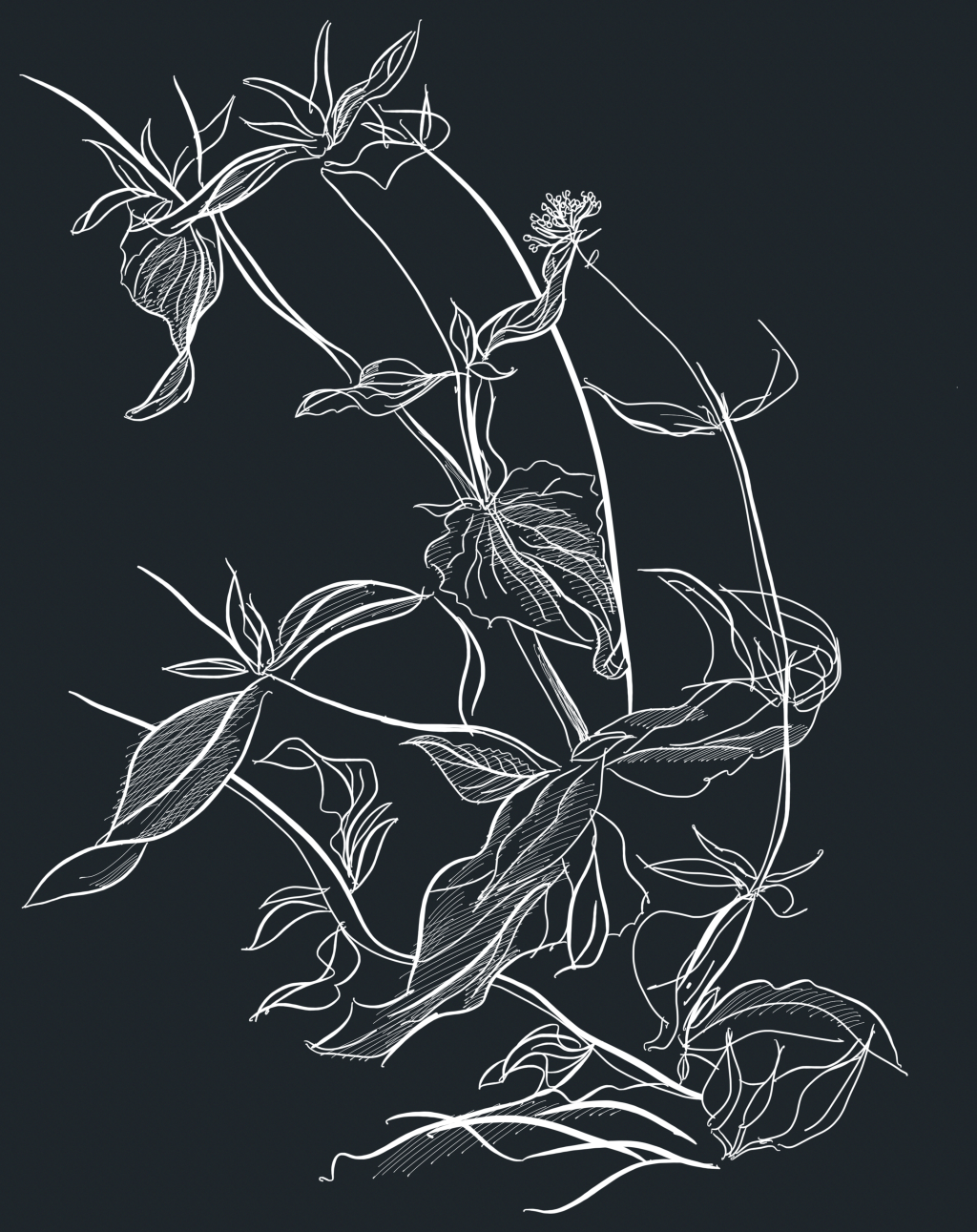
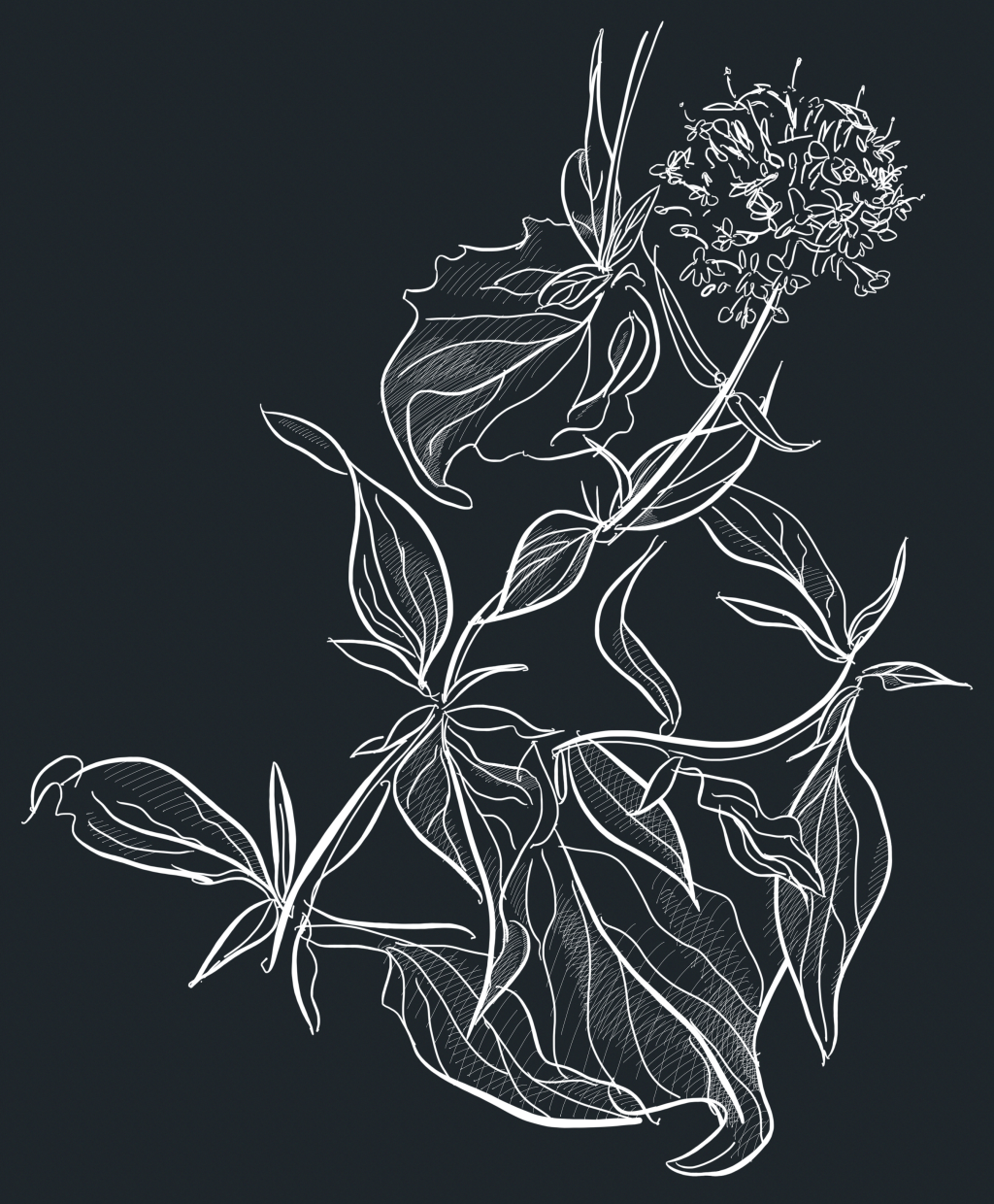
First I had a day out to do some teaching prep in Sheffield galleries including the Ruskin, whose drawings I really enjoy, so did a couple of sketches using Concepts after the Graves Gallery closed earlier than I expected, before visiting the fifth annual show by the Tenderfoot group of our ex-students, now confident graduates of Goldsmiths, Edinburgh, etc., and then also on the train home. I started again in the studio the next day, but I think seeing the Ruskin drawings had a bit of a hangover effect.
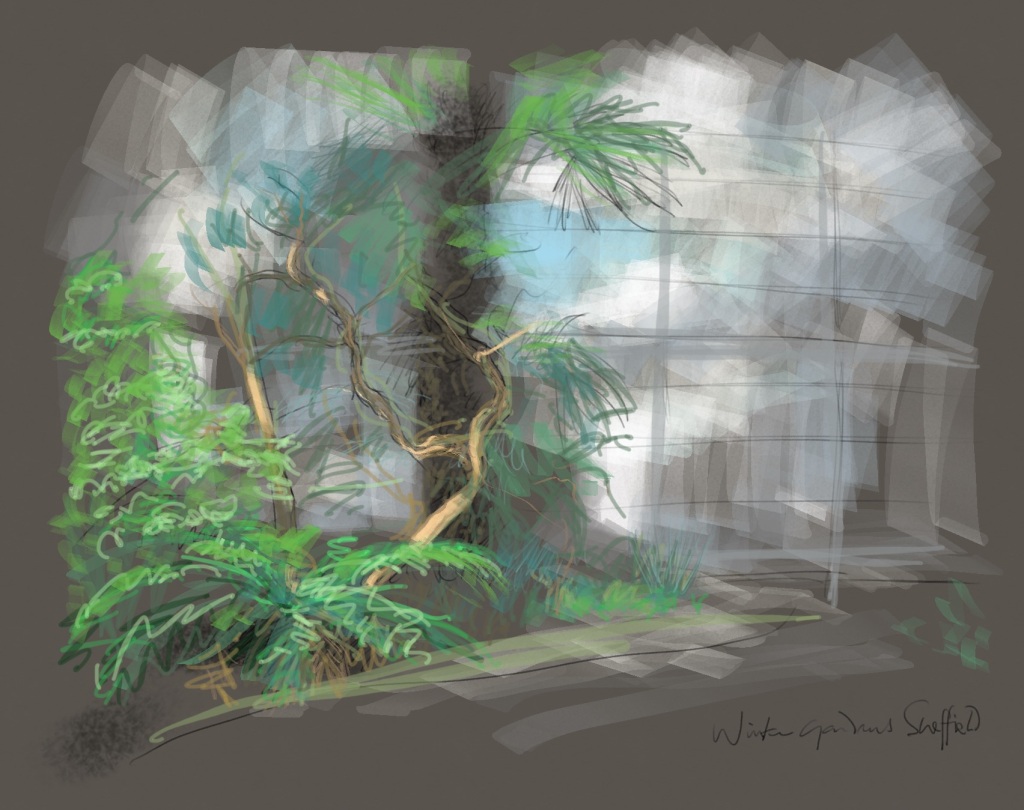
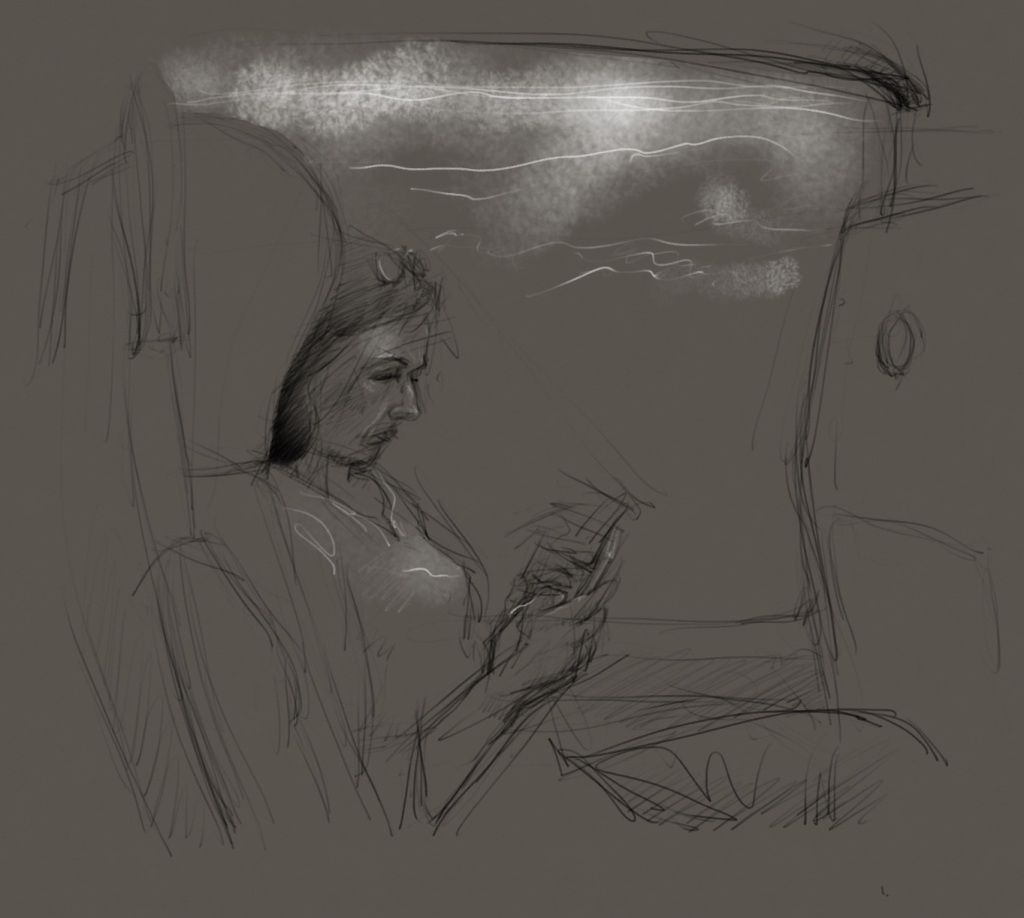
The first test drawing seemed promising, though about half way through the three day process I realized that I should have started with a rough overall sketch (again remembering what I teach rather too late!) to get a better idea of the changes of perspective — initially I had been too focused on seeing how the quality of marks I could make might effectively render the image. And then on day three I wondered if I might come across the internal memory limit I’d hit with the other vector apps I’d used on older iPods and iPads — years ago I eventually discovered that the limit of one such app was 40,000 “instructions”. Probably not a problem for most artists, but one I’d hit several times, sometimes having to duplicate drawings at later stages and find ways to re-draw them from earlier stage duplicates with fewer “instructions”. Anyway, I didn’t come across the limit on the first test, so we’ll see.

The next day there was an app update from Concepts which considerably added to the capabilities of the Pencil “brush” I’d just been using and the eraser, so I spent a while playing with those.
My next effort sadly failed because, although I started with an overall under drawing (in red), along with my inexperience on the app I haven’t yet worked out how to “interpolate” my movements around the Sphere View images. I do need to spend more time focusing on this. However, I need that app experience first, so I kept the following drawing simpler — just one perspective and no moving around.

I began again with a straightforward view, indeed I worked from a screen shot of it over the following days as I hadn’t moved perspectives at all, did a light sketch then began to work into it just using the new Soft Pencil brush in black over an ochre ground, gradually adding more detail and tone in two layers — the first at 100% opacity and a second at 28% for lighter tones, only starting the high-lights in white (one layer at 100% opacity, then a second at around 30%) on the third day.
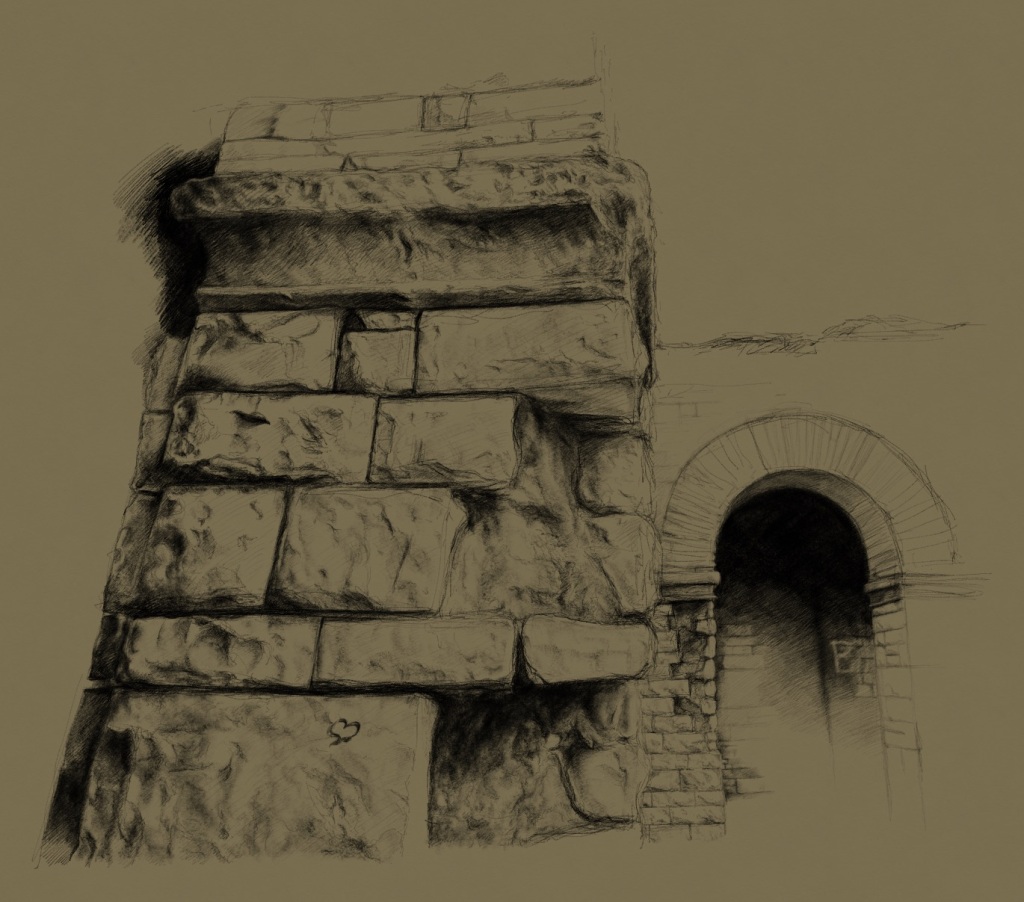
One thing that I was very pleased about was that as the drawing developed I realized that I’d drawn a small section in the wrong position, so I just picked it up and moved the whole section slightly to the left. No having to erase and redraw — result!
I did get to a point towards the end of day three on this drawing when I felt that the app was slowing down (there was a bit of lag after drawing lines and zooming in and out) having spent a lot of time and “instructions” as hatching on the sky, so perhaps I was coming close to its internal memory limit, but I will probably push against this on future efforts. I need fully worked drawings to exhibit, not just sketches. That’s why I’d bought the iPad Pro.
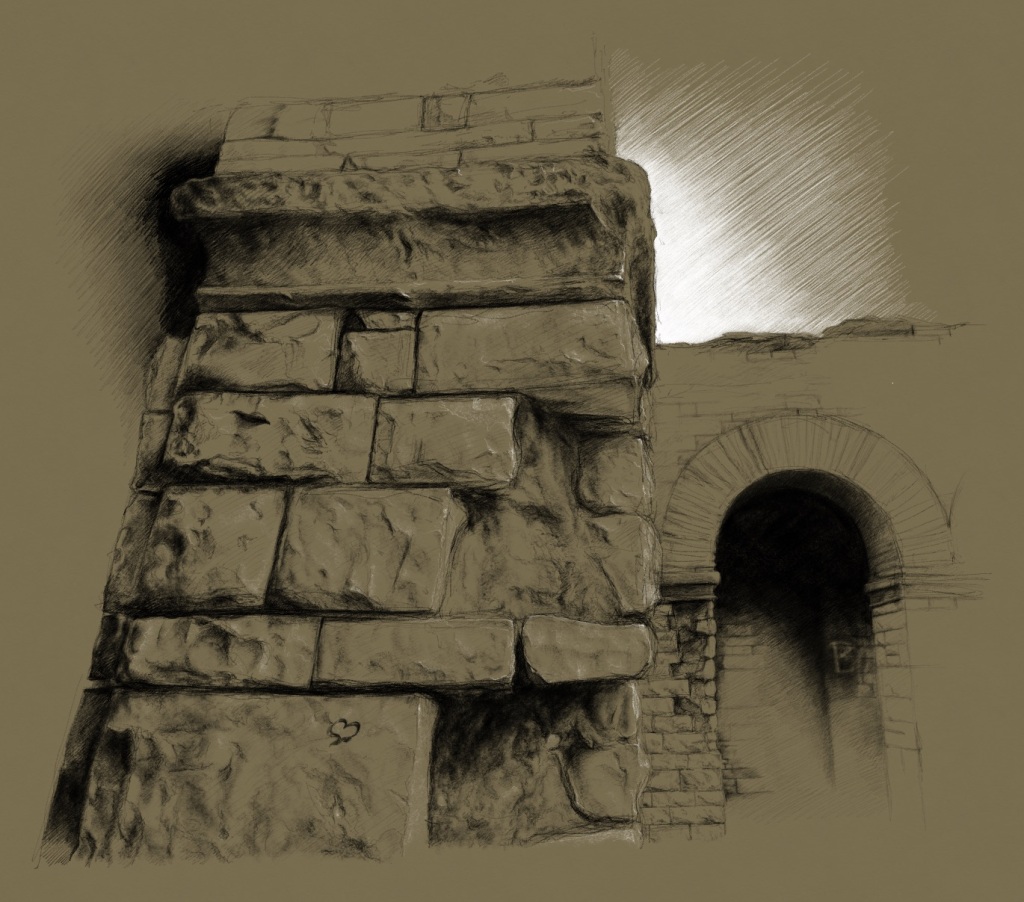
The fourth drawing, on a dark pink ground, followed much the same course, though I felt I gained a little more control over the Pencil. I realized that I was able to make lines of a medium thickness to add to the narrow and broad, though I haven’t yet fully grasped a good range of thicknesses.
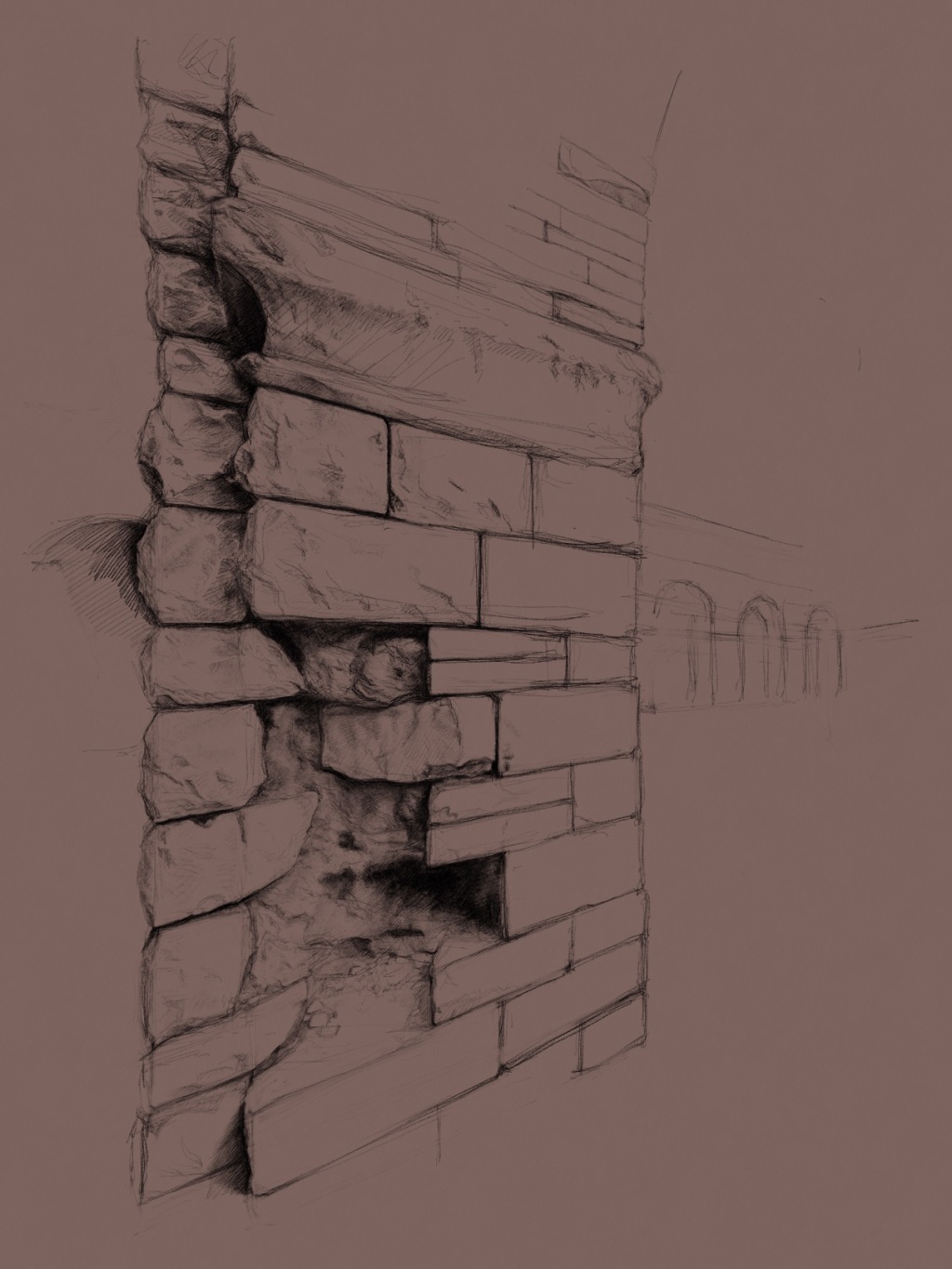
I find the limited colors available through the Copic system rather unusual, though designers will be familiar with it, but it may have benefits when the work goes to print — I guess the printers will be able to read the colors from the files. Once again the app slowed later in the drawing, not helped by the Pencil running out of charge, adding time to the process. However, that did show me how much more accurately I could now draw with the Pencil than just my finger, so I’ve evidently made progress.
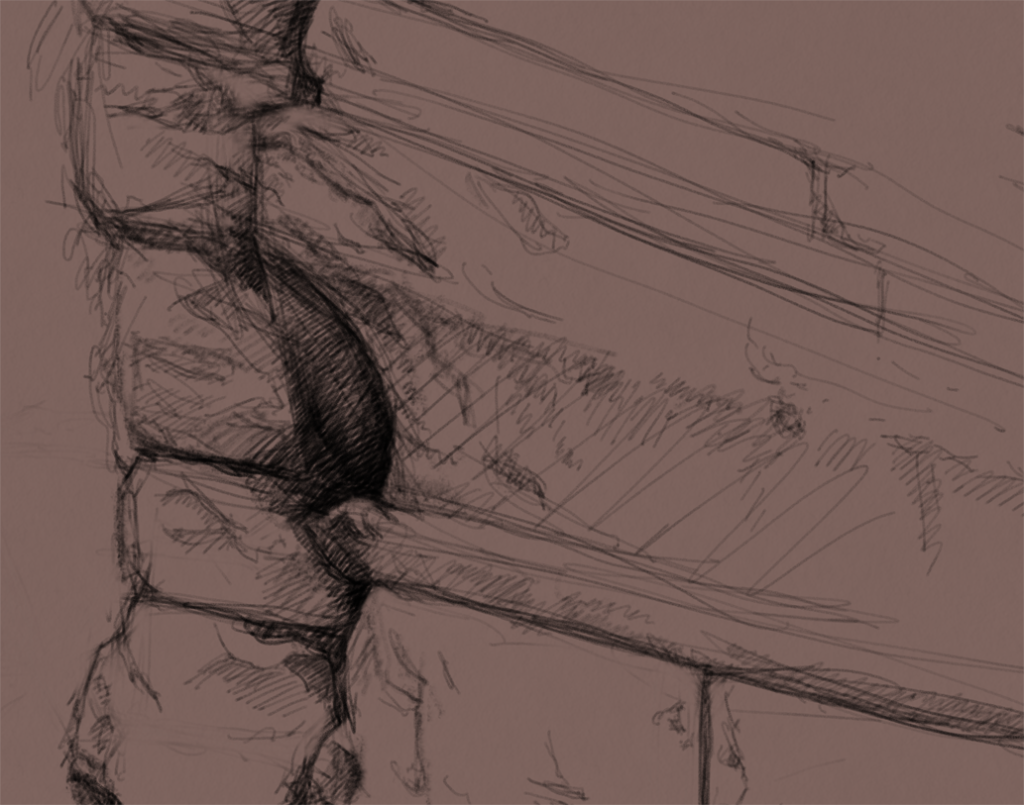
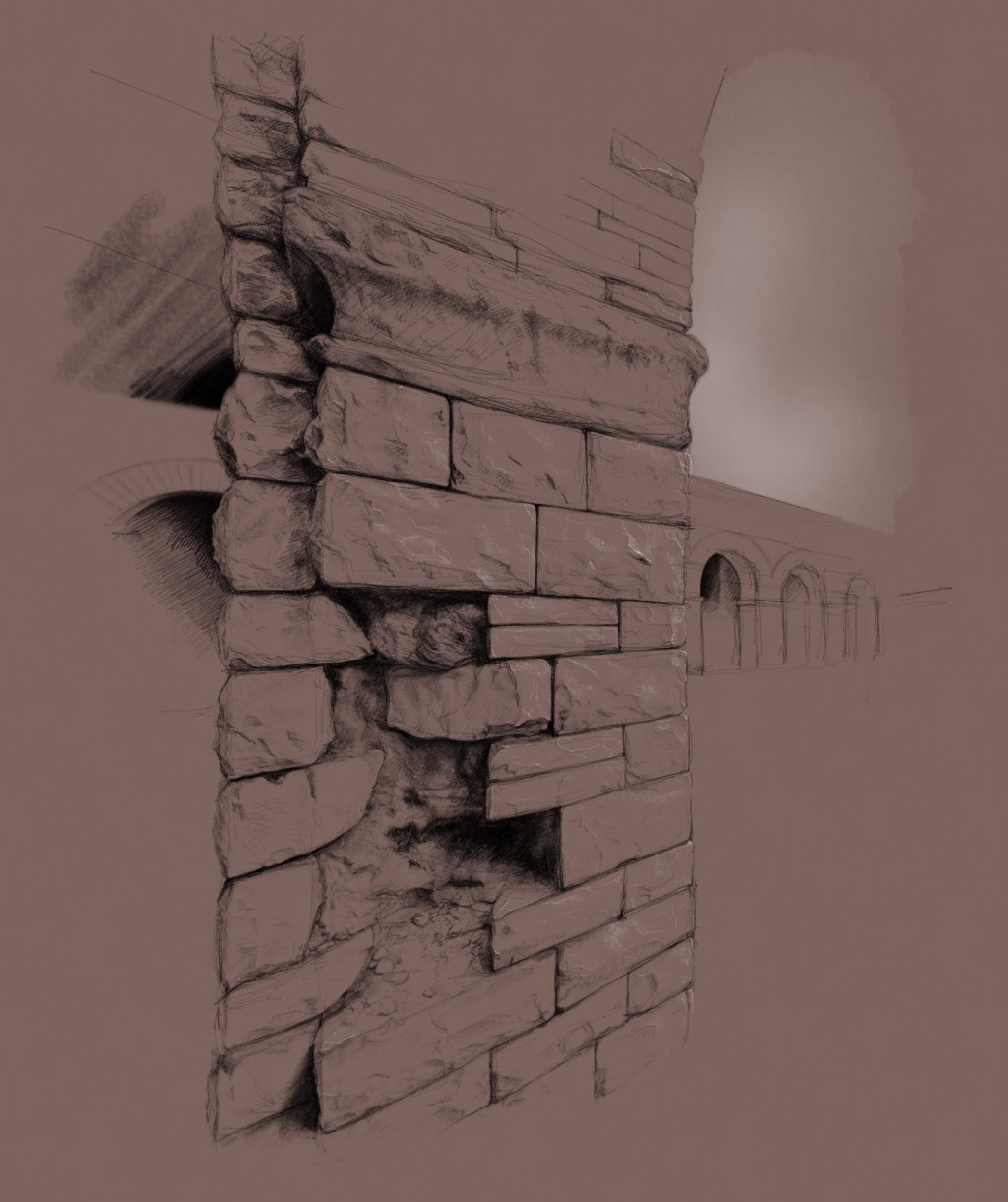
I’m a long way from being in full control of the Pencil, still using it rather crudely, but to create lighter lines and areas I simply reduced the opacity of some of the layers. However, Concepts’ new “soft eraser” is amazing: as well as erasing it allows you to reduce the opacity of lines or areas really very subtly — knocking back just as you would a real drawing with a good rubber or a brush or tissue. This amount of control in a vector app is tremendous — this is the kind of control it needs to give its Pen brushes.
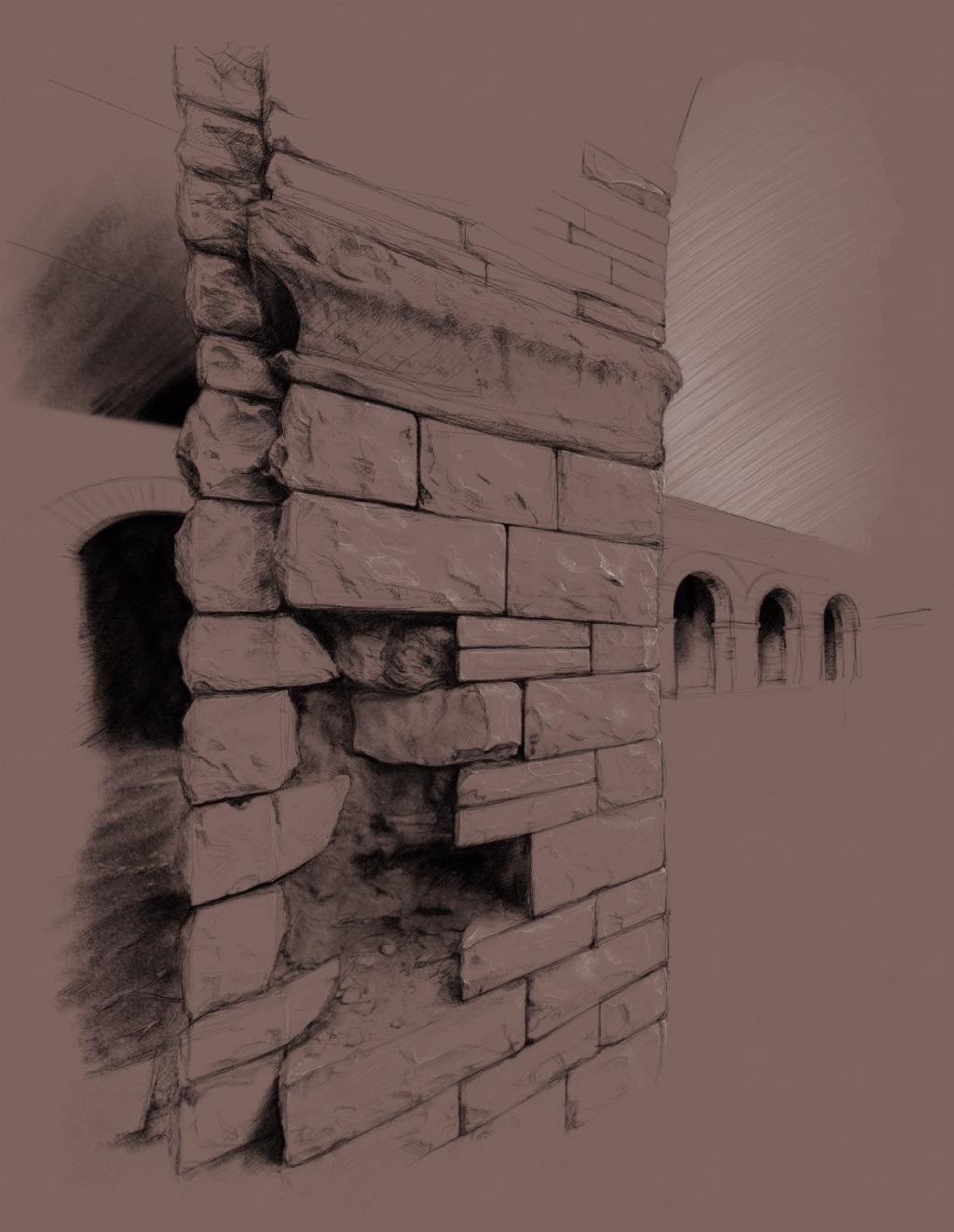
Will I actually get round to doing any proper painting before term starts?
Mik’s Considering Silesia Newsletter – November 2015
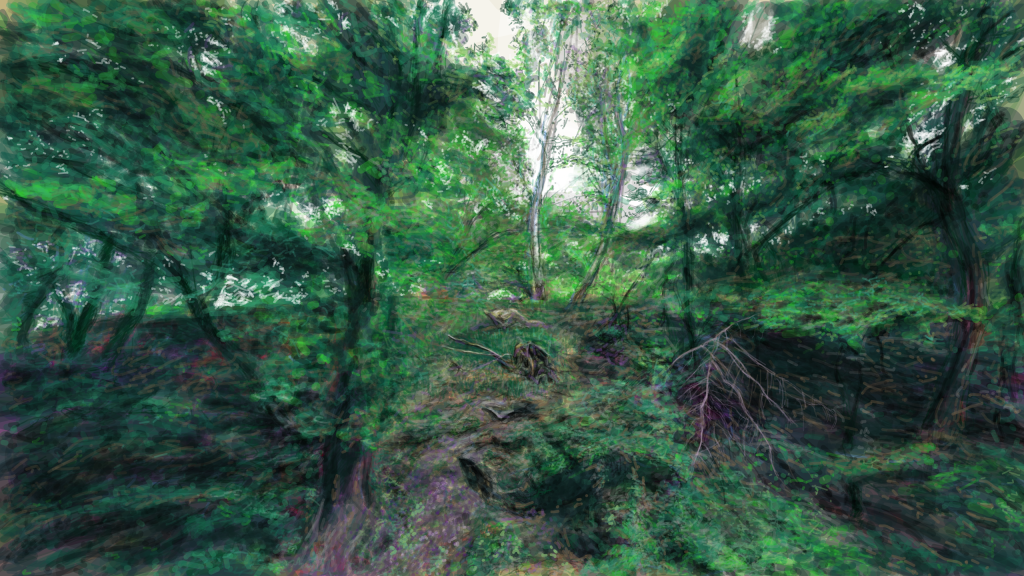
25 Słowicza, Wałbrzych, Lower Silesia, via Google Street View, 27 July 2015 – vector app Paintbook on iPad2
This drawing took several days to produce: it’s quite a big file created at 9×16 proportions with the aim of printing at a large scale – about 4 x 7 feet – so there is enough detail to look at close to
It’s three years since I last wrote a newsletter, so I guess this is well overdue, but I’ll just give the highlights of what I’ve been up to: –
The big news is that I am currently working towards a large solo exhibition creating a ‘digital survey’ of a ruined Silesian Nazi Mausoleum for the gallery newly built at the Attenborough Arts Centre of the University of Leicester. This new work will be a mix of painting and digital work, the most ambitious element of my project Considering Silesia, begun in 2003, but the show won’t be until 2019 at the earliest. Focussing on iPad stuff and work on paper until I can raise funds for more substantial materials, it’s looking good so far but I have big plans!
Indeed, I’ve now focussed almost exclusively on iPad work for over a year for all my work: it allows me to create even large scale work relatively quickly (no waiting for paint to dry) testing ideas, and – until printing – is cheap and without storage issues. I’ve had a number of top quality archival giclée test prints done at John E Wrights, with the expert guidance of Adrian Nicholls, and even entered my favourite iPad painting into the national John Moores Painting Prize competition – unusually, the rules don’t say “no digital” – so wish me luck!
As if Silesia
My before-going-to-Silesia field studies have been enormously assisted by a series of commissions from City Arts / Creative Quarter (funded by EU Regional Development Fund), First Art and Wash Arts (both funded by Arts Council England), Staffordshire University and Nottingham Castle. These field studies are a training programme of tests, experiments, and thinking for when I eventually go to Silesia – perhaps a bit like Turner in the Alps with an iPad? Begun originally in Heanor and Codnor, I am happy to be asked to go to other places, meet other people. A recent review of iPad landscape sketches at the Lace Market Gallery said: –
Mik Godley’s drawings of scenes glimpsed from buses in north Nottinghamshire and Derbyshire are the dominating feature of the gallery.
Godley has become one of the best, and best known, exponents of drawing using iPhone and iPad apps in the region and this work ably demonstrates that his drawing talent is just as expressive on a screen as it is on paper or canvas.
Mark Patterson, Nottingham Post, January 28 2015
Last year’s interview with Kayt Hughes in Left Lion also gives a good overview: –
http://www.leftlion.co.uk/articles.cfm/title/mik-godley/id/6780
As well as East Midlands Visual Arts Network feature “Meet the Artist”: –
http://www.emvan.net/content/meet-artist-mik-godley
A City Arts commission for Light Night generated terrific public feedback, a feature on BBC East Midlands Today, interviews on both NottsTV and BBC Radio Nottingham and local press coverage. You can see the BBC feature on my YouTube channel here: –
East Midlands Today posted an “out-takes” video clip on FaceBook that had over 4,000 views in just two days, on top of the thousands of TV viewers on the night.
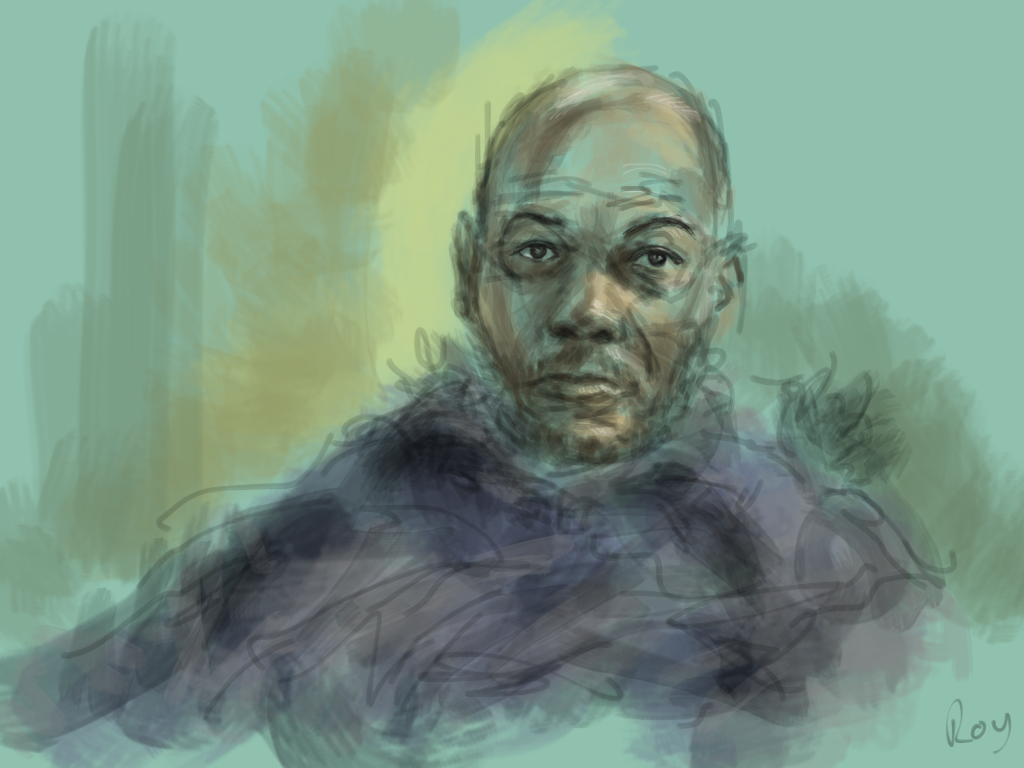
Roy from the Greenway Centre, Sneinton, Nottingham, for City Arts and Night Light.
App Bruishes on iPad2
Now I’m working on new (second!) commissions for Wash Arts – “Unexamined Lives” a project to investigate 20th C heritage of Borrowash near Derby, where I’m under instructions to visit the local pub. I’ve just done a series of drawings documenting Mansfield’s Christmas Lights Switch-on ceremony, again for First Art, and City Arts have also asked me back to create a series of portraits of “older people in care” for the Imagine project and next years Light Night festival – which could be seen as training for a proposal I have to meet any remaining WW2 refugees of former eastern German states who settled in Chicago en masse in 1953, if I can raise the money.
Last year I finally began looking at the controversial subject of post war recriminations and expulsion in former eastern German states in a presentation at PRIMARY. “Document Sudetenland” was a test installation of iPad and smart-phone prints, paintings of dying German soldiers from a US Army documentary film and charcoal drawing on tracing paper over a ten metre long mirror – people could see themselves in the gaps – with beer and German sausages for the audience. Laurence Ismay kindly created a short “trailer” video of the show which you can see here: –
I was very pleased that my Silesian portrait painting was published as the cover for “Representations of Flight and Expulsion in East German Prose Works” by Bill Niven (Prof. School of Arts & Humanities, Nottingham Trent University) by Camden House in Rochester, New York USA. An academic book, so not cheap, but I’m hoping that it will be seen by people that I might work with in the future.
Also on the academic front “Anthropology & Aging Quarterly” published a portfolio of portraits that had featured in “Winter Fires – Art and agency in old age” by François Matarasso, published by The Baring Foundation. Editor Jason Danely (Rhode Island College, USA) said “Ever since I saw Godley’s portraits, they have been lingering in my mind. He does with portraiture what a good ethnographer does with writing.”
I still have my much loved “day-job” (I think students are hilarious – most of the time – and teaching is an important contribution to society, though pay in Further Education is pathetic) despite the education minister telling students not to study arts and a halving of Art & Design Foundation students since the banking crash. So I must thank the many people who wrote letters of support during the redundancy fight – I don’t know what I’d do without this job – sweep streets perhaps? Indeed I have been presented with a Long Service Award of 25 years at Chesterfield College, which is going towards a new iPad Pro.
Realising the potential of an ‘entry level’ smart-phone to draw with for a couple of years, I’ve invested in a much larger “phablet” – basically a pocket tablet that I can make calls on. The new phone has a 5.5 inch screen that has as many pixels as my 27 inch iMac, so I’m now testing what I can do with this – it’s promising so far.
With all the activity on commissions, I did manage a few exhibitions too. (detail) curated by Andrew Bracey went to Bangkok, London & Lincoln, a show of the Light Night drawings at City Arts, a small solo show at Leeds University (see link below) and the aforementioned drawing show at New College Nottingham’s Lace Market Gallery.
PRIMARY continues to grow despite the scarcity of arts funding, but as a founding member having completed the maximum possible of nine years on the board of trustees (actually twelve years from starting) I am stepping down to devote more time to my work.
It’s been fun to see the press reports on the Silesian Nazi Gold Train – a long running “myth” – in Albert Speer’s “Der Riese” tunnels that I have been investigating, below the bunkers I painted. That should help bring a bit of attention to the project – especially if the Polish Army excavations really do find it.
I created a showreel of some of my best iPad and phone drawings for the show at University of Leeds, School of Fine Art, History of Art & Cultural Studies. You can see it on my YouTube channel here: –
P.S. The text link to YouTube shows at a higher resolution
Bill Niven – Representations of Flight and Expulsion in East German Prose Works
The book is out – two copies arrived at the studio today – thanks Bill!
http://www.camden-house.com/store/viewItem.asp?idProduct=14511
Park Traces – drawing conclusions
During Winter and Spring I worked with a group of Staffordshire University Fine Art students on a project to explore and document Hanley Park in Stoke on Trent through drawing. We had various drawing activities, both on site in the park, and within the Fine Art studios. The project was funded through the Staffordshire University Vice Chancellor’s Teaching Innovation Fund
We sat in silence on the bench just off our regular circuit, listening to the tennis players behind us, facing away so as not to make them self conscious. In a few minutes they built up a regular “womp” until one exclaimed “rally” in triumph – I got the impression these weren’t well practiced players.
Documenting the weekly changes brought by the emergence of Spring, I suggested one student try to record sound, so a second walk-through began by approaching the lake with its noisy geese and quieter ducks. This rare fine day had brought many more people to the park, and the cricket and tennis courts were pretty busy. The splashing of the fountains and waterfalls to the “crack” of cricket bats would make a great soundtrack to the many photos taken of repeated points along the way. Previously, other than the geese, surrounding traffic and the wind, the park had been quiet.
On the train to Stoke again, quite excited to be continuing this project despite it teaming with rain (again) at the moment. However, the forecast is good, and the clouds seem to be breaking. The first couple of Fridays on this project had been plagued by very bad weather, not fitting well with our timetable. But I can see blue skies up ahead – that looks promising.
Back in late Autumn a big old chap wandered over to us with his dog, telling us how the park was in his youth, a well kempt destination for social promenades, the centre of things with music and games, and boating on the lake. After a while the dog was impatient to be off, and we needed to get back to work, so he ambled along to tell his stories to another group of students sat on benches drawing the ornate bandstand. I suppose people have other entertainments these days, other priorities to spend time on, but then more recently seeing a bit of Spring’s good weather bring out the cricketers and dog walkers proved that there is still life in the park – in the very idea of a park, even if it has been sadly neglected and abused.
I’ve become quite fascinated by notions of ‘field studies’ and ‘documentary’ over the last few years, and its connection to my many years teaching observational life drawing. Perception and daily observation are at the core of visual arts, and though ideas tend to take precedence, looking and recording are how art education begins – even if the students don’t quite appreciate that yet, as they are often keen to run before they can walk.
And in these recent years of going out drawing, I’ve occasionally surprised myself by finding something genuinely new – something I wouldn’t have discovered otherwise, something that has taken my own practice into exciting new directions. Well, exciting for me, at any rate – even if my fingers have nearly frozen off! Hanley Park in early Spring is a good spot for that.
Oh, and I can recommend the local chippy – very good.
Though, I’m told I should have tried the pies!
These drawings were created with an iPad2 and various drawing apps, and a Samsung Galaxy S3 mini mobile (cell) phone.
Copyright: Mik Godley 2013 – 2014
Thanks to Anna Francis and Sarah Key, Fine Art, Staffordshire University
There will be a free drawing workshop in Hanley Park on Friday 13th June 2014 – follow the link for information: –
http://blogs.staffs.ac.uk/fringe/2014/05/09/park-traces-drawing-event/
(detail) opens in Bangkok
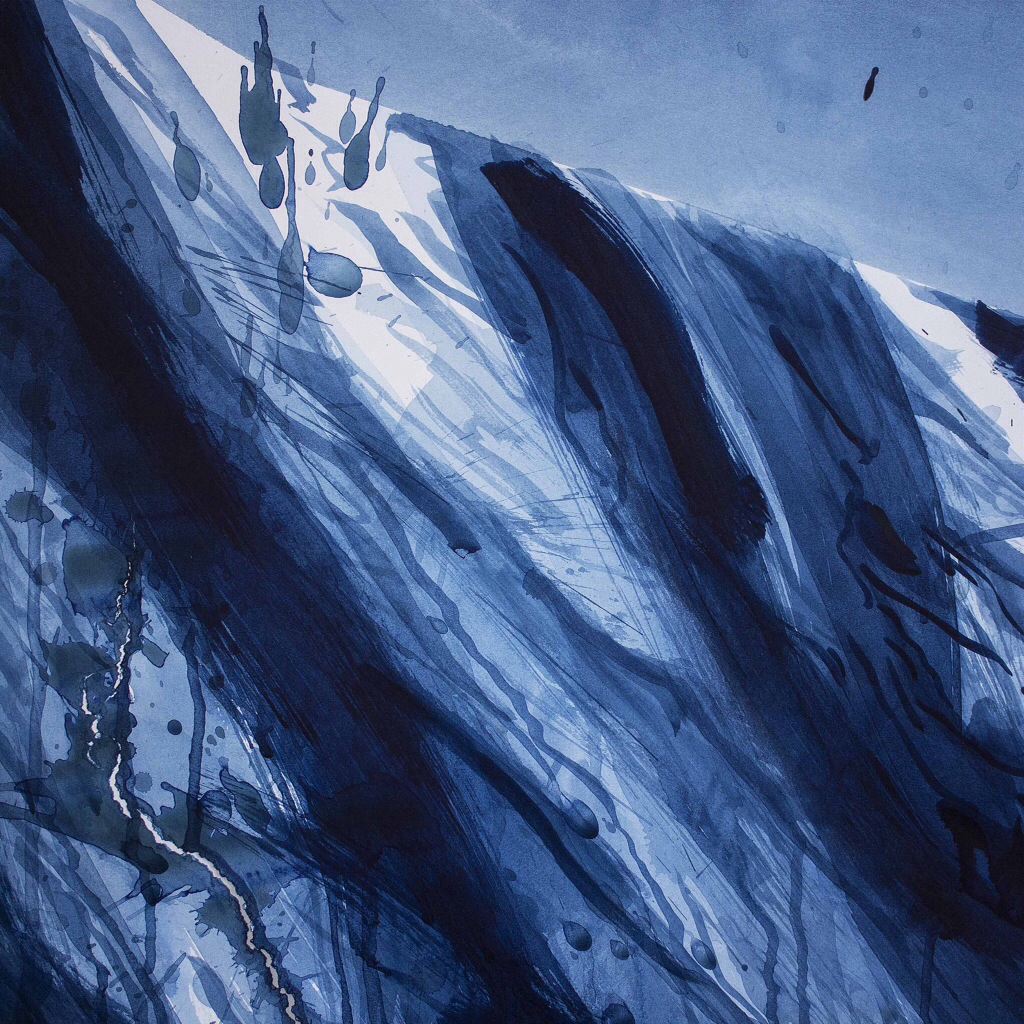
Andrew Bracey curated exhibition (detail) with 118 UK painters opens in Bangkok
See linked website for details
http://www.paintingdetail.com/
Hodmire Lane – Google’s Return
While working on several small Google StreetView sketches that I’ve currently put to one side, I’ve been looking at a pair of A1 acrylic monochrome sketches of bushes in Hodmire Lane made over the winter, thinking about making some larger paintings, possibly towards creating a new suite of works all based on StreetView images of the same lane. To be honest I’d been a bit frustrated by concentrating on small scale work for too long and stretched up some large pieces of paper to play with – I was keen to let rip.
I revisited the road on StreetView, and it seems that Google have too – the previous photos of late autumn or winter are now full of lush vegetation. So over a couple of days or so I collected several iPad screen shots while thinking about how to tackle them. At the same time a friend questioned my plan (to start by chucking a load of watercolour around) and I began to question it myself – these new images were very complex and technically would be pretty demanding – I needed to both get to know these new images and think through the approach I’d have to make: just chucking the paint on there probably wouldn’t quite do it.
I did start drawing out the basic structure on the largest sheet (about five feet across) but the day-light deteriorated (it’s been very cloudy) so I spent a couple of days drawing simple monochromes on my phone with the StreetView images on my iPad on my lap – sadly my iMac died over a year ago and I haven’t yet raised the cash to replace it. I think these sketches are beginning to help me think through what I might do and get to know the source images a little better. Mobile phone drawings are small scale, but at least I don’t have to wait for layers of paint to dry!
I think I’ve made a start.
Old Skool Break 8: From A Dizzying Height – “Document Sudetenland” presented at Primary with Rebecca and Katy Beinart
Over 10.2 metres long by 2 metres high, tracing paper covering mirrors, charcoal drawing on the tracing paper based on stills from a recently released Czech “home movie” hidden since 1945 of German civilians taken to a roadside, machine gunned then driven over by a military truck as part of the Expulsion of Germans after the war had ended. Beneath the tracing paper are eight acrylic paintings of dead or badly beaten SS soldiers filmed by an American Forces film crew documenting the immediate post-War Expulsion and returning German troops, the film published by the US Holocaust Museum. On top of the tracing paper are prints of iPad and mobile phone drawings produced on a recent visit to my parents, just outside of Hannover, Germany.
“Document Sudetenland” is a development of my project “Considering Silesia”, a story of “the artist” seeking his Anglo-German heritage in the context of our evolving relationship with new media – our digital “way of seeing” – focusing on “virtual” expeditionsto my mother’s homeland (a place I’ve never been to) and the very “analogue” response of painting.
In development since 2003 ‘Considering Silesia’ has been aided by an EU funded research degree at Nottingham Trent University and exhibited in:
“Counterpoint”, Platforma Festival, London; “The Bookmark Project”, Nottingham Contemporary; “Digital Canvas”, Autodesk Gallery, San Francisco;”Nazi UFO’s @ TotalKunst”, solo show for the Edinburgh Art Festival; “Penned” Artscape/Pinkard Gallery, Baltimore; “No Letters”, Nettie Horn Gallery, London; “in the echo of a shadow”, University of Leeds, with Henry Tietzsch-Tyler, for the conference “From Perpetrators to Victims? Constructions and Representations of German Wartime Suffering”; “When Men and Mountains Meet”, Museum of Contemporary Art Zagreb.
I was very pleased to get such positive responses to the installation both at the presentation, some verbally and a couple feeding back afterwards, and to the photos I posted on Facebook at the time (see below)
Considering Silesia – Document Sudetenland
Having seen Mik’s work over the last 15 years, including having a couple of works in my house, I am always intrigued by his new work and his thinking surrounding it. For the Old School Break Mik presented Document Sudetenland, a mixed media piece (including painting, drawings, digital prints and rolls of translucent tracing paper) that runs the whole length of a 10m mirrored backed wall. The large scale drawings at first appear abstract patterns, but on further viewing they clearly represent piles of dead bodies. Also part hidden by the tracing paper are paintings of dead and dying soldiers, that varies in their focus with the movement of the paper, which partly acts a shroud. Acting as a contrast to dead are the digital prints of portraits, landscapes and blossom covering the opaque paper… but do they or are they just the scene of the crime… having seen the video on Youtube suggests the latter.
Michael Forbes, 12.03.2014 (after attending the presentation)
Having seen much of the work involved in Mik’s Considering Silesia project over the years it was very interesting for me to see this latest development; ‘Document Sudetenland’ which formed part of the event ‘From a Dizzying Height’. The event involved an installation of work by Mik alongside work by Rebecca and Katy Beinart. There was a friendly and relaxed atmosphere and it was very interesting to see and hear about the connections between the artists’ work. The audience sat within the installation and shared a meal of food relating to the work while enjoying some very interesting conversations about how the themes relate to their own lives; this provided a rare occasion to openly discuss what can sometimes be difficult subjects. The event concluded with a joyful toast of vodka dedicated to an ancestor of our choice.
The installation of drawings and prints which Mik had created across a mirrored wall combined layers of images operating on varying scales which revealed their content differently depending on where the audience was situated within the space. The drawings on tracing paper over the mirror glowed with reflected light echoing the layers of watercolour paint used elsewhere in the installation. The open spaces between the lengths of tracing paper allowed the viewer to see glimpses of the watercolours of the dead soldiers more vividly; at the same time the viewer could also see glimpses of their own reflections in the mirrored wall as the drawings moved with the breeze. The artists’ talks during the evening event and the day time tour allowed me to learn about interesting periods of history from a personal perspective and helped me to consider the relationship between the genre of landscape and the issue of identity in a new way.
Sarah Jane Terry, 14.03.2014 (after attending the presentation)
Claire Swallow (via FaceBook):
Oh my god that is so horrible… but not so surprising which is why its so horrible I suppose. There are bits of WW11 that we don’t get to hear about so much in part because of what went on during WW11 but its important to have a full picture of the brutality that central/eastern Europe was immersed in both before during and after the war. If we want explanations or context or understanding we have be aware of the already brutalised psyches of that part of the word, not in apology of, but in the service of “never again”.Very powerful work Mik…
2 March at 16:22
Carol Ann Docherty (via FaceBook):
“I so wish I was well enough to see this. It looks and sounds so powerful. I love the layering, the time element, the historical aspect, the apparent innocence of place that can resonate with our senses, and; what seems as a personal aspect for you, or at least of your country of birth (?). The Holocaust was horrific. The murders of the German SS and civilians are equally horrific. When does hatred end and forgiveness begin? Did you manage to video it and the event?”
2 March at 19:11
Isis Wisdom (via FaceBook):
Ya, now I get the tracing paper and that really works as an installation, Mik! nice. powerful. gets at layers of history/memory and processes of encoding both, including the technology that aids in this. So was this a room full, all the way around? It needs to be…. ))
22 April at 13:27
Mik Godley:
Isis Wisdom – thank you!
A roomful would have been good, Isis, but this was a ‘test’ of the idea – and very useful in that respect. The piece covered a 2 x 10+ metre long mirror along one wall – the idea of being aware of yourself in those layers being part of it – the building had been used by a dance school before we got hold of it.
I was tempted to use Arvo Part’s “Spiegel im Spiegel” as a sound track for the opening event – in the end I served German beer and sausages (though had planned Silesian sausages!) as part of a meal – a bit more conducive for an opening party – I didn’t want to scare people too much
The work was meant to be more developed than it ended up, I had booked the space for a month, but day-job issues and the studio’s decision to renovate the ceramic floor during my month meant that I only got a couple of weeks.
Still, it was a worthwhile experiment, and if I get the time and space to have another go, I know more about how to take it, what changes to make – I didn’t get time to play around with the compositional aspects, although most of the research and thinking had been done over several months before starting.
The starting points were a couple of videos that I’d seen on YouTube – one quite well known created by a team of American GI’s in the chaos at the end of the war, documenting retreating German troops – the paintings behind the tracing paper are of SS troops attacked and left dead or dying by the roadside, posted by the US Holocaust Museum. The second film is a ‘home-movie’ only recently released – hidden from the Czech authorities (despite their asking for it) and released by the film-makers daughter, if memory serves.
When I get a bit of time I’ll write something up about the project and post it on my blog. In the mean time I’ll dig out the YouTube links so you can see for your self.
22 April at 15:03
Mik Godley:
http://www.ushmm.org/online/film/display/detail.php…
“Steven Spielberg Film and Video Archive– Liberated Czechoslovakia; wounded and dead Germans; POWs
22 April at 15:09
Isis Wisdom:
Ya, would be interested to see the video. Ah, you just posted it, will look a bit later. Yes, got the sense that the ptgs were German troops. Mirror is even better. You have an excellent installation here Mik for a medium sized gallery/project room. Get a grant, make it happen. Add the audio. It’s interesting to have to track through, and process through, the technical layers in the piece, and deal with them as “drawing”, “painting” and then with how they function moving seamlessly back and forth through them. Just do it! ))
22 April at 15:11
Mik Godley:
Here is the second – it has been posted a few times by different people, each somewhat changing the context: –
“czechs execute german civilians in jun. 1945 Ethnic cleansing by benes and his henchmen
czech brutality against german civilians, czech savagery towards germans beneš called in May 1945 in Prague to completely liquidate the Germans in the Czech …”
22 April at 15:13
Mik Godley:
I’m not keen on infringing copyright as far as the soundtrack is concerned – I made the soundtrack on the ‘trailer’ by layering free sound effects from Apple
Anyway Isis – I’m not sure that anyone would give a grant to work on this subject matter – it’s a teeny bit problematic – even if there were grants for artists any more
22 April at 15:19
Photo credits: Graham Lester George & Mik Godley Video: Laurence Ismay
For further information: –
http://www.weareprimary.org/2014/02/old-skool-breaks-8/
I’ve also posted some more photos on Facebook: –
https://www.facebook.com/mikgodley/media_set?set=a.10152659274393312.1073741831.711293311&type=1